






At My Home Move Conveyancing, we get it—moving home can feel overwhelming and stressful. That’s why we’re here, to guide you through your journey and make it as smooth as possible.
We combine the convenience of an online service with the personal touch of a dedicated Move Specialist. They’ll take the time to understand what’s unique about your move and help you with your personalised conveyancing quote. Once you’re happy, we’ll connect you with a dedicated conveyancer from one of our trusted, CLC or SRA-regulated partner firms—perfectly matched to your needs.
Your Move Specialist can also help arrange a RICS survey and insurance for your new home, sort out removal van hire, and even assist with change-of-address services. And if your plans change, don’t worry—our no-move, no-legal-fee guarantee has you covered.
We know how important it is to have transparency and control over your move. That’s why all our partners offer online conveyancing journeys, so you can track your case whenever you like. Plus, our support team is here for you 24/7 via phone, email, and messaging services.
Thousands of happy movers across England, Scotland and Wales have trusted us to help them settle into their new homes. With transparency, care, and innovation at the heart of everything we do, we’ll make sure your home-moving experience begins with ease and ends with confidence.
Let’s get you moving!


Hi, it’s Martin Roberts - him off the telly! - welcoming you to the latest issue of Property & Home, your unmissable guide to buying, renovating, improving and selling property.
As the weather improves, we all start thinking of getting out there and working on our properties – whether it’s improving the outdoor space, constructing a garden building, improving our energy sources or upgrading insulation, the warm weather is the tie to get working. You’ll get a sense of satisfaction when the job’s done, and you’ll know that you’ve enhanced the value of your property.
If you are looking for a property to buy,
the situation’s a bit different – the ups and downs of the economy and politics don’t pay any attention to the seasons! But however unpredictable the market is, in my 20 years (and more!) working on Homes Under the Hammer, I have always seen opportunities for investment – and with hard work and some insider knowledge, it’s still possible to make the property market pay off for you.
So, whether you need advice on tax and finance, how to make the most of a property in need of refurbishment, or how to enhance your kitchen, bathroom or garden, you’ll find useful advice in this fact-packed issue of Property & Home with Martin Roberts!
In my end column you’ll find out how I have been getting on with my own property projects, and how I think redevelopment can pay off for communities as well as for investors. Whether you are at the bottom of the property ladder or are an experienced player in the game with a growing portfolio, the property business is still one where hard work and insight can be rewarded by financial and personal success!
Cheers, Martin


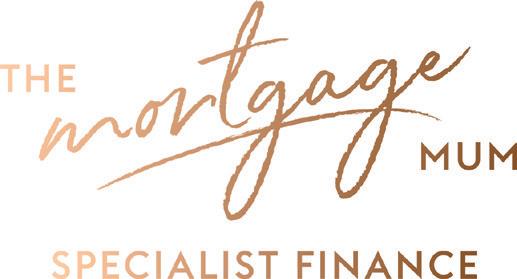




Client Testimonials:

Property is more than a transaction — it’s a legacy. We’re here to help you build it.






“Shelley’s expertise secured bridging finance for my project—she made all the difference.” –Nicholas Greene
“Our broker’s support gave us hope after months of struggle.” – Gopa Joseph

At The Mortgage Mum Specialist Finance, we make complex property finance feel simple. Whether you’re building homes, growing a buy-to-let portfolio, or funding your next big project, we’ll help secure the finance that fits your vision.
From residential mortgages to commercial and development finance, we support homeowners, investors, and entrepreneurs with bespoke lending options—always delivered with clarity, care and integrity.
Residential & Buy to let Mortgages
Development & Bridging Finance
Commercial & Self-Build Mortgages
High Net-Worth Lending
Specialist Business Loans
We’re known for delivering clear, considered advice—and for going the extra mile. As a 5 star rated, all-female brokerage, we bring expertise and a fresh, human perspective. Our work has earned national media recognition and is even helping to shape Government policy.
We help our clients turn property into more than bricks and mortar. Whether it’s creating a forever home or delivering a large-scale development, we’re here to support those building a lasting legacy - for their families, their communities and for future generations.
Let’s Talk:
Ready to take your property ventures to the next level?
Book a consultation with the team: 0330 043 1327
info@tmmspecialist.co.uk themortgagemum.co.uk/specialist








Martin Roberts talks to Chris Jenkins about the changes to rental and ground rent laws, the state of the property market, mothinfested mansions and lots more
Property Trends
All the news about new products, services and issues a ecting the property market
22 Two Things Are Certain…
…and those are death, and taxes. There’s not much you can do about one, but tax is certainly a subject where good advice is crucial
26 Loathe Thy Neighbour?
Charles Knapper LLB answers our questions about the legal complexities of property ownership - this time, boundary disputes 28 The Mortgage Minefield
Kelsey Phillips answers our questions about the financial complexities of mortgages, from rates to repayments

32 Looking for La Dolce Vita
Buying property in Italy is complicated, but can be rewarding – we look at the options for holiday homes and permanent residences
36 Storing the Sun
As solar energy continues to rise in popularity, the need for e icient, reliable, and safe energy storage solutions has become paramount
41 Conserve Your Conservatory
A conservatory is a valuable addition to any home, but without proper maintenance it can become a liability

44 Currency and Certainty
One critical factor in the profitability of international property investments is currency exchange rates
47 Unlocking Property Value
Investing in properties with the aim of converting them into HMOs can be an excellent strategy for maximising both value and return on investment
49 Cover for Construction
Most of us will have property and contents insurance, but not everyone realises that more specialist cover is required for building projects and renovations

50 Monitor to Maintain
E ective property maintenance is essential for preserving the longevity and safety of buildings, while also safeguarding the investment made by property owners
52 A Li When You Need It
Home li s are becoming more practical and a ordable - could they be a better bet than a stairli in your house?
56 Who Do You Think They Are?
With fraud on the rise, it’s more important than ever that you can verify the identity of your tenants and check their documents are genuine
58 Right for Renters?
The Renters’ Rights Bill represents one of the biggest legals changes in property in 30 years. What does it mean for renters and landlords?
60 Improve, or Move?








In the current market, it’s hard to decide whether to move house, or to improve your existing property. So, what are the pros and cons of each? HOME
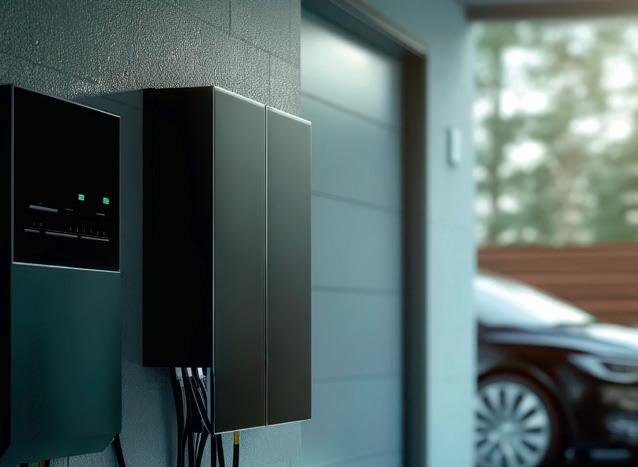






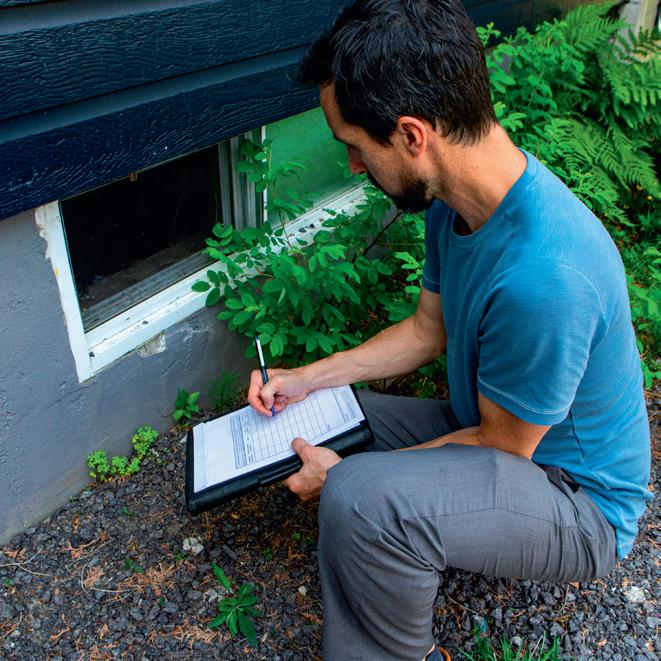







62 Home Trends
All the news about new products, services and issues a ecting the home market
64 Morris Mania
William Morris is one of the biggest names in interior design today, despite having died in 1896. A new exhibition examines the secret of his appeal
71 Do You Have it Up Top?
Converting a lo is one of the most e ective ways to add extra living space to your home, enhancing both its functionality and value
73 Your Complete Guide to Retrofitting
An ‘ecofurb’, where you retrofit an existing property to improve energy e iciency, can be the most valuable type of renovation








74 Greener by Design
A collection of expert insights highlight how sustainability is shaping the future of selfbuild and renovation
79 Have Tiles Had their Time?
There’s an alternative to the tricky and time-consuming job of tiling bathroom walls - wall panels look great and are easy to install
81 Getting Your Tiles Right
Tiles are a popular and versatile flooring and wall covering option, o ering a range of aesthetic choices and functional benefits
84 The Rise of the Robots
Robot vacuum cleaners, once a futuristic concept, have now become a household commodity
87 Making the Most of Space
Fitted wardrobes can add utility and value to your home – so how do you approach a project?
91 The Pre-Loved Kitchen
Would you buy a pre-owned kitchen? There are lots of good reasons, not the least being the money you might save
92 How Tech Can Protect
Home security technology has come a long way, providing homeowners with a range of advanced tools to protect their property and loved ones
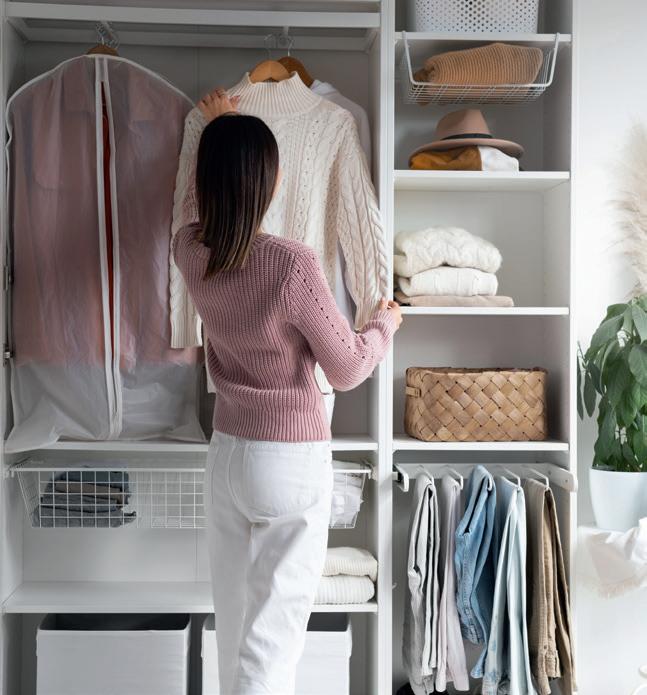










94 Keeping Your Cool
Never mind keeping warm in winter, with increasingly hot summers, many now also face the problem of keeping their homes cool
97 Is it Curtains for the Bath?
With shower rooms becoming the trend, is it curtains for the traditional bath?
99 The Perfect Home Li
Is there such as thing as the perfect home li ? Certainly, there are solutions to many installation challenges, as these case studies show
100 Fire Safety is Your Responsibility
Fire risk assessment inspections should be just the start of a continuous process of safety review
104 On A Roll
Roller shutters are a versatile and practical solution for homes, businesses, and industrial properties
106 Embracing La Dolce Far Niente
The Italian phrase for ‘the sweetness of doing nothing’ sums up an interior design trend which places a premium on leisure
PUBLISHER & CEO
Kevin Harrington
EDITOR
Chris Jenkins
SUB EDITOR
Emmanuel Berhanu
CONTRIBUTORS
Grace Bower
Margo Lane
Richard Benson
DESIGN
Joanna Harrington
PRODUCTION
Ray Walsh
PUBLISHED BY
COPYRIGHT © 2025, CELEBRITY ANGELS ALL RIGHTS RESERVED
COVER IMAGE
Martin Roberts
Property & Home with Martin Roberts
Celebrity Angels 143 Caledonian Road





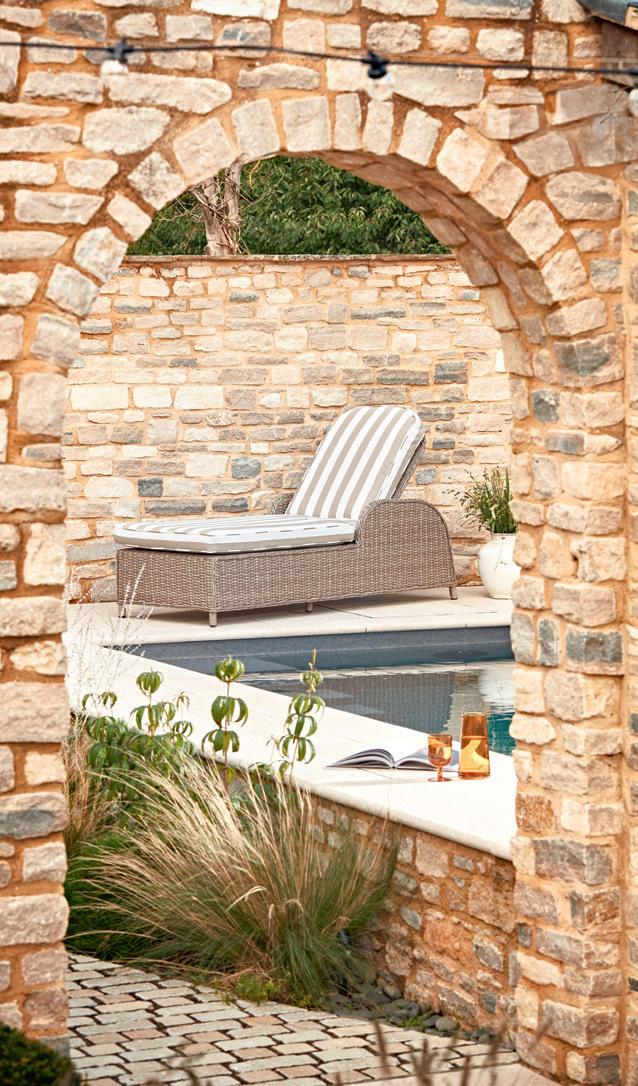
London N1 0SL Tel: 020 7871 1000
For sales enquiries call: 020 7871 1000
All material in Property & Home with Martin Roberts is wholly copyright and reproduction without the written permission of the publisher is strictly forbidden. Products and services included in this publication do not imply endorsement by Martin Roberts. The views expressed in this publication are entirely those of the writers and do not necessarily represent those of Celebrity Angels. The information in this publication is carefully researched and produced in good faith, however, neither the Publisher nor the Editors accept responsibility for any errors. The Celebrity Angels Series is published in the UK under licence by Damson Media Limited. Damson Media Limited is registered in England and Wales under registration no. 07869300.











110 Garden Trends
All the news about new products, services and issues a ecting the garden market
113 A Cabin for All Seasons
Whether you are looking for a bar, a gym, an o ice or a studio, a quality timber garden room will fit the bill
114 Spring is Sprung
Spring is the time to leap into action in the garden – from tidying, to planting, there’s always something to be done
119 The Race for Space
Whether you’re looking to add value to your property or create a dedicated workspace, garden buildings o er a wealth of opportunities



122 The Reason for Resin
There are all sorts of options for paving your driveway, but the resin solution could be the best long-term value for money
127 Firm Foundations
Erecting any garden building depends on laying a firm foundation first. Do you know what groundwork is required?
129 The Tiling Solution
Is your conservatory leaky, dra , cold in winter and hot in summer? A tiled roof could be the answer
130 Beyond the Burger
There’s more to outdoor eating than barbecuing a burger - Belinda Dangerfield of outdoor kitchen supplier Urban Garden Spac, gives her advice






132 The Poly Solution
Greenhouses are a great investment, but polycarbonate is becoming a popular alternative to glass
134 It’s Shed-tastic!
The annual Shed of the Year Awards show just how much can be done with a humble garden building
136 Stacking the Deck
Choosing the right decking material, understanding installation techniques, and learning how to maintain it are crucial steps to enjoyment
141 See-Through Dreams
Are glass structures an alternative to wood or metal garden rooms? They certainly are in terms of looks and utility
142 Design for Living
We all think about interior design, but should you put as much thought into garden design?
ENDPIECE
144 The Virtuous Equation
Martin suggests that a lack of new housing, a glut of properties in need of a refurb, and an unengaged workforce could all be solved in a single stroke
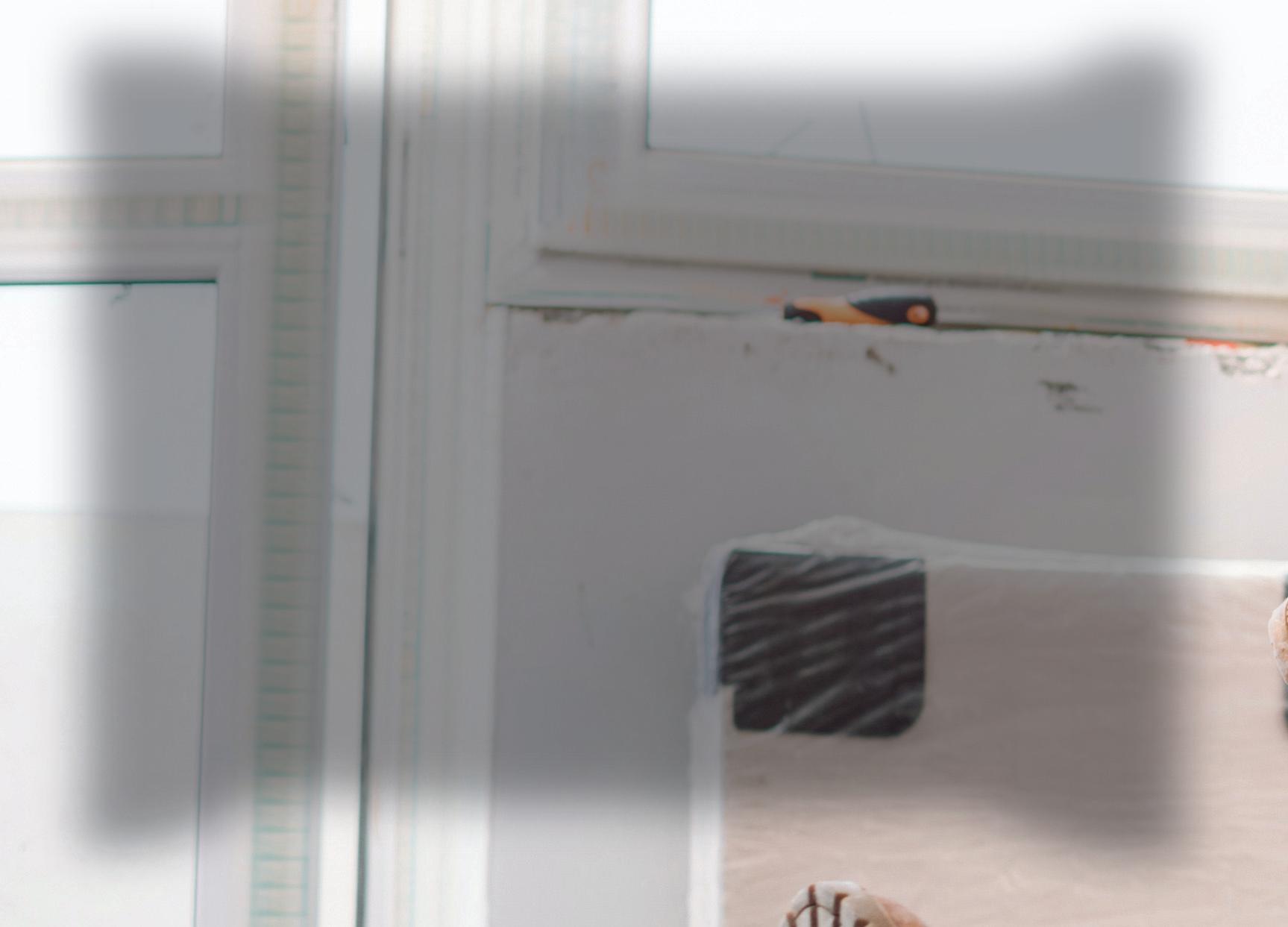





Martin Roberts, celebrity guest editor of Property & Home, talks to Chris Jenkins about the changes to rental and ground rent laws, the state of the property auction market, buying a used kitchen, moth-infested mansions and lots more
From Homes Under the Hammer to I’m A Celebrity – Get Me Out of Here!, Martin Roberts is a familiar presence on TV, radio and online, with his property advice heeded by millions. So what’s his advice for buying, renovating and maintaining a property, and how are his own projects going? Chris Jenkins asks the questions…
THE PROPERTY MARKET?
Recent changes to rental and ground rent laws, particularly in England and Wales, have introduced significant shifts in the property market, affecting buyers, tenants, landlords, and investors. If you’re in this world you really need to be aware of what’s happening. Two big things:
1.The Leasehold Reform (Ground Rent) Act 2022 sets ground rent to zero for new residential leases, making leasehold properties more attractive by eliminating ongoing costs. This could increase demand for new leaseholds, potentially
boosting their market value. Older leaseholds with ground rent clauses may face depreciation pressure, as buyers might prefer newer, zero-ground-rent properties. This could incentivise existing leaseholders to negotiate lease extensions or enfranchisement (buying freeholds) to enhance value.
Freehold properties, traditionally preferred for outright land ownership, might see reduced demand if new leaseholds offer comparable financial benefits without ground rent. However, freeholds remain attractive for longterm security.
Developers may shift toward building freehold or commonhold properties (an alternative to leasehold) as ground rent income diminishes, altering future housing supply trends.
2.Rental Market Reforms (e.g., Renters’ Reform Bill). The proposed abolition of Section 21 “no-fault” evictions (UK) enhances tenant security but may deter landlords, reducing rental supply. This could drive up rents in the short term due to heightened competition.
Caps on rent increases and stricter quality standards (e.g., Decent Homes Standard) may increase landlords’ operational costs, potentially leading to higher rents or sell-offs by smaller landlords. Buy-to-let investors might exit the market due to reduced profitability, increasing housing supply for buyers but decreasing rental availability. This could cool rental market growth while boosting owner-occupier sales.
The property market is experiencing a transitional phase. Ground rent abolition enhances new leasehold appeal but pressures existing leaseholders, while rental reforms prioritize tenant security at the risk of reduced landlord participation. Investors and stakeholders must adapt to a landscape increasingly shaped by regulatory fairness, with potential longterm benefits balanced against short-term volatility. Monitoring post-reform data and regional trends will be crucial to fully understanding these impacts.
What concerns me though, is a sense that “It’s all too much trouble now!” that may impact an already fragile Private Rental Sector. »
As of March 2025, the UK government has proposed new regulations to improve the energy efficiency of privately rented properties in England and Wales. The key proposal is to raise the minimum Energy Performance Certificate (EPC) rating required for these properties to a ‘C’ by 2030. This initiative aims to reduce carbon emissions and alleviate fuel poverty by ensuring rental homes are more energy-efficient.
Currently, landlords are required to have a valid EPC with a minimum rating of ‘E’ to let a property. This certificate, which assesses the energy efficiency of a property, must be renewed every 10 years or sooner if significant energy efficiency upgrades are made.
To support landlords in meeting these proposed standards, the government is conducting consultations to gather feedback on the implementation process, potential exemptions, and financial support mechanisms. If you’re a landlord, you should participate in these consultations to stay informed and prepare for the upcoming changes.
Well, you know me, I love auctions!and I think property auctions in the UK continue to present opportunities for buyers seeking potential bargains. However, the availability and quality of these deals depend on various factors, including property condition, location, and market dynamics.
But part of the fun is that property auctions often feature properties requiring renovation or unconventional purchases, which can be acquired at lower prices.
Having said that, while auctions can offer attractive deals, it’s essential for you to:
Do your Due Diligence: Thoroughly research properties, including legal packs and structural assessments, to understand potential risks and required investments.
Set a Budget (and stick to it!!):
Establish a clear budget, accounting for renovation costs and potential market fluctuations.
Understand the Process: Familiarise yourself with the auction procedures, and you know the best way to do that! Keep watching Homes Under the Hammer !! In summary, while bargains can
still be found at property auctions, success depends on careful planning, market awareness, and diligent property evaluation.
The UK government has unveiled ambitious plans to address the housing crisis through the development of a new generation of towns across England. These initiatives aim to provide affordable housing, essential infrastructure, and accessible green spaces to meet the needs of a growing population.
Currently there are plans for 12 new towns to be under construction by the next election. Each settlement is planned to contain at least 10,000 new homes, with the potential for significantly more where achievable.
Over 100 potential locations have been identified across England, with submissions from councils, developers, and landowners. The majority of these sites are situated in London, the South East, and the South West regions. The initiative focuses on delivering well-
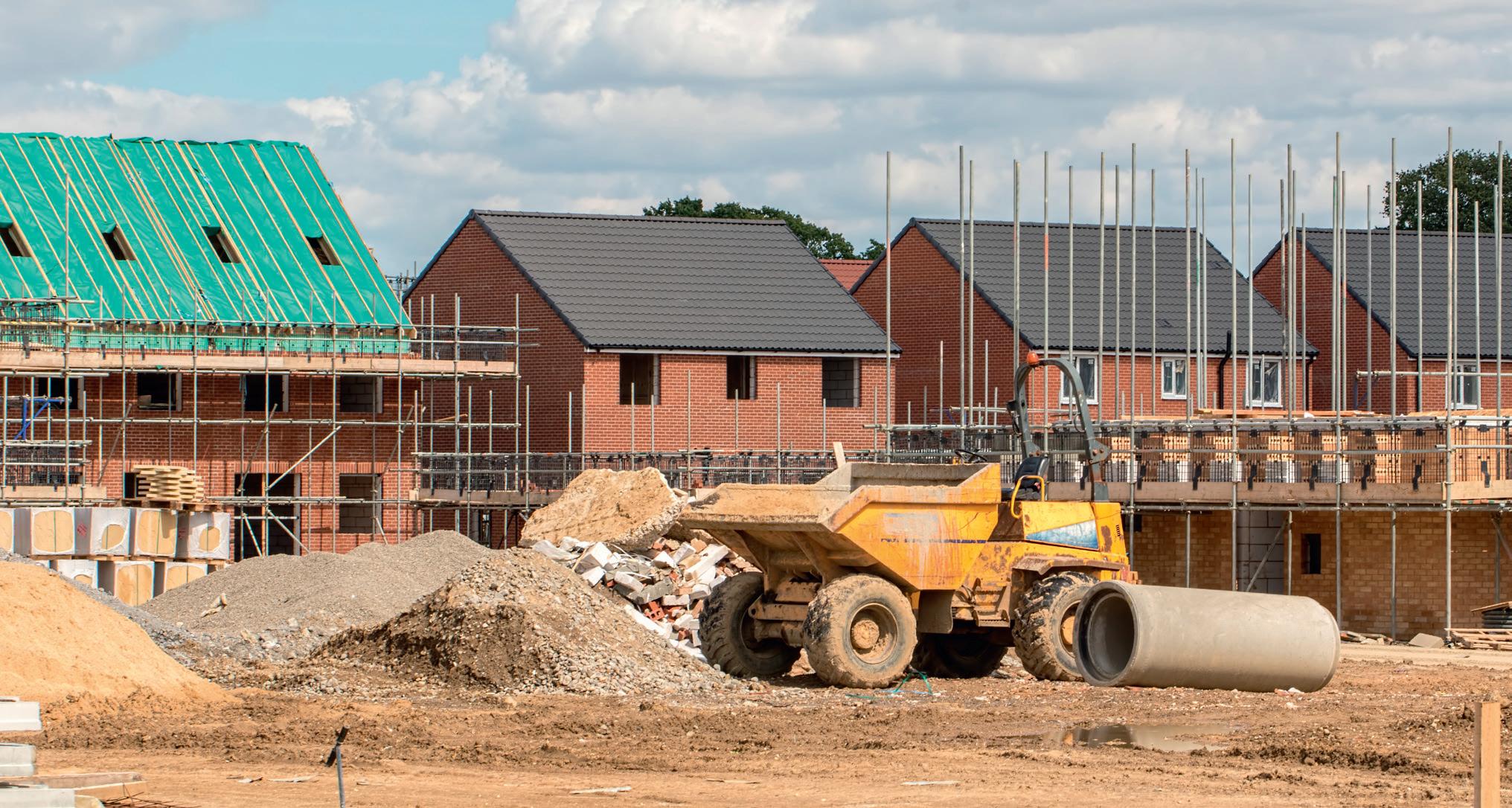
designed communities that offer affordable housing, vital infrastructure, and access to open green spaces and nature.
SO, WHAT EFFECT WILL THIS POTENTIALLY HAVE ON THE PROPERTY MARKET IN GENERAL?
By increasing the housing stock, these new towns are expected to alleviate some pressure on the housing market, potentially stabilizing property prices and improving affordability, particularly in high-demand areas.
The development of new towns can stimulate local economies by creating jobs during the construction phase and attracting businesses and services to the area, further enhancing property values.
While the influx of new properties may moderate price increases in the short term, the long-term impact on the property market will depend on factors such as demand, economic conditions, and the successful integration of these new communities.
The UK’s plans to develop new towns represent a significant effort to tackle the problem of housing shortages and promote economic development. While these initiatives have the potential to positively influence the property market by increasing supply and enhancing affordability, their ultimate success will depend on careful planning, investment in infrastructure, and sustainable development practices. But looking at previous New Towns, such as Milton Keynes, Telford and Skelmersdale, I think we have reason to be positive.
WHAT ARE YOUR THOUGHTS ABOUT THE ‘MOTH-INFESTED MANSION’ NEWS STORY?
This was a funny first read, but underlines an important issue. If you recall, the recent court ruling involved a £32.5 million Notting Hill mansion that was plagued by moths. Not surprisingly the new owners were not happy as the little critters munched their way through Christmas Pringle jumpers and delicious posh frocks. But it underscores the critical importance of transparency in property transactions.

Buyers rely heavily on accurate disclosures to make informed decisions, and this case highlights the potential legal and financial repercussions when sellers fail to provide complete information. Nope. The sellers didn’t mention the population of fluttering clothing munchers who were co-habiting the house! The judgment serves as a cautionary tale, emphasizing the necessity for sellers to disclose all known issues, regardless of their perceived severity. It also reinforces the need for buyers to conduct thorough due diligence, including comprehensive property inspections, to uncover any hidden defects before finalizing a purchase. I mean, didn’t they open the cupboard doors or notice the unusual holey curtains?
WHY HAS THE HOUSING OMBUDSMAN CALLED FOR A SURVEY OF LEAD IN HOUSES?
England’s Housing Ombudsman, Richard Blakeway, has called for a comprehensive survey of residential properties to assess the presence of lead. This initiative follows a Financial Times investigation that highlighted the detrimental health effects of lead exposure. Blakeway emphasized
that lead hazards often go “undetected” in housing assessments and should be treated with the same level of concern as asbestos, mould, and damp.
Health Risks: Lead exposure is known to cause severe health issues, particularly in children, affecting neurological development and leading to long-term cognitive and behavioural problems.
Aging Housing Stock: A significant portion of England’s housing was constructed before the 1992 ban on lead-based paint, raising concerns about the widespread presence of lead in older homes.
Lack of Routine Testing: The absence of regular lead assessments means that many residents may be unknowingly exposed to this toxic substance.
Blakeway has proposed a pilot survey, potentially initiated by the Ministry of Housing, Communities and Local Government (MHCLG), to evaluate the extent of lead contamination in homes. This survey aims to bridge the “disconnect” between existing legal regulations and actual practices, ensuring that lead risks are adequately identified and mitigated in residential properties. »

This initiative underscores the necessity for updated guidelines and proactive measures to protect public health from the dangers of lead exposure in domestic environments.
Watch this space - and if you live in a property where you think there may be lead, speak to a specialist or good general builder about safely removing it.
IS IT WORTH BUYING A USED KITCHEN?
Well, I certainly think so! I’ve done it several times, and ended up with hand made designer kitchens in my properties for a fraction of their original cost. If you’re flexible, do thorough research, and account for any extra costs, on a tight budget and willing to compromise slightly on fit and style, it can be a great way to get a high-end kitchen for much less.
So, it can be a cost-effective and sustainable option, but whether it’s worth it depends on several factors.
Pros:
✔ Cost Savings – You can save perhaps 50 to 70 percent compared to buying new, especially when you are looking at highend brands.
✔ Quality & Brands – You may afford a premium kitchen (e.g., German brands like Poggenpohl, Bulthaup) or handmade designer ones for much less.
✔ Eco-Friendly – Reduces waste and promotes reuse rather than landfill.
✔ Includes Appliances – Many secondhand kitchens come with integrated appliances, further reducing costs.
Cons:
✘ Size & Fit Issues – Used kitchens are designed for their original space, so they may not fit perfectly in your home.
✘ Condition Variability – Check for wear and tear, water damage, or missing components.
✘ Dismantling & Transport – Some sellers require buyers to remove and collect the
kitchen themselves, adding to costs.
✘ No Warranty – Unlike new kitchens, used ones come without manufacturer guarantees.
Key Tips for Buying a Used Kitchen:
h Measure Carefully – Compare dimensions to ensure it fits your space.
h Inspect in Person – Look for damage, missing parts, and quality of cabinets/ worktops.
h Consider Installation Costs – Factor in any modifications or extra work needed.
h Check the Age of Appliances – Ensure they are functional and not at the end of their lifespan.
h Negotiate – Prices are often flexible, especially if the seller is keen to offload quickly.
You can look at online auction sites for used kitchens from private sellers, but they have to be vetted carefully -
specialist resellers will offer dismantling and delivery services and a better level of security.
Well, in principle, yes, but it depends on factors such as purpose, quality, location, and market trends.
A well-designed garden office, studio, or guest house can increase home value by 5-15%, depending on the area and demand for extra space. Buyers are increasingly seeking home offices and multi-use spaces, making high-quality garden buildings desirable.
There’s also rental potential:
Short-term rentals (Airbnb, holiday lets) – If it has amenities like a bathroom and kitchenette, a garden building can generate £50-£150 per night, depending on location.
Long-term rentals (lodger or tenant)
– A fully insulated, self-contained garden annex could provide rental income of £500-£1,500 per month, especially in cities.
Things to consider:
✔ Quality & Insulation – Well-built structures with insulation, electrics, and heating hold value better.
✔ Purpose & Market Demand – Offices and self-contained units appeal most to buyers.
✔ Planning Permission – Most garden buildings don’t require planning permission, but larger or liveable spaces might.
✔ Initial Investment – A high-end garden room (£20k+) may bring better ROI than a cheap shed conversion.
Potential Downsides:
✘ Cost vs. Payback – Lower-end structures may not add enough value to justify the cost.
✘ Market Trends – If buyers don’t value the extra space, it may not significantly boost selling price.
✘ Legal & Tax Considerations – Rental use could involve council tax, planning rules, or capital gains tax.
TO?
As you may know I’ve been deeply involved in the “ambitious” renovation of the Hendrewen Hotel, a historic community pub located in Blaencwm at the top of the Rhondda Valley in South Wales. I bought it three years ago, with the vision of transforming it into a vibrant gastro pub, restaurant, and tourist attraction featuring eight luxury boutique bedrooms.
The renovation journey has been both rewarding and challenging. Catch me on a good day and I’m as enthused as ever. On
a rainy day it’s hard not to feel frustrated it’s not open yet and daunted by what’s still left to do! There have definitely been some unexpected obstacles, including structural issues and other challenges that come with restoring a commercial building, which have delayed progress. But as Dory says in Finding Nemo, “Just keep swimming...” And we’re still set to open before Christmas! Just don’t ask ‘Which one?’.
The good news is we continue to film our adventures for an ITV documentary that will be shown a few months after we open. So, you’ll be able to see the tears and the drama first hand! ■

From financial advice to used kitchens and outdoor buildings to solar power, the latest products and services in the property sector


Keops o er an extensive range of outdoor log cabins for a multitude of purposes, from summerhouses and garden rooms, to home o ces, gyms or garages to name a few, right up to their mobile home range for living accommodation and log cabins for commercial use. www.logcabins.co.uk
Whether you own just one investment property or a portfolio, UK “bricks and mortar” remains one of the most popular wealth-building strategies, and it’s reported that there is growing interest in the sector from young people.
Research from estate agent John Minnis has found that a greater number of under-35s are now choosing to invest either their earnings or their inheritance into property, with some even prioritising an investment over buying their own home to live in as they look to build wealth for the future. For others, investing in an additional property alongside their own home is providing a stable income stream.
An investment property can generate wealth in multiple ways, from providing a regular income stream through renting it out or by the profits made when selling the property. For many, an investment property is an important asset to pass onto the next generation.
Often, property wealth is accumulated over time, meaning the largest proportion of investment property owners are aged 45 and over. A property can be used as a retirement plan to supplement your pension, which is why many landlords choose to sell their properties when this time comes.
But research from Paragon Bank also suggests that the average buy-to-let landlord in the UK was getting younger, with 31 percent of new buy-to-let mortgages being acquired by borrowers in their 30s; up from 21 percent ten years previously. The bank also noted a rise in the number of landlord buyers aged as young as 18-29.

My Home Move Conveyancing know moving home is stressful. They’ll guide you through your home-moving journey, from a personalised conveyancing quote, to placing you with a dedicated conveyancer, and help with surveys, insurance, even removal van hire and moving services.
www.myhomemove.com












PowerInsight is a comprehensive energy dashboard that lets you easily view your home energy data in real-time, by day, month, or even year. Designed to help users achieve true home energy independence while saving money and enjoying convenience. uk.ecoflow.com

Construction industry experts are warning that the government’s ambitious housebuilding strategy is being threatened by a shortage of the most vital component – bricks.
The government has pledged to build 1.5 million new homes within the next five years to tackle the housing crisis and stimulate economic growth, but industry experts have been warning for many years that a severe labour shortage, particularly among skilled trades such as bricklayers, could jeopardise this goal.
Now pundits are also warning of a shortage of basic construction materials such as bricks - the Federation of Master Builders says that the reason is that manufacturers mothballed kilns during a drop in sales during the recession, and that a lack of materials risks scuppering the ability of many construction firms to keep pace with new house building projects. It’s suggested that a turn towards timber construction methods could help solve the problem while helping achieve green targets.
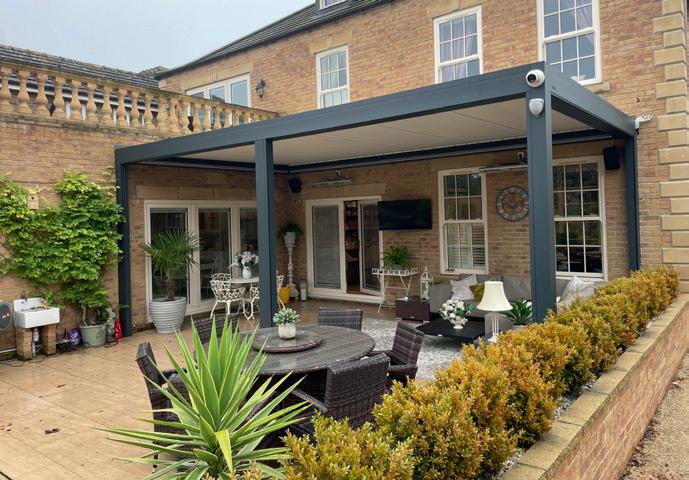

Brunswick Wild Sardines are a small fish with huge nutritional benefits. We like to think of them as the original superfood of the sea. Packed with Omega-3, protein, and calcium, who knew sardines were such a nutritional powerhouse! gracefoods.co.uk
Rase Outdoor Living designs bespoke pergolas, glass rooms, and outdoor kitchens, creating luxurious, multi-functional spaces. Crafted with premium materials for year-round use, their tailored solutions enhance gardens with elegant, durable, and seamlessly integrated outdoor living areas. raseoutdoorliving.co.uk
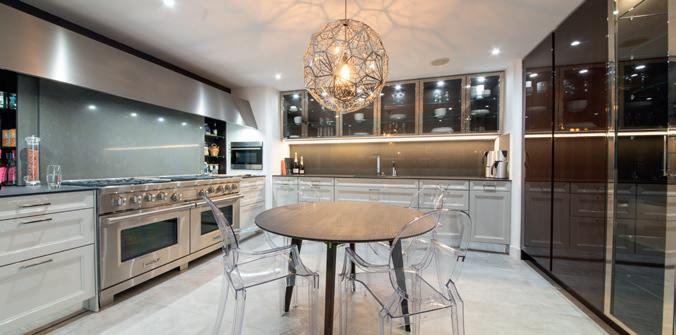
Used Kitchen Hub is the UK’s leading luxury kitchen re-seller. Since 2015, the team has specialised in the buying and selling of exdisplay and privately owned used kitchens at discounted rates, whilst providing a friendly, experienced, hand-held service. usedkitchenhub.com

Explore our range of tailored financial solutions for your project. Our Specialist Finance Products include Development Finance & Self-Build Mortgages, Commercial & Residential Buy-to-Let, Bridging Finance, Loans for High Net-Worth Individuals, and Specialist Mortgages for Complex Properties, Income, or Credit History. Let us help you find the right solution for your needs. themortgagemum.co.uk

Whether you own one rental property or a growing portfolio, the world of property investment is more complex than ever - new regulations, tax changes, tenant demands, and shifting markets. For landlords navigating this landscape, one name stands out: iHowz. www.ihowz.uk
At My Home Move Conveyancing, we’re here to help reduce the stress that comes with moving home. We’ll guide you through the process, cutting the jargon to make it clearer and easier for you, and being here for you whenever you need us.
From buying your first home, to selling an investment property, and all things in-between, we’ll help your transaction go as smoothly as possible. We’ll connect you with expert and dedicated conveyancers who will guide you through the entire process, making sure the legal side of things is taken care of smoothly and efficiently.
We’ll find out what’s important to you, so we can give you a tailored and personal service that works for you
Being experts means we don’t need to hide behind jargon - we make things straightforward and easy to understand

‘feel’ local We’re transparent
In fact, we’re better than local. Your case is available to you to see 24 hours a day, and you can get in touch with us via phone call, email and messaging services 24/7
We’re open and transparent, from your quote to how your case is progressing, so you can be confident in our service
proactive
We use the right combination of tech and people, at the right points in your moving journey to keep the process moving along, and keep you updated

We work with a range of conveyancing and law firms to cover most types of property transaction, across England, Scotland and Wales.
z Freehold sale and purchase
z Cash purchase
z Remortgage
z Leasehold
z Transfer of equity
z Equity release
z Lease extensions
z New build
z Buying via auction
z Building Safety Act transactions
z Buying via a company
We also offer a Home Document pack, a printed and tangible record of your move, with all your important documents collected in one indexed binder.
We work closely with a number of other home move experts, carefully vetted by us, to bring you the best possible service to help you through your moving journey.
z RICS home surveys
z Home insurance
z Removal van hire
z Home setup service
Thousands of movers have trusted us to help them move, and we’re very proud to be rated ‘Excellent’ on Trustpilot by them. We put transparency, care, and innovation at the heart of everything we do, to ensure that your home move journey starts with ease and ends with confidence.
To find out more about all the services we can offer, or to discuss a move you have in mind, get in touch with us today.
Let’s get you moving!
…and those are death, and taxes. There’s not much you can do about one, but tax is certainly a subject where good advice is crucial

In the ever-evolving landscape of taxation, navigating the complex rules and regulations can be a daunting task for both individuals and businesses. Having a qualified tax advisor can make a world of difference when it comes to understanding tax obligations, maximising savings, and ensuring compliance with the law. Whether you’re a small business owner, a landlord with investment properties, or an individual planning for retirement, the
right tax advisor can help optimise your financial situation.
Tax laws in the UK are intricate and subject to change, with numerous rules and exceptions for different types of income, businesses, and assets. A tax advisor brings expertise that can help you make informed decisions, avoid costly mistakes, and plan ahead for tax obligations. Some of the primary reasons why having a tax advisor is essential include:
h Maximising Tax Efficiency: A tax advisor can identify opportunities for tax savings that you might overlook. Whether it’s through tax reliefs, deductions, or allowances, a tax advisor will ensure you’re taking full advantage of the UK’s tax system.
h Navigating Complex Tax Regulations: Tax laws are constantly changing, and staying up to date is essential for compliance. A tax advisor can keep you
informed of new tax regulations that may impact your finances or business operations.
h Capitalising on Tax Reliefs and Allowances: The UK offers a variety of tax reliefs and allowances that can reduce your tax burden. A tax advisor will help you understand and access these benefits, whether you’re claiming capital allowances, business expenses, or property reliefs.
h Minimising the Risk of Errors: Filing your taxes incorrectly can lead to penalties or interest charges. A tax advisor can help ensure that your filings are accurate, reducing the likelihood of costly errors.
h Strategic Tax Planning: A tax advisor can help create a tax-efficient strategy for your business or personal finances, making decisions about income distribution, retirement contributions, and investments to reduce your overall tax liability.
For businesses that own property, whether for commercial use or as part of their
operations, tax planning can play a pivotal role in reducing costs and enhancing profitability. Business property owners in the UK can benefit from various tax-saving opportunities, including:
h Capital Allowances: Businesses can claim tax relief on capital expenditure for property improvements, such as the cost of machinery, equipment, or fixtures installed in commercial premises. This includes things like lighting, heating systems, and even the structural alterations made to the property.
h Business Rates Relief: Certain types of businesses are eligible for business rates relief, which can lower the amount of tax paid on commercial properties. Small businesses and those in specific sectors may benefit from reduced rates or complete exemptions.
h Annual Investment Allowance (AIA): If you’re a business owner who’s investing in equipment or machinery for your property, the AIA allows you to deduct the full cost of these assets from your profits, up to a specified annual

limit. This can result in significant tax savings, especially if you’re expanding your operations.
A tax advisor can help you make the most of these opportunities, ensuring that your business property is as taxefficient as possible. Moreover, they can advise on the most effective structure for owning property—whether through direct ownership, leasing, or a special-purpose vehicle (SPV).
Capital Gains Tax (CGT) is a tax on the profit made when you sell or dispose of an asset, such as a property or shares. For landlords, CGT is particularly relevant when selling investment properties. The amount of CGT payable is based on the difference between the sale price and the purchase price, less any allowable costs such as renovations or sale fees.
A tax advisor can help you plan around CGT by advising on how to structure your sale or dispose of assets in a tax-efficient manner. They can also recommend taxsaving strategies such as utilising tax-free allowances or investing in other assets that are exempt from CGT.
Landlords in the UK can also take advantage of capital allowances to reduce their taxable income. Capital allowances are tax reliefs granted on certain expenditures related to the ownership of rental properties. This includes the cost of fixtures and fittings such as kitchens, bathrooms, and electrical systems. Many landlords fail to claim these allowances, potentially missing out on valuable tax savings.
Some other common reliefs in the UK include Income Tax Relief, where individuals can claim income tax relief on pension contributions, charitable donations, and certain types of business expenses; and Loss Relief, where both businesses and individuals can offset losses against future profits or past profits, reducing the amount of tax payable in profitable years.
By working with a tax advisor, you can ensure you’re maximising these reliefs to reduce your overall tax liability and boost your financial stability. ■










Matt Jeffery, BA ATT CTA (pictured left) Tax Partner & Managing Director at Zeal Tax
Taxation is a significant aspect of a property investment or development business. The amount of tax you pay impacts your return on the investment.
However, time and time again I come across property investors that have neglected the tax implications and been left with tax liabilities that were significantly higher than they expected, or were completely unaware of. I have also seen occasions where they have paid too much tax! Unfortunately in most cases, once a transaction has completed, it is too late to correct mistakes and change the tax position.
It is not uncommon for investors and developers to rely on advice they read on social media, from their ‘mate’ down the pub, on a ‘property experts’ training course or even from an unqualified, or qualified, accountant.
In addition, as the accountancy industry is not regulated, this has resulted in lots of unqualified ‘accountants’ completing what are perceived to be ‘simple’ tax returns, making unwarranted mistakes, and providing tax advice that is often wrong and costly when HMRC make their enquires.
It is important to note the difference between a tax advisor and accountant. A tax advisor is qualified, or has the necessary experience, to provide tax advice. They are not accountants.
Accountants, of which many are unqualified or generally ‘bookkeepers’, are trained or qualified to produce accounts. Most accountants don’t have the skills or knowledge to provide expert, money saving, tax advice.
Tax advisors, and more specifically, tax advisors that specialise in property related taxes, will have
an in-depth knowledge of all the relevant tax legislation and case law.
Everyone’s circumstances will be different, so the advice provided should be tailored to you.
The price of not obtaining the correct advice can lead to non-compliance, poor tax efficiency and tax planning, and result in penalties and interest charges. It can also lead to missed opportunities to claim allowable costs and additional tax reliefs available, meaning you’ll pay more tax than you need to.
Working with a qualified tax advisor (CTA or ATT qualified) will ensure you are compliant with tax legislation, help to reduce your tax liabilities and ensure you have the right tax structure to support your growth, and provide the flexibility to pass on your assets to your dependents, tax efficiently.
Obtaining tax advice from tax experts is crucial to ensure you pay the right tax and are not faced with unexpected tax bills.
Good tax advice will pay for itself!
About Zeal Tax
Zeal are Chartered Tax Advisors and qualified RICS Surveyors. Their team specialise in helping commercial property owners and investors enhance their tax efficiency, uncover unclaimed capital allowances tax relief in their properties, and pay only the right amount of tax.
For assistance with your property tax matters, please contact Zeal on: 01633 287898 | hello@gozeal.co.uk
You’ll want to determine what is the best and most tax efficient entity to hold the property (whether in a company, LLP, Trust, personal ownership etc), ensure you pay the right amount of Stamp Duty Land Tax (or equivalent) and determine if any capital allowances are available.

You’ll need to calculate and pay Capital Gains Tax (CGT). You may also need to report the transaction to HMRC within 60 days of sale.
As these are all things an accountant cannot typically help you with, using a tax advisor will ensure you stay compliant, pay the right amount of tax and avoid hefty penalties. A tax advisor can also provide advice on your existing property portfolio and review your current tax efficiency.
In addition to offering guidance on whether restructuring your business or transferring asset ownership could lead to significant savings (now and in the future), they can also help you with inheritance tax planning. Whilst this could be something you have not even considered yet, as property investments are chargeable assets for Inheritance Tax (IHT), 40% of your legacy estate could be handed to the government without proper planning in place.
Capital allowances are a form of tax relief that allows property investors to offset qualifying capital expenditure against taxable profits. Whilst accountants can claim some capital allowances for you, these are usually restricted to items like vehicles and equipment that you purchase.
Most property owners and investors are unaware that there is an ‘extra’ level of capital allowances that can be claimed on part of the costs incurred to purchase, build, convert, refurbish or extend a property used for commercial or short-term let purposes.
It is estimated that 80% of eligible owners have not claimed their capital allowances entitlement yet.

This is on embedded ‘fixtures’ in the fabric of, or installed in the building or land, like heating and electric systems, water pipework, kitchens, bathrooms and more. Due to the need for quantity surveyors and capital allowances tax specialists (like Zeal) to identify and quantify qualifying expenditure, this is not a service accountants can typically provide. Even if you incurred expenditure years ago, you could still be able to claim now.
On average, Zeal typically find 15%-30% of the original costs incurred as qualifying for capital allowances. Claiming this tax relief can generate significant tax savings and mitigate tax liabilities. Owners could also be entitled to reclaim previous tax paid as a cash rebate. Making a capital allowances claim also has NO impact on CGT or the base cost of the property.


With Zeal, it won’t cost you a penny to find out if you qualify – only a few minutes of your time. You’ll also be given a free estimate of your potential tax benefit. Plus, as Zeal operate on a success-fee basis with no upfront costs, there’s no risk to you.
Scan the QR code now to select a time for your free review.
Exclusive offer: Quote ZPH10 to receive a 10% fee discount if you claim with Zeal.
Charles Knapper LLB answers our questions about the legal complexities of property ownership – this time, boundary disputes

Property boundary disputes are by far the most common source of tension among neighbours. This article explores the causes of these disputes, legal rights concerning issues such as overhanging trees, methods to define and clarify boundaries, and the principles of adverse possession.
The starting point may seem obvious, but the best advice is to try as hard as you can not to get into a dispute with your neighbour. Immediately instructing lawyers almost always escalated a minor disagreement into very costly legal battles.
Recently a London couple were ordered to demolish an £80,000 extension and pay £200,000 in legal fees because it was built too close to their neighbour’s house, encroaching on their property by just over two inches and overhanging their neighbour’s roof by a few inches.
Property boundaries define the extent of land ownership and are typically detailed in title deeds and registered with HM Land Registry. However, the title plan held by the Land Registry is not necessarily accurate, and is known as a general boundary unless there are measurements shown on a plan. Surprisingly, the word ‘boundary’ has no special meaning in law - there are two senses in which it can be used: legal boundary and physical boundary. A legal boundary is an imaginary or
Charles Knapper has 25 years of legal experience in property, disputes, family and children’s law, wills and probate, and is a Consultant Partner of Curtis Whiteford Crocker Solicitors, 247 Dean Cross Road, Plymouth, Devon, PL9 7AZ. See the website at https://cwcsolicitors.co.uk
invisible line dividing one person’s property from another. It is an exact line, having no thickness or width, is rarely identified with any precision either on the ground or in conveyances or transfers, and is not shown on Ordnance Survey mapping. Ultimately the exact position of a boundary, if disputed, can be determined only by the court or the Land Registration division of the Property Chamber, First-tier Tribunal.
A physical boundary is a feature that we can see such as a fence, wall or a hedge, which may, coincidentally, also follow the line of a legal boundary. The legal boundary may run within the physical boundary structure, but it might just as easily run along one particular side of the structure or include all or any part of an adjoining roadway or stream. Living boundary structures such as hedges can be prone to a certain degree of movement, making its original line hard to discern.
To prevent disputes, it’s crucial to establish clear property boundaries. This can be achieved by:
h Reviewing Title Deeds: Examine the property’s title deeds and Land Registry plans for boundary information, remembering that the title plan usually only shows a general boundary not a precise location.
h Commissioning a Survey: Hire a chartered surveyor to create an accurate boundary plan and if the neighbours both agree this can be sent to the Land
Registry as a boundary agreement and it will appear on the register for both properties.
h Installing Physical Markers: Erect fences or hedges along the agreed boundary lines, but remember a hedge is a living organism and can and will move as it grows.
h Ask the Land Registry for help: If both neighbours can agree, the Land Registry can determine exactly where the boundary is, and this can then appear on the register for both properties. Remember this can only be achieved if both neighbours agree to instruct the Land Registry.
Engaging in open communication with neighbours during this process can foster mutual understanding and cooperation. Settling this between neighbours without instructing lawyers can save a small fortune. What makes this more difficult is when a conveyance or transfer uses the expression ‘for the purposes of identification only’. The question for the court is: what would the reasonable layperson think they were buying? Evidence of the parties’ subjective intentions, beliefs and assumptions is irrelevant.
When boundaries are unclear, there are two easy and fairly cost-effective ways of reaching an agreement. One is to consult a chartered surveyor who can assess the property and provide a detailed plan and

boundary agreement to be sent to the Land Registry. There is also a free service provided by the Land Registry, and two neighbours can jointly ask the Land Registry to make a determination using section 60 Land Registration Act 2002, resolving any dispute forever.
Trees that overhang property lines are a frequent cause of neighbourly disputes. Legally, if a tree’s branches or roots encroach onto your property, you have the right to trim them back to the boundary line, but you cannot trespass onto your neighbour’s land to do so, and any cuttings remain the property of the tree owner and should be offered back. A tree is a living organism, and might start off life on what appears to be solely your neighbour’s land, but as it grows it can span the boundary, becoming the responsibility of both neighbours, who will need to do whatever is required to keep those parts of the tree on their land safe - particularly relevant if part of the tree broke off and damaged the neighbour’s property.
Boundary disputes can escalate quickly, leading to significant legal expenses. One case involved a homeowner who
cut down trees on his property, resulting in a £170,000 compensation order due to the trees’ protected status. These examples underscore the importance of understanding legal obligations and seeking amicable solutions to disputes.
Another key issue in property disputes is adverse possession, often referred to as “squatters’ rights.” This allows an individual to claim ownership of land they’ve occupied without permission for a specific period. In the UK, the rules differ based on whether the land is registered or unregistered:
h Unregistered Land: Continuous occupation for 12 years can lead to a successful claim.
h Registered Land: A 10-year period of adverse possession is required, after which the possessor can apply to be registered as the owner. The original owner is notified and has the opportunity to object.
Adverse possession is a strange concept because it goes against everything that seems obvious. Surely you cannot obtain ownership of something that belongs to something else and adverse possession is
completely at odds with The Human Rights Act 1998 and the European Convention on Human Rights? The case of JA Pye (Oxford) Ltd v United Kingdom led to a significant legal interpretation, highlighting these concerns. The Land Registration Act 2002 introduced a new regime for adverse possession, making it more difficult for squatters to gain ownership, especially on registered land.
To succeed in an adverse possession claim, the occupier must demonstrate factual possession, an intention to possess, and that their possession was without the owner’s consent. Importantly, mere use of the land, such as occasional maintenance, is insufficient; the possession must be exclusive and uninterrupted. In essence, the UK legal system has adapted to ensure that adverse possession does not unfairly infringe upon the rights of landowners, as enshrined in the Human Rights Act and the European Convention on Human Rights.
So, remember that property boundary disputes, while often stemming from minor issues, can escalate into significant legal and financial burdens which can have a direct impact on your ability to sell the property, and can empty your bank account! ■
Kelsey Phillips answers our questions about the financial complexities of mortgages, from rates to repayments

Purchasing a property is one of the biggest financial decisions you can make. While most people can’t afford to buy a home outright with cash, the UK mortgage mechanism allow buyers to spread the cost of purchasing a home over many years — making homeownership accessible to a broader population. However, with so many mortgage options available in an
Kelsey Phillips is a seasoned finance professional with a diverse career spanning elite sports, global markets, and property investment. Recognised for her industry impact, Kelsey was awarded Best Newcomer to the Mortgage Industry 2025 and is a named ‘Rising Star’ finalist at both the Financial Times and Financial Reporter awards. Kelsey can be contacted via arosefinance.co.uk
increasingly volatile market, choosing the right one can feel overwhelming.
Unlike a personal loan, a mortgage is a loan secured against an asset. While lenders could theoretically secure mortgages against assets like cars, boats, or stock portfolios, they most commonly use land or property as collateral.
In practical terms, this means you borrow money from a lender to provide
funds for your property purchase; make monthly repayments, typically, over 15–35 years, covering only the interest or including both the capital (amount borrowed) and interest; and you use the property as collateral. At loan inception, the lender places a legal charge on your property’s title. If you default on repayments, the lender can seize the property (known as repossession or foreclosure).


The mortgage market plays a significant role in UK homeownership, with mortgages accounting for a large portion of household debt. According to the latest government data, 61.7% of UK households are homeowners—the remainder either rent privately, socially, or live rent-free. Among homeowners, 46.5% use mortgage debt to finance their properties. Here’s why homebuyers opt to use mortgages:
1. Enable homeownership. Most people cannot afford to buy a home outright with cash. Mortgages allow buyers to purchase a home with a small deposit (typically 5–20% of the property value) and spread payments over decades.
2. Build Equity. As you repay your capital repayment mortgage, you gradually reduce the debt secured against your property. The difference between the property’s value and the remaining loan balance grows over time — this is called creating equity. Additionally, if the property appreciates in value, you can borrow against this equity or realise its full value when selling.
3. Access to Property Investments.
Investors also use buy-to-let mortgages (or other creative finance strategies) to purchase rental properties, leveraging rental income to cover repayments while expanding their portfolios
If you are considering taking out a mortgage, it’s essential to evaluate your future cash flow and financial resilience. While most regulated lenders aim to work with borrowers, failure to meet repayment obligations could result in losing your property (the security for the loan). A skilled mortgage broker will help you budget effectively and consider unlikely scenarios— such as changes in your circumstances— that could affect your ability to meet debt obligations.
So, what are the main types of mortgage solution in the UK market? Below we break down the main interest rate and repayment strategies before discussing key considerations when selecting a product.
Mortgage solutions with a fixed interest rate for a specified period—typically 2, 3, or 5 years.
Pros:
h Consistent monthly payments for the fixed term, simplifying budgeting h Protection from interest rate hikes during the fixed period
Cons:
h As your interest rate is fixed, you do not benefit from falling interest rates during the fixed term
h Early repayment charges (ERCs) usually apply if you exit before the term ends
Best for: Borrowers prioritising payment stability or anticipating rising interest rates. In November 2024, the Bank of England estimated that 2.7 million households were still paying less than 3% interest on their mortgages. This is because many homeowners opted for fixed-rate mortgages during the Bank of England’s 14 consecutive base rate increases between December 2021 and August 2023.
Until relatively recently, most mortgage rates were variable. Variable-rate mortgages fluctuate over time and can take several forms: »

A. Standard Variable Rate (SVR). The lender’s default rate, which typically applies after your initial fixed/tracker deal ends
B. Discount Mortgage. A product quoted for an initial period at a discount to the lender’s SVR
C. Tracker Mortgage. Typically linked to the Bank of England base rate at a fixed margin
All variable-rate mortgages share some common advantages and disadvantages.
Pros:
h In a falling interest rate environment, your mortgage rate (and monthly payments) may decrease proportionally
h There are often no early repayment charges (ERCs) on variable products, providing flexibility to remortgage at any time
Cons:
h Monthly payments can be inconsistent, making budgeting more difficult
h Exposure to rate increases. Payments
may rise if the underlying reference rate (e.g., BoE base rate or SVR) increases.
Best for: Borrowers seeking to benefit from potential rate cuts and comfortable managing rate risk. Those between fixed deals who can tolerate short-term payment fluctuations while awaiting a forward-fixed solution.
The borrower only services the interest on the loan and does not repay the capital during the mortgage term. To draw analogy, this is like only paying the interest on a credit card balance rather than reducing the principal balance. If you choose an interest only solution, you must establish a repayment plan at inception to settle the original loan amount at the end of the term.
Pros:
h Often significantly lower monthly payments
h Improved cash flow, which can be reinvested into other assets (e.g., buy-to-let properties) to accelerate
portfolio growth
h House price growth can help build equity in the property
Cons:
h No reduction in the principal loan amount over time, resulting in higher total interest paid compared to capital repayment mortgages
h You must have a repayment plan to settle the loan amount at the end of the loan term
h For residential mortgages, lenders typically offer interest-only products only at lower loan-to-value (LTV) ratios. For buy-to-let (BTL), lenders rarely exceed 80% LTV.
Best for: Investors using leverage to acquire inflation-linked assets (e.g., rental properties), where tenants cover the mortgage interest. Borrowers with robust repayment plans, such as buy-to-let landlords.
Mortgage
Each monthly payment contributes to both interest and capital repayments. By the end of the term, the full loan is repaid.
Pros:
h By design, your monthly payments generate equity in your home (by reducing your debt) even without house price growth
h Peace of mind: Full repayment is guaranteed if all payments are made by the end of the mortgage term
h Available at high loan-to-value ratios (up to 90% or more in many cases)
Cons:
h More constrained monthly cashflow than interest only solutions which could inhibit your ability to reinvest into other assets
Best for: Most residential buyers. Buyers with smaller deposits but strong monthly cash flow. Risk-averse investors who prioritise guaranteed loan repayment and are not interested in tactical reinvestment strategies.
Buy-to-Let Mortgage
Designed for purchasing property to rent out to third-party tenants. These mortgages are typically interest-only and require a larger deposit (usually 25% or more).
Best for: Landlords and property investors.
Offset Mortgage
An offset mortgage links your savings account to your mortgage account. Instead of earning interest on your savings, the lump-sum balance reduces the mortgage interest charged. For example, if you have a £200,000 offset mortgage and £50,000 in savings under the offset arrangement, you’ll only pay interest on £150,000.
Pros:
h Offset mortgages can reduce your mortgage interest significantly h Flexibility to overpay or underpay instalments in given months
Cons:
h Interest rates may be higher than nonoffset, standard mortgage deals
h You won’t earn interest on your savings but will save inadvertently through reduced interest paid on your mortgage
Best for: Individuals with substantial savings who want to reduce mortgage costs temporarily while retaining easy access to their funds
Choosing the optimal mortgage solution for your circumstance requires context and deep analysis of your borrower profile. With that said, there are several key questions to consider when deciding your mortgage product.
h What size deposit do you have? Generally, having a large deposit will enable you to access cheaper pricing (lower interest rates) from mortgage lenders
h Can your income absorb rate increases? If not, perhaps it may be prudent to consider a fixed-rate product
h Do you have large savings? Then an offset mortgage could provide value to your mortgage strategy
If you plan to move during your initial fixed/ tracker period, avoid deals with high exit fees. For long-term budget stability, you may consider a 5-year or lifetime fixed rate.
Conversely, if you anticipate rate cuts, a variable rate mortgage could reduce your payments in line with rate reductions.
Look at Your Mortgage Costs Holistically
Evaluate the total cost of your mortgage not just the interest rate. Other fees include your arrangement, valuation, and exit fees. Are legal fees and valuations included or offered at no cost? Does your mortgage have a cashback feature? A mortgage with a lower rate but higher fees may not save you money overall.
Achieve a Mortgage in Principle
This preliminary agreement from a lender indicates how much they could be willing to lend. It clarifies your borrowing capacity and demonstrates to estate agents that you’re a viable prospective buyer.
Your optimal mortgage solution will depend on your objectives, financial circumstances, and risk tolerance. My recommendation is to always consult an expert mortgage broker who will help you navigate the UK mortgage landscape, compare offers, navigate lender nuances and check the fine print to protect your interests. ■

Buying property in Italy is complicated, but can be rewarding – we look at the options for holiday homes and permanent residences

Italy has long been a dream destination for property buyers around the world.
Whether it’s a countryside villa in Tuscany, a coastal home on the Amalfi Coast, or a charming apartment in a historic town, the Italian property market offers a unique blend of beauty, history, and investment potential. However, navigating the process of buying property in Italy - especially as a foreigner - requires a clear understanding of legal procedures, tax obligations, and residency options. Here’s a comprehensive guide to help you through each step.
Italy has no restrictions on foreign property ownership for citizens of countries that offer reciprocal rights. This includes most Western nations such as the UK, US, Canada, Australia, and EU member states, but before making any property purchase in Italy, you need to get your paperwork in order:
Tax Identification Number (Codice Fiscale)
The Codice Fiscale is a must-have. It’s a tax identification number required for almost all financial transactions in Italy, including property purchases, utility setups, and banking. You can get one from any Agenzia delle Entrate (Revenue Agency) office, or through a proxy or legal representative if you’re not in Italy.
To pay for your property and associated taxes and fees, you’ll need an Italian bank account. Opening one is relatively straightforward with a passport and Codice Fiscale. Most banks offer accounts tailored for foreigners or non-residents.
The Italian property purchase process has a few key stages:
1. The Offer (Proposta d’Acquisto)
Once you’ve found a property you love, your real estate agent will draft a formal offer. If accepted, this becomes legally binding and includes a small deposit (usually 1-5% of the purchase price).
2. Preliminary Contract (Compromesso or Contratto Preliminare)

This is a more formal agreement that outlines all terms of the sale, including price, completion date, and contingencies. At this stage, a deposit of 10–30% is typically paid. If the buyer backs out after signing, they lose the deposit. If the seller backs out, they must refund double the deposit.
3. Final Contract (Rogito Notarile)
This is the final deed of sale, signed in the presence of a notaio (notary), a public official who ensures all legal requirements are met. At this point, the balance is paid, and the title is transferred. The notary then registers the deed with the land registry (Catasto), making the buyer the official owner.
Buying property in Italy does not automatically grant you residency, but it can support your visa application. A Short-Stay (Schengen) Visa allows non-EU citizens to stay in Italy for up to 90 days within a 180day period. It is suitable for holiday home buyers who don’t plan to live full-time in Italy. An Elective Residency Visa is ideal for retirees or individuals with independent income who wish to live in Italy long-term. You must prove financial self-sufficiency
(minimum annual income of around €31,000 for individuals) and have a place to live, so owning a property helps.
For those investing at least €250,000 in an innovative startup or €500,000 in an Italian company, an investor visa, while not directly tied to real estate, can be combined with other investments. Italy’s version of the ‘Golden Visa’ is relatively underutilised but allows residency in exchange for large investments - real estate can be part of the mix if structured right.
If you’re dreaming of a renovation project or just looking for an affordable base in Italy, several regions offer incredible deals.
Molise
This quiet, rural region is often overlooked but offers homes for as little as €20,000 in villages like Campobasso and Isernia.
Calabria
Southern Italy’s coastlines are stunning and still relatively inexpensive. Towns like Tropea and Scalea have bargain properties near the sea. »

Many towns in Sicily, like Sambuca and Mussomeli, have run €1 home schemes to attract new residents. Even outside of these promotions, property prices are very low.
Just east of Rome, Abruzzo combines mountainous landscapes and coastal living. You can find stone houses for under €50,000.
While the cheapest areas have their charm, the more popular destinations attract buyers for their beauty, culture, and lifestyle.
Still one of the most desired locations, Tuscany o ers rolling hills, vineyards, and timeless villas. Florence, Siena, and Lucca are hotspots.
Lake Como and Lake Garda
Northern Italy’s lake districts are famous for luxury living and postcard-perfect views. Prices are higher, but so is the prestige.
Italy’s capital o ers a mix of ancient history and modern vibrancy. Though central property is expensive, outer neighborhoods are more a ordable.
This dramatic coastline draws buyers for its beauty and weather. Places like Positano and Ravello are top-tier, but towns like Vietri sul Mare can be more a ordable.
Known for its trulli houses and olive groves, Puglia has become increasingly popular. Towns like Ostuni and Lecce attract foreign buyers with charm and value.
When buying property in Italy, budget an additional 7–10% of the purchase price for closing costs, including:
Notary fees: €2,000–€4,000+
Registration tax: 2% (first home) or 9% (second home)
Land registry and cadastral taxes: Around €100–€200 combined
Real estate agent fees: Typically 3%–5% (shared between buyer and seller)
Annual property taxes (IMU and TASI) are based on the cadastral (taxable) value of the home and vary by municipality. Note that prima casa (first home) exemptions reduce or eliminate these for residents.
Buying property in Italy can be a rewarding experience, both emotionally
What are some of the pitfalls of buying property in Italy? According to currency exchange specialist Wise, one of the main things to watch out for when buying property in Italy, or in any foreign country, are scams. To avoid scams and other pitfalls, make sure to get local advice and recommendations for a broker. You should also check for membership of a professional body when working with any property experts, brokers or agents.
Other important things to remember include:
♦ Be cautious and do your homework (including meeting or speaking to the seller) before sending money or a deposit.
♦ Ensure that the seller has the legal right to sell the property.
♦ Get an inspection/survey carried out if you have any concerns about the property
♦ Never buy a property unseen - if you can’t make it out to Italy in person, you can employ a professional agent to carry out a viewing/inspection on your behalf.
♦ Make sure to factor in all the professional fees, taxes and other costs involved in the sale - in Italy, many are the buyer’s responsibility.
and financially. With centuries-old architecture, diverse landscapes, and one of the richest cultures in Europe, Italy o ers something for every buyer. However, the process can be complex, especially for non-residents.
It’s highly recommended to work with local experts - a bilingual real estate agent, a notary, and possibly a lawyer - to help you navigate the purchase and protect your interests. Once you’ve sorted out your Codice Fiscale, opened a bank account, and found your dream home, you’ll be well on your way to enjoying la dolce vita ■










As solar energy continues to rise in popularity, the need for efficient, reliable, and safe energy storage solutions becomes paramount
Solar power systems capture sunlight during the day, but to fully take advantage of this renewable energy, homeowners need a way to store excess power for use at night or during cloudy periods. This is where home solar battery storage systems come in.
A solar battery storage system can help homeowners maximize their investment in solar panels by enabling them to store excess energy for later use, reducing dependence on the grid and saving money.
Recent advancements in battery technology - particularly in Lithium Iron Phosphate (LFP) batteries - have significantly enhanced the safety, performance, and scalability of home energy storage systems. The integration of essential safety features like Battery Management Systems (BMS), fire prevention modules, and temperature regulation ensures that solar batteries are
both safe and efficient, offering long-term value for homeowners.
A home solar battery storage system works in conjunction with a solar panel array to store surplus energy generated by the panels during the day. Solar panels typically produce more energy than a home can use during daylight hours, especially in sunny weather. Without a battery storage system, the excess energy would be sent back to the grid. This can be a money-saver, but an alternative is to store this excess energy for later use, reducing the homeowner’s reliance on the grid and providing backup power during outages.
There are several types of battery technologies available for solar storage, but Lithium Iron Phosphate (LFP) batteries have gained significant traction due to their combination of safety, longevity, and environmental benefits.
Lithium Iron Phosphate (LFP) batteries represent a subclass of lithium-ion batteries that use iron phosphate as the cathode material. Compared to traditional lithium-ion batteries, LFP technology offers several compelling advantages, particularly in residential solar storage systems.
Safety is one of the primary concerns with battery storage systems, especially when they are installed in the home. LFP batteries have a significantly lower risk of thermal runaway compared to other types of lithium-ion batteries. Thermal runaway is a chemical reaction within the battery that can cause overheating, fires, or even explosions. This risk is present in other lithium-ion chemistries that use cobalt or nickel-based cathodes, but LFP batteries are far more thermally stable.
The iron phosphate chemistry used
in LFP batteries is not prone to the same reactions under stress, making LFP batteries far safer for residential use.
LFP batteries are more environmentally friendly compared to traditional lithium-ion batteries. Unlike batteries that rely on cobalt and nickel, materials that can be toxic and have challenging supply chains, LFP batteries use abundant and non-toxic materials, making them a more sustainable option for home solar storage systems. Their lower environmental impact is appealing to homeowners who are not only seeking to reduce their carbon footprint through renewable energy but also wish to minimize the ecological impact of their energy storage systems.
A Battery Management System (BMS) is a critical component in any solar battery storage system, including those using LFP batteries. The BMS ensures the safe and efficient operation of the
battery by monitoring and controlling key parameters such as voltage, temperature, charge/discharge cycles, and state of health (SOH) of the battery.
The BMS ensures that each cell within the battery remains within safe voltage limits. Overcharging or deep discharging can damage the battery, and the BMS helps prevent these scenarios by regulating charge cycles.
The BMS can also continuously monitor the temperature of the battery. If temperatures rise to unsafe levels, the BMS can trigger cooling mechanisms or shut down the system to protect the battery from overheating, which could otherwise lead to failure or fire.
The BMS also ensures that the current entering and leaving the battery is within safe parameters. It will disconnect the battery if it detects any dangerous conditions such as excessive current or charging beyond safe limits.
Over time, a battery’s ability to hold charge degrades. The BMS tracks the
When solar panels produce excess energy that isn’t used by the home, the inverter directs this surplus power to the storage batteries. An inverter converts the direct current (DC) electricity generated by solar panels into alternating current (AC) electricity, and controls the charging process of storage batteries, ensuring that the batteries receive the appropriate amount of power without overcharging.
battery’s state of health (SOH), allowing the system to alert homeowners when the battery’s performance begins to decline.
Even with the intrinsic safety benefits of LFP batteries, modern solar battery storage systems often incorporate additional fire prevention modules to provide an extra layer of protection. »
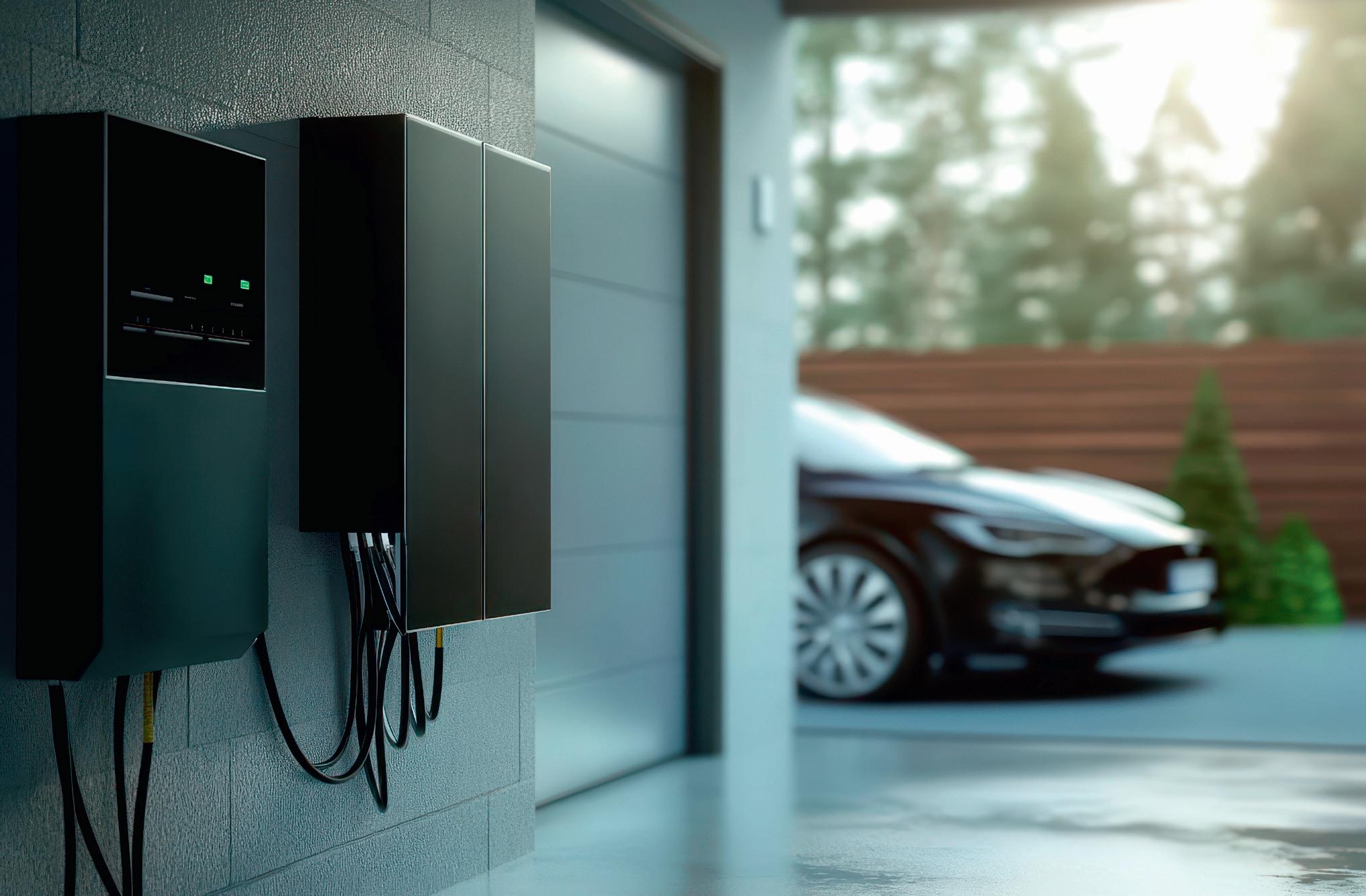
Advanced temperature sensors can detect hot-spots within the battery and the surrounding system, triggering the necessary responses to cool down or shut down the system before a fire can occur, and thermal fuses will automatically disconnect the battery from the system if it overheats - if the temperature exceeds a certain threshold, the thermal fuse melts, cutting o the power supply.
Temperature regulation plays a vital role in the performance, e iciency, and lifespan of solar batteries. Both excessive heat and extreme cold can compromise the performance of the battery. For instance, if the battery gets too hot, it can degrade faster, reducing its storage capacity and lifespan. Similarly, if it gets too cold, the battery may freeze or fail to charge.
Some systems use active cooling mechanisms, such as fans or liquid cooling, to lower the temperature of the battery. Active systems are especially useful in hot climates where ambient temperatures can reach levels that could damage the battery.
Passive temperature regulation involves using insulation or materials that absorb
and dissipate heat naturally. Insulated enclosures or heat sinks help the battery maintain a stable temperature without the need for active cooling.
In colder climates, passive heating elements or thermal insulation can help protect the battery from freezing temperatures. Batteries may also be housed in temperature-controlled enclosures to ensure consistent operation year-round.
One of the most compelling features of home solar battery storage systems is their scalability. Home energy needs o en change over time - whether due to lifestyle changes, additional solar panel installations, or the addition of energyintensive appliances like electric vehicles (EVs). The scalability of solar battery storage systems allows homeowners to start with a smaller, more a ordable system and expand it as their energy requirements increase.
This flexibility is essential for homeowners who want to future-proof their solar energy systems. As energy
One benefit of LFP technology is the long lifespan of these batteries, typically between 3,000 and 5,000 charge cycles, which means they can last between 10 and 15 years depending on usage patterns.
Other lithium-ion chemistries, such as lithium cobalt oxide, typically o er fewer cycles (around 1,000 to 2,000).
consumption grows, homeowners can simply add more batteries to their system, ensuring that they have enough storage capacity to meet demand. You may for instance start with a 5kWh pack, then e ortlessly expand up to 45 kWh, just by plugging in additional battery storage units.
Scalability also ensures that homeowners can make incremental investments in their solar storage systems, spreading out the costs over time while gradually increasing their energy independence. ■


Taking control of your home energy is easier than ever with EcoFlow. This smart system connects solar panels, battery storage, EV charging, and automation to save energy and reduce costs.


Simple, All-in-One Energy System
Unlike old setups with separate components, EcoFlow brings everything together so your home runs more efficiently.

Let AI Optimise Your Energy Use
EcoFlow’s smart AI system ensures every bit of solar energy is used wisely, whether storing power or running appliances. Over time, it learns your habits to help lower bills.






Track & Control Your Energy in Real Time
EcoFlow’s PowerInsight monitor helps you see how much energy you’re using, so you can cut costs. Smart Plugs let you control appliances remotely and schedule them to run when electricity is cheapest - all from the EcoFlow app.
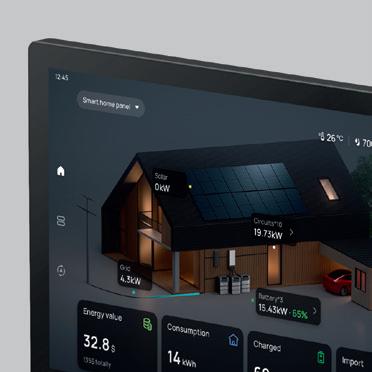


Store Solar Energy for Later
With EcoFlow’s home batteries, you can store solar power to use at night or when electricity prices are high. The batteries range from 5 kWh (for small homes) to 60 kWh (for larger households). They work with both single-phase and three-phase electrical systems, making them a great fit for any home.
Save More with Octopus Energy
EcoFlow works with Octopus Energy to help you use electricity when it’s cheaper. And from May, its new Price of Use (POU) feature will let you set a price target, so your battery automatically charges and discharges at the best times to save money.
Reliable Backup & Smarter EV Charging
If a power cut is coming, EcoFlow charges your battery to 100% automatically. Its PowerPulse 2 charger also balances solar, battery, and grid power to keep your EV topped up at the lowest cost.


















Enjoy lightweight tiled conservatory roof with a from






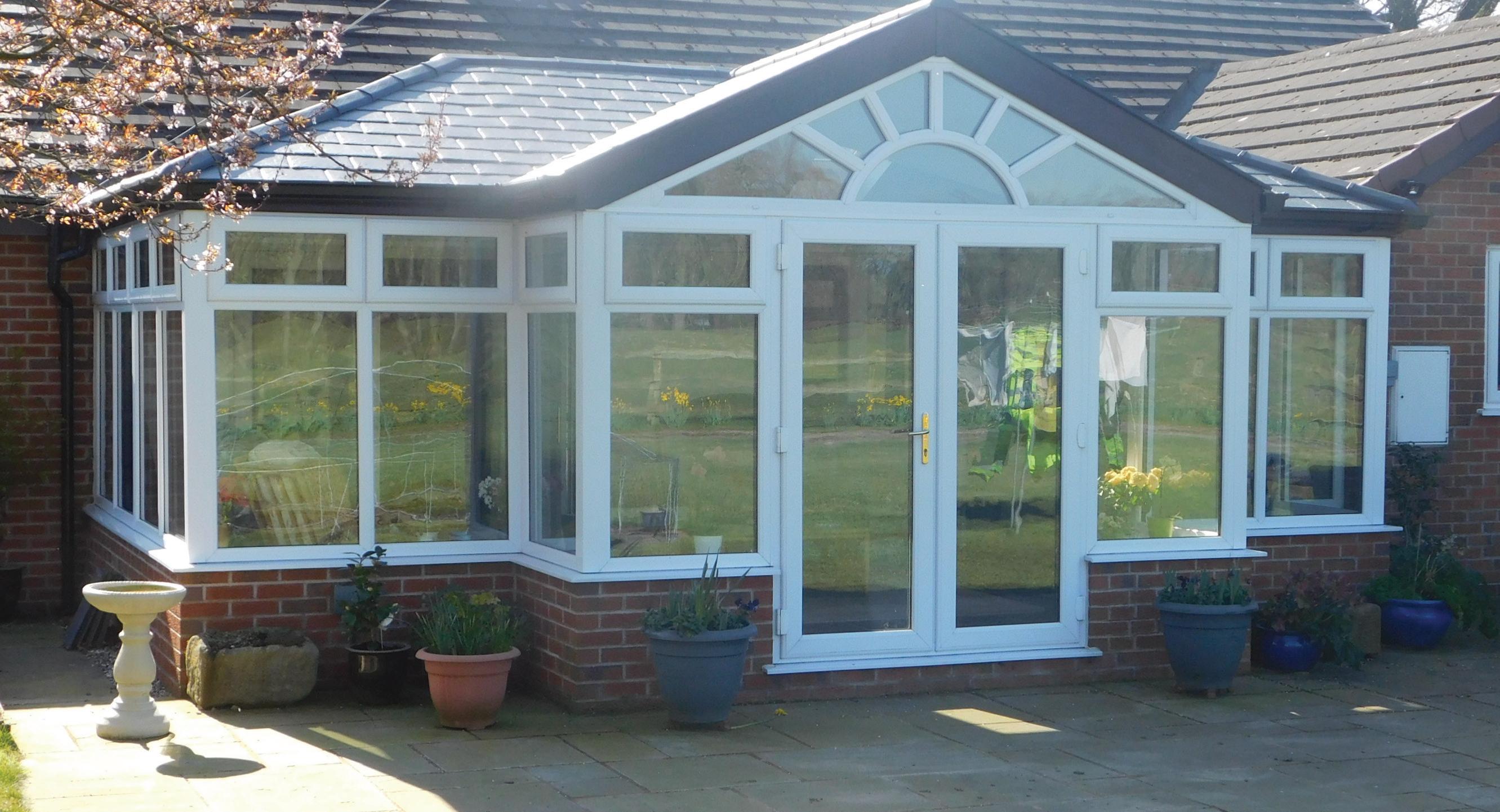
Icotherm roofs are designed to replace older glass and polycarbonate roofs and are up to 20 times more thermally efficient than polycarbonate roofs.


Superior insulation from Icotherm
Polycarbonate roof
U-Value 3


Icotherm roof
U-Value 0.15

Did you know?

The U-value is used to measure the insulation property of materials.
A low U-value demonstrates higher insulation performance.

Quick & Easy Installation
New-build & roof upgrades
Building Control Compliant
Thermally Efficient
Customisable
Eco-friendly
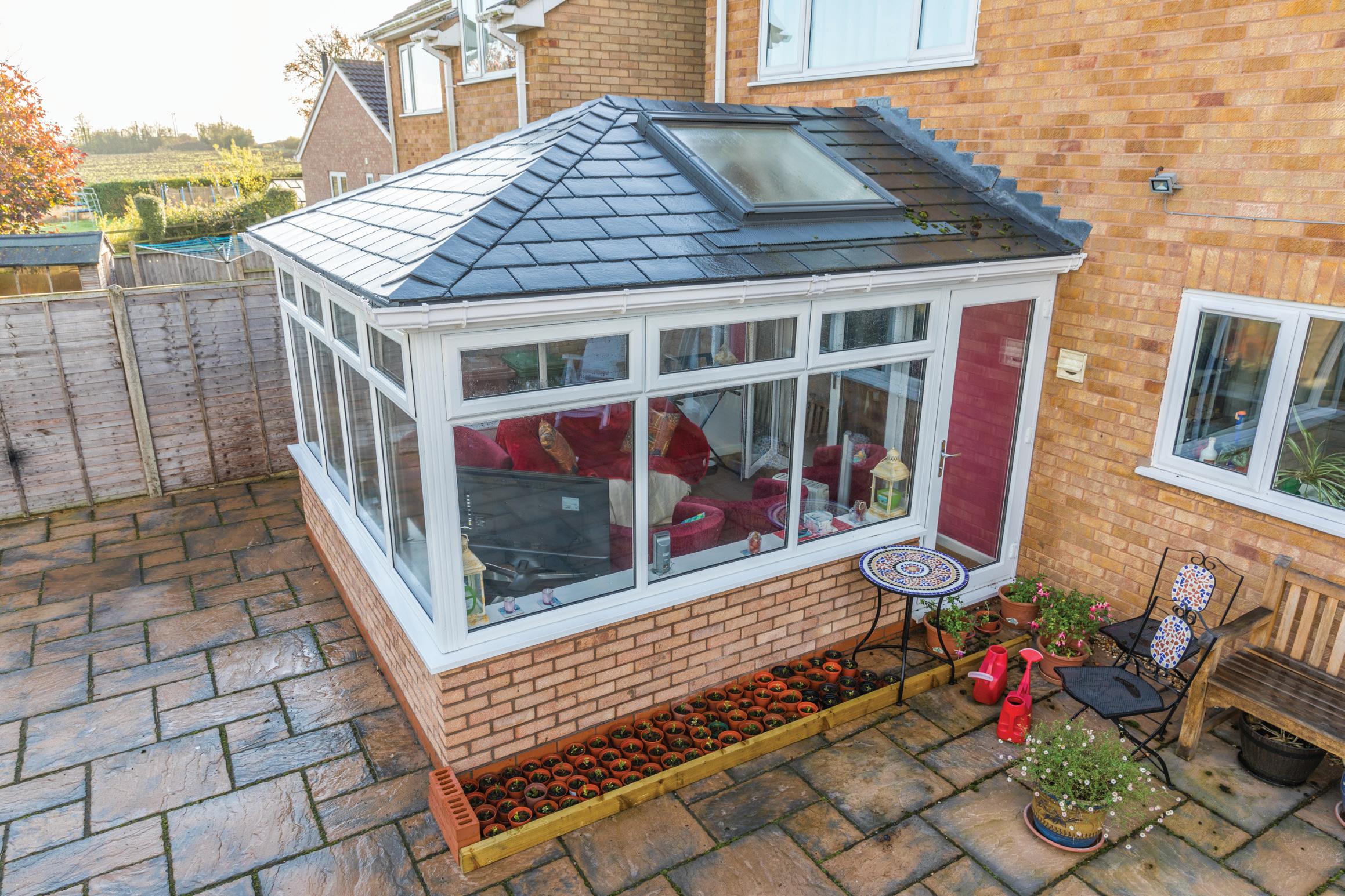
10 Year guarantee

Room temperature remains constant
WRC has a dedicated team of conservatory and orangery design and build specialists and is a Which Trusted Trader and has been trading for over 20 Years.
For more information call 0800 118 2211 windowrepaircentre.com/roofs
A conservatory is a valuable addition to any home, but without proper maintenance can be a liability
Conservatories, valuable assets though they are, can depreciate over time unless properly maintained. Whether it’s damaged glass, a leaking roof, or rotting frames, wear and tear can take a toll.
The causes of depreciation mostly boil down to weathering. Rain, snow and wind can cause seals to deteriorate, leading to leaks, which can also start around cracks in the roof or damaged guttering. Mould and damp spots in the interior are a common sign of water leakage.
Inefficient heating or cooling can make a space uncomfortable and costly to maintain, and condensation can occur when warm, moist air meets cooler surfaces, especially common in conservatories with glass roofs, as they tend to trap heat and moisture. Condensation can damage furniture, walls, and even the structural elements of the conservatory if not addressed.
The frames of conservatories are often made of uPVC, timber, or aluminium, and over time, these materials can suffer from decay, corrosion, or warping, especially if exposed to extreme temperatures or moisture. Frame damage can lead to structural instability and air leakage, further exacerbating problems.
Regular maintenance can help prevent the recurrence of many conservatory problems. Clean the gutters regularly, check seals around windows and doors, and inspect the roof periodically for damage.
The first step in any repair is to assess
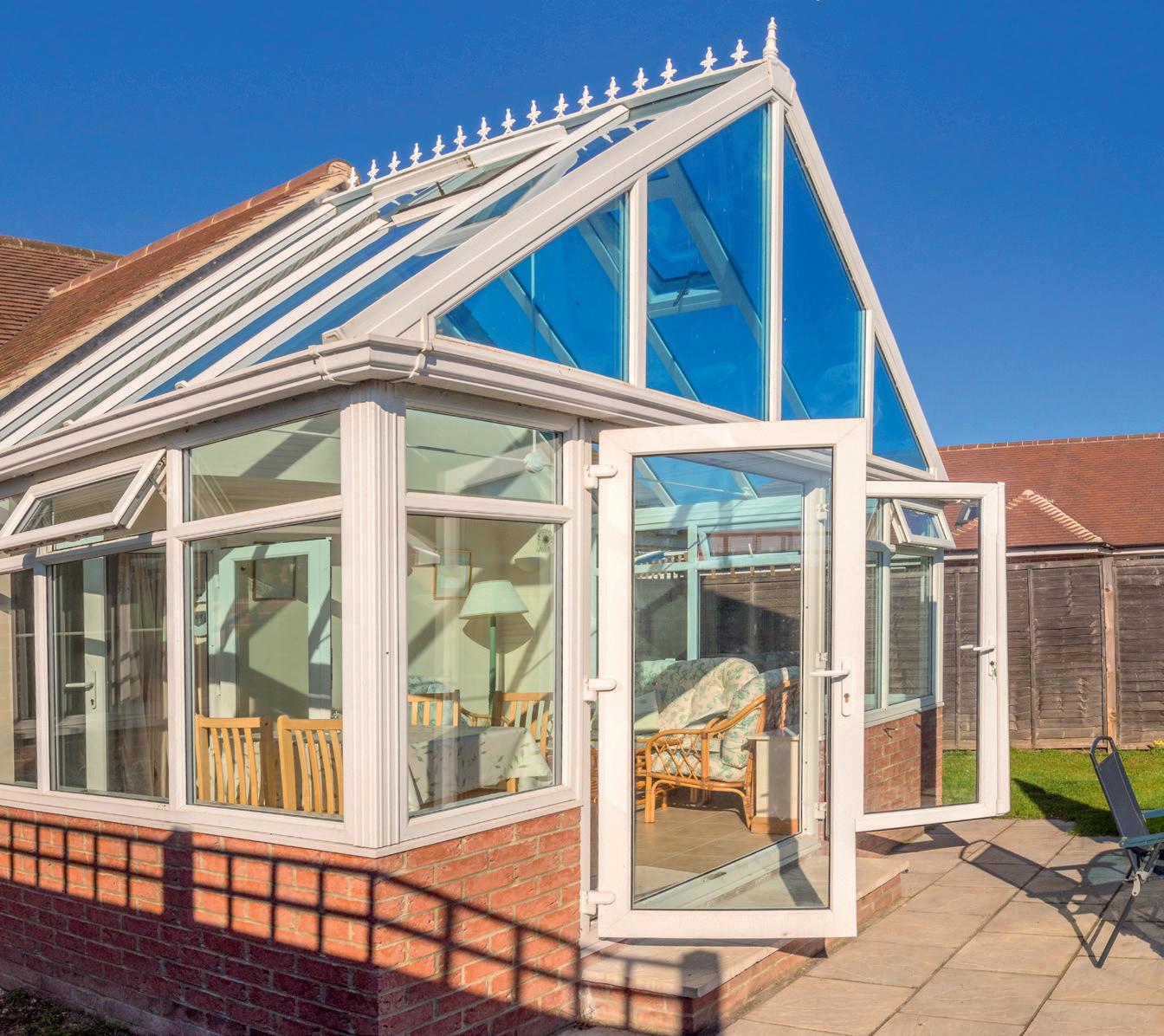
the damage. Check the roof for cracks or loose panels, inspect the frames for signs of wear, and look for any water damage.
If the roof is leaking, you may need to replace damaged panels or reseal the joints. For glass roofs, make sure to replace broken panes with new ones of the same type and size. Polycarbonate roofs, on the other hand, can often be patched with specialized sealants.
While minor repairs such as resealing joints or replacing individual panes of glass can often be tackled by DIY enthusiasts, more significant repairs, particularly those involving structural integrity, may require the expertise of a professional.
It’s worth bearing in mind that if double glazed window units have started to fail, leading to a build-up of condensation between the two panes of glass, you do not need to replace the whole window - you simply need to have the glass unit replaced, which can be done quickly, efficiently, and at a fraction of the cost.
To tackle condensation and temperature extremes, improve the insulation of your conservatory by doubleglazing the windows, replacing the roof with more energy-efficient materials, or installing thermal blinds. Adding underfloor heating or a ceiling fan can also improve comfort levels year-round. ■

Buying or selling a property abroad should be exciting — not stressful. But navigating the property market in another country comes with hidden risks, especially when it comes to exchanging large sums of money between currencies.
At EasyFX, we’ve been helping people successfully buy and sell property abroad for over 20 years, saving them thousands in hidden fees and protecting them from unpredictable exchange rate fluctuations.


Whether you’re securing your dream home overseas or transferring funds back home from a sale, EasyFX ensures you get the most from your money — with expert support every step of the way.
When selling a property abroad, you may be issued a banker’s draft. Spanish banks, for example, can charge up to 5% to cash these drafts — costing you thousands. EasyFX can help you avoid these fees and offer a preferential exchange rate.
Don’t let currency exchange costs erode the value of your property deal. Whether you’re buying or selling, our expert team is here to help you secure the best possible outcome.
EasyFX isn’t just about exchanging money — we’re about making the entire property-buying and selling process smoother and more cost-effective.


Trusted expertise – 20+ years of experience in international property transactions.
Better exchange rates – More competitive than high-street banks, with no hidden fees.
Local insight – Offices in Spain, the UK, Dubai, Thailand, Portugal, and Canada for on-the-ground support.
Personal service – Dedicated account managers for expert currency exchange guidance.
Exclusive property network – Gain access to trusted estate agents, solicitors, lawyers, and financial planners.


The example below shows how EasyFX compares to high-street banks for a £200,000 property purchase or sale in March 2025:
Exchange rates provided by banks and EasyFX fluctuate every minute. For the most up-to-date rates, speak with the EasyFX team today, and we recommend checking bank websites or contacting them directly.






















Investing in international real estate has become an increasingly popular strategy for diversifying portfolios and accessing lucrative markets around the world. Investors seek properties in locations with strong economic growth, desirable amenities, and favourable longterm outlooks. However, one of the critical factors that can significantly influence the profitability of such investments is currency exchange rates.
Exchange rates, the value of one currency relative to another, can substantially affect the cost of purchasing property, the value of rental income, and the ultimate return on investment (ROI).
Currency exchange rates fluctuate constantly based on various economic factors such as interest rates, inflation,
political stability, trade balances, and overall economic performance. For investors in international property, these fluctuations can either boost or undermine their investment returns, depending on whether the investor’s home currency is strengthening or weakening against the currency of the investment property.
For instance, if an investor from the United Kingdom is purchasing property in Australia, and the British pound strengthens against the Australian dollar, they will find that their investment is cheaper, as they will get more Australian dollars per pound. Conversely, if the pound weakens, the property will become more expensive in pound terms, potentially limiting the investor’s purchasing power or requiring additional financing.
This impact is especially significant when the investor is making a large, onetime payment for a property. In cases where an investor must exchange a large sum of money, even small movements in exchange rates can lead to substantial differences in the final price. This can influence an investor’s decision on when to make the purchase, with some opting to wait for more favorable exchange rates or hedge against adverse fluctuations.
The most immediate and tangible effect of exchange rates on international property investments is on the cost of acquiring real estate. When an investor exchanges their home currency for the currency of the property’s country, fluctuations in
exchange rates can either increase or decrease the total cost.
With EasyFX, you get expert guidance to navigate currency exchange smoothlysaving you time and money. Avoid hidden fees and make every penny count when transferring large sums for property transactions. EasyFX’s seamless, secure, and stress-free service ensures your foreign exchange needs are handled with ease. Whether you’re purchasing, relocating, or selling, they’re there to help. Make foreign exchange easy today!
Currency exchange rates also play a key role in the income generated by an international property investment, particularly if the investor relies on rental income. For example, an investor from the U.S. who owns rental property in Canada will earn rent in Canadian dollars. If the Canadian dollar weakens against the U.S. dollar, the investor’s rental income, when converted back into U.S. dollars, will be worth less.
The value of an international property investment is also closely tied to currency exchange rates. If an investor plans to
sell a property in the future, they may experience gains or losses depending on the relative strength of the currencies at the time of the sale compared to when the property was purchased.
When exchange rates move unfavourably, the investor may face a situation where the value of the property in the local market has increased, but when converted to their home currency, the total proceeds from the sale are less than anticipated. This is particularly problematic in cases where the investor is looking to repatriate the proceeds back home, especially when their home currency is weak relative to the local currency.
To mitigate the risks associated with currency fluctuations, many international property investors adopt currency hedging strategies. Currency hedging involves using financial instruments such as forward contracts or options to lock in exchange rates for future transactions. This allows investors to secure a fixed exchange rate
for a specific period, thus reducing the uncertainty around currency fluctuations and providing more predictability in cash flows and property values.
For example, an investor may choose to hedge against a potential weakening of their home currency by entering into a forward contract to exchange their currency at a predetermined rate. While hedging comes with its own costs and complexities, it can be an effective way to shield an investment from sudden and extreme exchange rate movements.
As with any form of investment, the key to successful international real estate investing is thorough research and risk management. Investors must not only consider the economic and political conditions of the country in which they are investing but also closely monitor currency trends and leverage appropriate strategies to protect their investments. In a world where exchange rates are increasingly volatile, understanding the impact of currency fluctuations on international property investments is essential for ensuring long-term profitability. ■

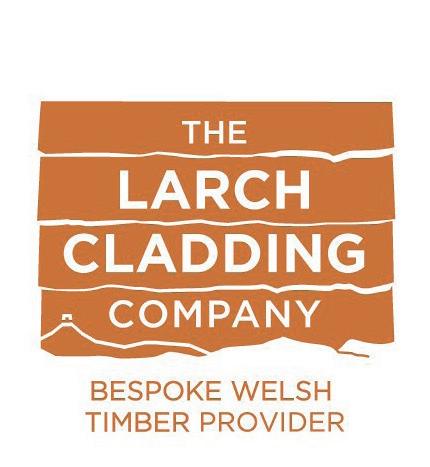
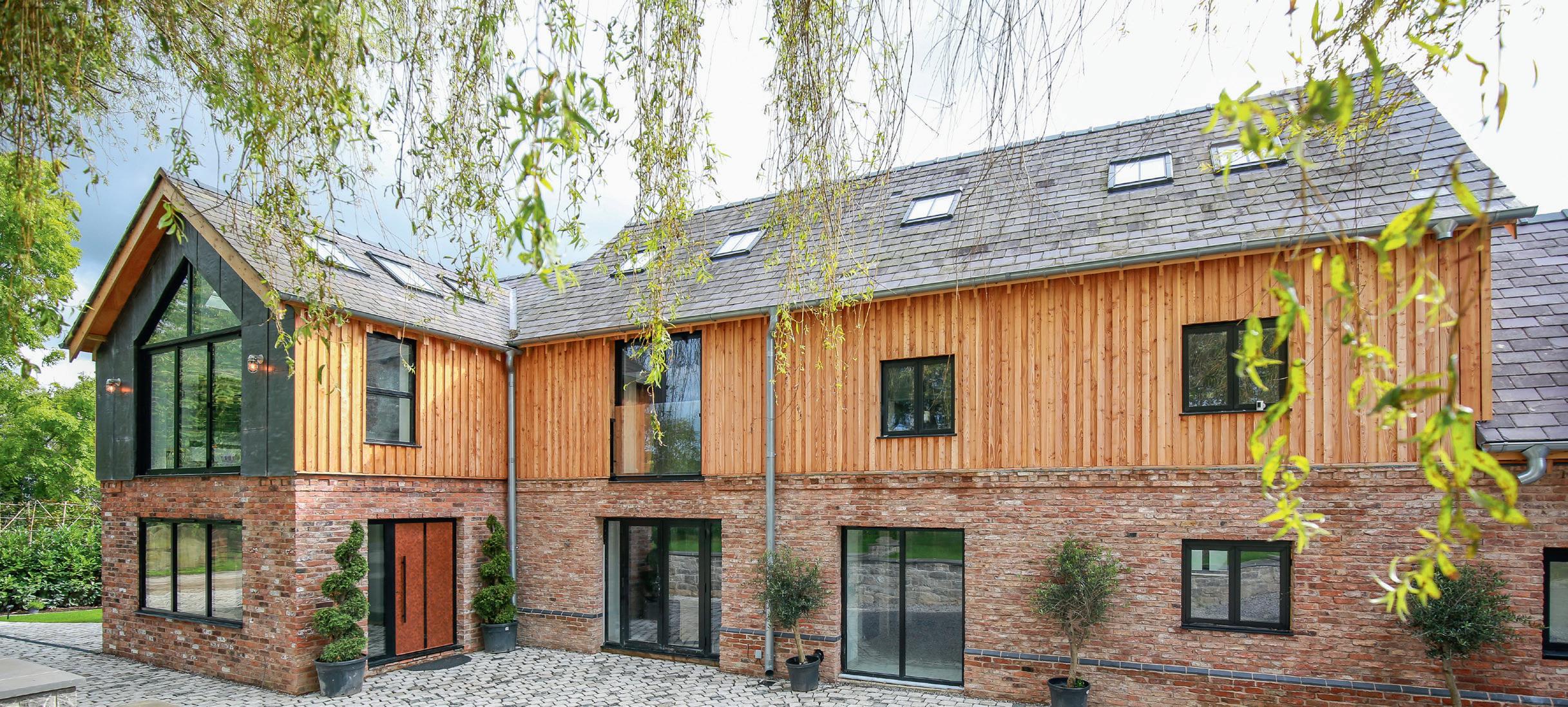
With its warm, natural aesthetic and exceptional longevity, timber cladding is a standout choice for homeowners seeking to enhance their property’s kerb appeal. At The Larch Cladding Company, we source timber from sustainably managed forests in Wales and craft it into various profiles for stunning façades, unique interior designs and bespoke garden rooms. Whatever your project, our friendly and knowledgeable team is here to help you bring your vision to life.
Welsh larch and cedar offer exceptional longevity. In addition to outstanding weather resistance, the natural oils in the wood actively repel pests. With proper installation and care, these beautiful timbers can last up to 40 years, making larch and cedar cladding an excellent long-term investment.
Timber is naturally insulating and helps regulate indoor temperatures with the seasons. Its sound-absorbing qualities also contribute to a quieter, more peaceful living environment.
The visual impact of timber cladding on a home’s exterior is striking. It adds character to both contemporary and traditional homes alike, maturing from reddish browns to distinguished silver hues to provide a bespoke finish. For a bold, charcoal aesthetic, our charred timber offers enhanced durability and superior water resistance.
All timber from The Larch Cladding Company is sourced from local, responsibly managed forests in Wales, helping you reduce travel miles and carbon emissions. We run a fully sustainable sawmill, repurposing offcuts to fuel our biomass energy system.
Explore our product range.
Larch and cedar cladding is designed to stand the test of time. When installed properly and with annual checks, it can last up to 40 years. Whether you allow it to season naturally, or rinse, oil or paint it, you can achieve your desired finish while enjoying its lasting beauty.
As well as timber façades on your house, timber-clad garden rooms can redefine your living area. From home offices to outdoor gyms, timber cladding can create stylish, natureinspired spaces for work, rest or play.
Shiplap | Rainscreen | Shingles Along with our standard sizes, we can cut timber to your exact specifications, ensuring a perfect fit every time.




To fully realise the potential of a property as an HMO (House in Multiple Occupation), investors need to carefully consider factors ranging from local market demand to regulatory compliance.


The first step in unlocking a property’s potential is to assess the demand for HMOs in your area. HMOs are typically ideal in locations where there is a high density of students, young professionals, or individuals seeking a ordable housing solutions. Universities, large businesses, and transport hubs o en drive this demand.
By understanding the local rental market dynamics


and demographic trends, you can determine whether converting a property into an HMO would be viable and profitable.
The next step is selecting the right property for conversion. Not all properties are suitable for HMO use, and factors like layout, size, and condition of the building can significantly influence the profitability of your investment. The ideal property for an HMO is typically one that has multiple bedrooms and bathrooms, which can be converted to accommodate tenants comfortably.

Investing in properties with the aim of converting them into HMOs can be an excellent strategy for maximising both value and return on investment
must meet minimum space standards and fire safety regulations.


Before converting a property into an HMO, it is crucial to understand the legal requirements surrounding the process. In many areas, converting a residential property into an HMO requires a specific HMO license from the local council. The regulations for licensing may vary depending on the number of tenants and the size of the property. Furthermore, properties intended to be used as HMOs




To maximise the return on investment, it’s important to focus on renovations that add value and appeal to prospective tenants. Upgrading kitchens, bathrooms, and common areas can increase both the rental income and the overall value of the property. Tenants in HMOs are o en looking for modern, functional spaces that o er a good standard of living while keeping costs low. Energy-e icient upgrades, such as double glazing and modern heating systems, can also add value and reduce ongoing operational costs. Additionally, creating separate living spaces with individual lockable doors can increase rental rates, as tenants are willing to pay a premium for privacy.
Once the property has been converted and is ready for tenants, e ective property management becomes key to maximising ROI. By targeting the right tenant demographic, setting competitive rental rates, and ensuring that the property is well-maintained, you can maximise rental income and turn an HMO into an excellent return on investment. ■



Beyond insuring your building works, you’ll need to think about protecting your subrogation rights.
Occasionally, clauses in a builder’s contract may require your insurance to be in joint names with the builders or contractors. This puts you at risk of not being able to take legal action against them if their actions lead you to making a claim on your insurance.
At Wesleyan, we act as a broker to find you insurance that protects your rights, as well as your home.


design?
Whether you’re scheduling an extension or making improvements, it’s important to protect your home in case things go wrong.
You may already have standard home insurance, but this often won’t cover building works, the materials used on site or potential liability exposures.

Most of us will have property and contents insurance, but not everyone realises that more specialist cover is required for building projects and renovations
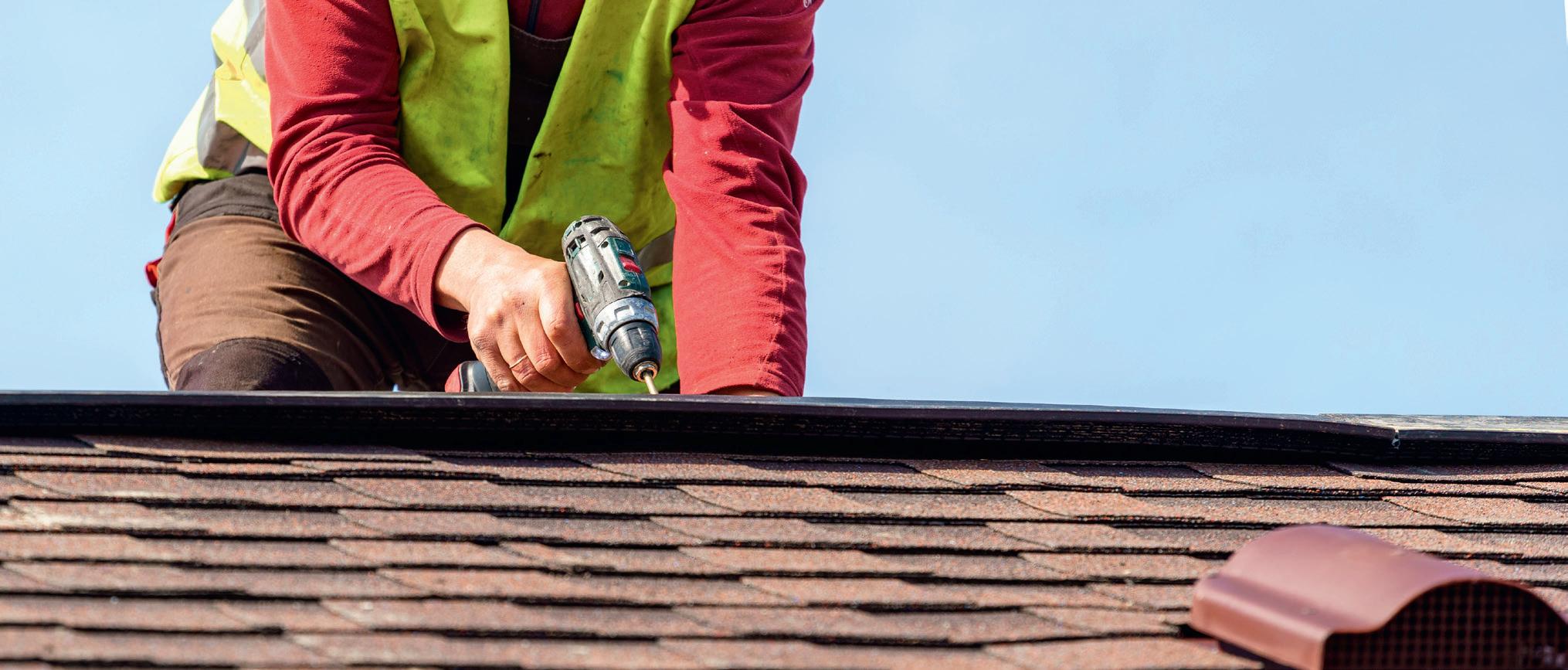
Most of us will understand the importance of property insurance, and will have our house and contents covered by appropriate policies, but this normally assumes that the building is tenanted. If it is being left unoccupied for an extended time, or crucially, if it is the subject of construction or renovation work, your standard domestic insurance may not cover all eventualities.
Most home insurance policies will not provide cover if the property has been left empty for 30 days or more. Unoccupied home insurance will provide peace of mind that your home and its contents are protected when you aren’t around to keep an eye on them.
You may require unoccupied home insurance if you are awaiting the sale of a house after moving into a new one, if the property is a holiday or second home that’s left vacant when not in use, or if you are
going away for more than 30 days.
Unoccupied home insurance will normally cover you for, say, storm, fire or flood damage, damage caused by a burst pipe, or a leakage of oil or water, a successful or attempted break-in, criminal damage to
We know that renovations can be stressful. So, whether you’re looking for temporary cover for a one-off project or annual insurance for ongoing building works, we’ve got you covered. Our friendly insurance advisers at Wesleyan Financial Services search the market and will support you in getting renovation insurance truly suited to your needs.
www.wesleyan.co.uk/renovation
the property, and damage or injury caused by a property you are responsible for, for instance, a falling roof tile striking a caller to your door. You might not be covered for damage caused by contractors working on your home, as they should have their own insurance.
This brings us to the subject of renovation insurance. Standard home insurance often won’t cover building works, materials used on site, or liability exposures. Specialist renovation insurance is available, and beyond insuring your building works, you’ll need to think about protecting your ‘subrogation’ rights - clauses in a builder’s contract which require your insurance to be in joint names with the builders. Make sure your specialist insurance advisor or broker is able to find you insurance that protects your rights, as well as your home. ■
E ective property maintenance is essential for preserving the longevity and safety of buildings, while also safeguarding the investment made by property owners














Among the various tools and techniques available for property maintenance, surveys focused on structural compliance, leak detection, building defects, and acoustics play a crucial role. The integration of advanced technology, such as data loggers, enhances the e iciency and accuracy of these surveys, ultimately supporting the long-term health of the property.
Structural integrity is foundational to any building’s safety. Structural compliance surveys ensure that a property adheres to local building codes and regulations. These surveys identify potential risks stemming from issues like foundation settling, corrosion, or material degradation. Structural surveys also help to determine if any modifications or additions to the property have been made that might not comply with original plans.
Using data loggers in structural surveys can o er real-time monitoring of stress, strain, and temperature variations in key structural components like beams, columns,














and foundations. This data provides invaluable insights into whether a structure is experiencing undue stress or undergoing gradual wear. By continuously collecting this information, property managers can make data-driven decisions about maintenance or repairs before significant issues arise.
Building defects are common in both new and older properties. These defects can range from cracks in walls and ceilings to issues with windows, doors, and electrical systems. Regular surveys focusing on building defects are essential to identifying problems that might otherwise go unnoticed.
Water intrusion is a major concern for property owners, as leaks can lead to a host of problems, including mould, wood rot, and electrical hazards. Leak detection surveys use specialized equipment to identify areas of water infiltration within a building. Traditional methods o en involve visual inspections and infrared







thermography, but integrating data loggers into the process allows for more precise, continuous monitoring.
Acoustic surveys are crucial for ensuring that a building provides a comfortable and quiet environment for its occupants. Problems with sound insulation can lead to noise pollution, which can a ect both the mental and physical well-being of residents or tenants. Regular acoustic surveys assess the e ectiveness of soundproofing materials, ventilation systems, and other components that impact noise levels.
Data loggers are increasingly used in acoustic surveys to monitor sound levels and vibration over extended periods. This data can be used to assess compliance with local noise ordinances or to evaluate the e ectiveness of soundproofing measures.
Maintaining property requires a proactive approach, but by incorporating technology into property maintenance, property owners and managers can reduce costs, extend the lifespan of their assets, and create safer, more comfortable environments. ■































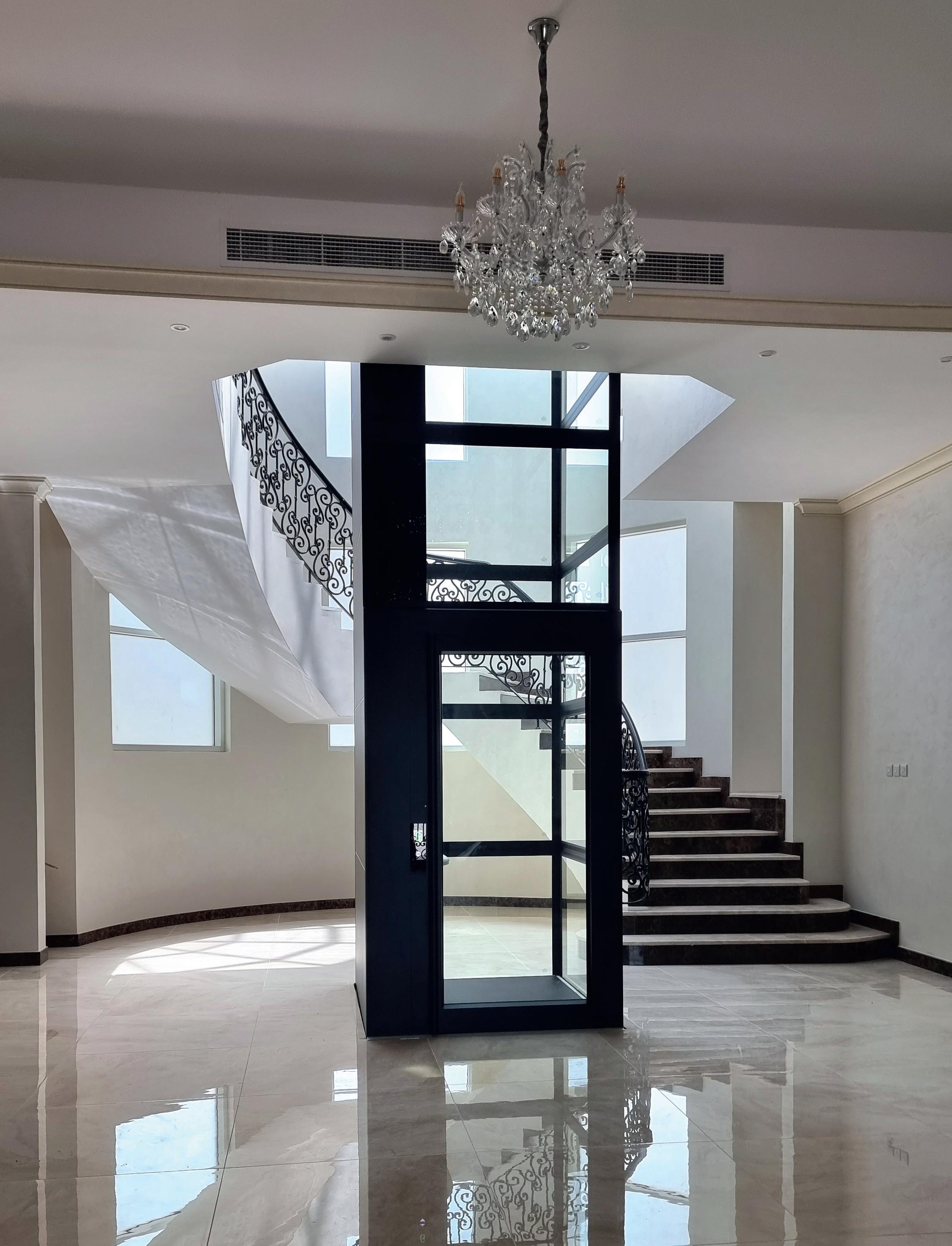
Home lifts are becoming more practical and affordablecould they be a better bet than a stairlift in your house?
Mobility problems in later life, particularly for people who live alone, can mean that their homes become difficult to navigate; particularly if they are on two floors, and the stairs are difficult. There just aren’t enough bungalows to satisfy demand, and in any case, you may not want to move out of your familiar home.
So what can you do if one or more of the occupants of your home has difficulty with the stairs? A common solution is a chairlift; easily fitted and customised to the shape of your stairs, chairlifts are a great solution for many. But is there a better one?
You could contemplate putting in a home lift. Dismiss thoughts of huge clanky cabinets with folding steel gates; modern home lifts are advanced in technology and design, and unlike chair lifts, can actually enhance the appearance and appeal of your house.
A typical “residential elevator” travels smoothly and quietly on vertical rails through a hatch in the floor above. Travel distance is typically around four metres, but bespoke models can offer distances of as much as 13m, with a number of stops. Because the rails are usually against the wall, the lift mechanism isn’t in your way when the cabinet is on the other floor.
Home lifts come in a number of different designs including partially or fully enclosed cabinets. One big advantage over chairlifts is that lifts can be big enough to take more than one person, or a wheelchair. They will be fitted with backup battery power so in the event of a power cut they can be returned to the ground floor and the door opened manually, and optional extras sometimes
include a built-in phone, adjustable lighting, a tip-up seat and so on.
It takes a couple of days to fit a home elevator, and it can usually be done without planning permission or much disruption to existing decoration. They can take up less than a square metre in space, and common options include fitting them from a downstairs living room straight up into the master bedroom, in a stairwell void to the upstairs landing, or even in a cupboard. They are usually self-supporting so need no load-bearing walls, and some designs can be fitted to the outside of buildings, and also have applications in cases such as underground car parking.
So, could a home elevator give your life just the lift you need?
Though the cost of a home elevator will vary according to the requirements and the technology used, to give a rough idea of cost, a one-floor lift can be manufactured to order within a few weeks, may take only a day to install, and might cost from around £12,000. You will of course pay extra for additional features and customisation.
For a few thousands extra, you may get a better choice of finishes and colours, and additional floor capabilities, perhaps up to six floors. Of course, the number of floors very much affects the cost because of the fittings needed on each floor.
A pneumatic, or vacuum, elevator moves the cabinet using changes in air pressure. It does not require construction of a pit, shaft, or machine room. A pneumatic elevator can be attached to a balcony or travel through a hole in the floor.
A vacuum elevator designed to carry a single passenger up to three stops will be suitable for most homes, requiring as
little as under one square metre of space. Vacuum elevators are an environmentally conscious option requiring minimal floor space and no pit below, and run completely on the power of air, offering a quiet, eco-friendly accessibility solution.
Vacuum elevators though do have some disadvantages; they tend to be slower and smaller than hydraulic elevators, will carry less weight and must be circular in shape. They cannot be concealed so they will always be a visible feature of the home. If there is a power cut, they will automatically descend to the lowest floor, which is a good safety feature unless, of course, there is a fire on the lowest floor.
A hydraulic elevator lifts the cab using a hydraulic ram, a piston inside a cylinder that is driven by a hydraulic fluid, typically oil. A pump forces fluid from a tank into a pipe that leads to the cylinder. If the valve is closed, the fluid is forced into the cylinder, which pushes a piston up and raises the elevator cab. When the valve is opened, the hydraulic fluid flows back into the reservoir and the cab descends.
Hydraulic elevators consume oil and need more frequent maintenance than other types of elevators. While they are more expensive than other types, hydraulic elevators offer quieter and smoother operation. Some hydraulic elevators require a pit and machine room.
Hydraulic elevators are more expensive than vacuum elevators, and may take longer to install. However, they have advantages in terms of size, weight carried, and speed. Hydraulic elevators also have more options for shape than vacuum elevators, and are quieter in operation, though they may cost more to run. ■
No two homes are the same. Now, home lifts can reflect your own space’s uniqueness.
A special feature from

Home lifts have an unfair reputation in the UK. Unlike in many European countries, a home lift is often viewed as a last resort caused by accessibility issues or ageing. On the contrary, the right lift in your home can be a centre piece that adds value to your home.
The home lift has undergone a great change in recent years, making it more appealing to those who are looking for a lift that matches their luxurious lifestyle. Today’s lifts look more modern with innovative designs. It is even possible to fully customise a lift so that every detail matches the aesthetics in a home.
Previously, lifts were designed purely for practicality, to transport people from one floor to another, but times have changed. Today, comfort and design are one of the focus areas when designing a new lift. Designed to run whisper quietly, and using minimal energy to run, the Cibes Air home lift can be customised to fit any decor, available in a wide range of colours and surrounded by a breathtaking glass shaft that opens up the space in your room. Back panel finishes are available in anything from bamboo to oak and even wool.
A home lift can also keep you in your home for longer. With an ageing population, and bungalows available only at a premium, a home lift adds a practical solution that requires little building works to put in place. They can even take up as little space as a wardrobe. Increasingly, Brits are seeking home lifts as an attractive option to futureproof their homes, whether they have immediate needs or otherwise.
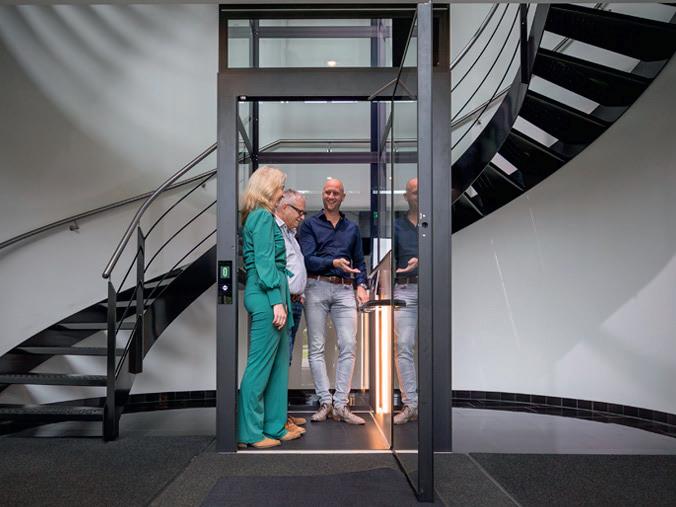

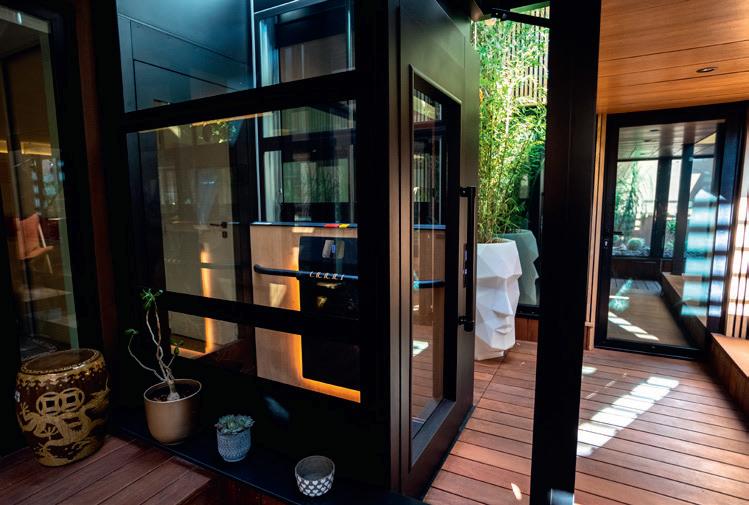
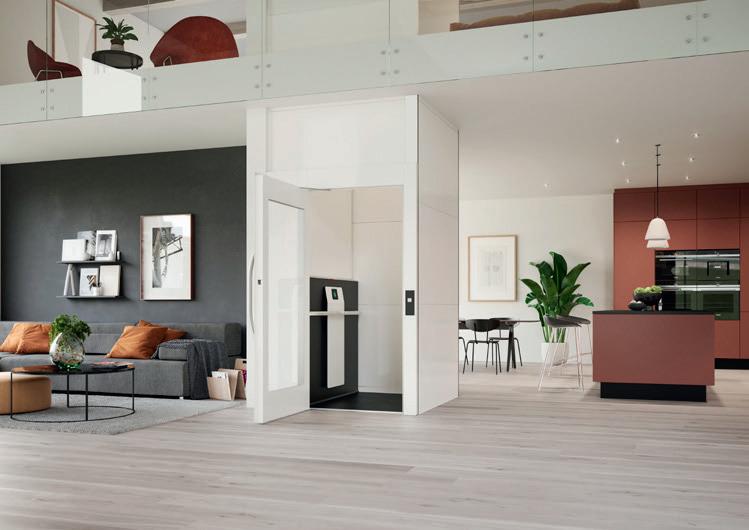
Cibes Lift Group has been manufacturing and providing platform lifts for public and private environments for over 75 years. At Cibes Lift UK, we’re passionate about manufacturing, installing and maintaining home lifts that transform our customers’ properties and lives. We have offices in the Midlands and South East with a team ready to help you across the UK.
0800 085 0269
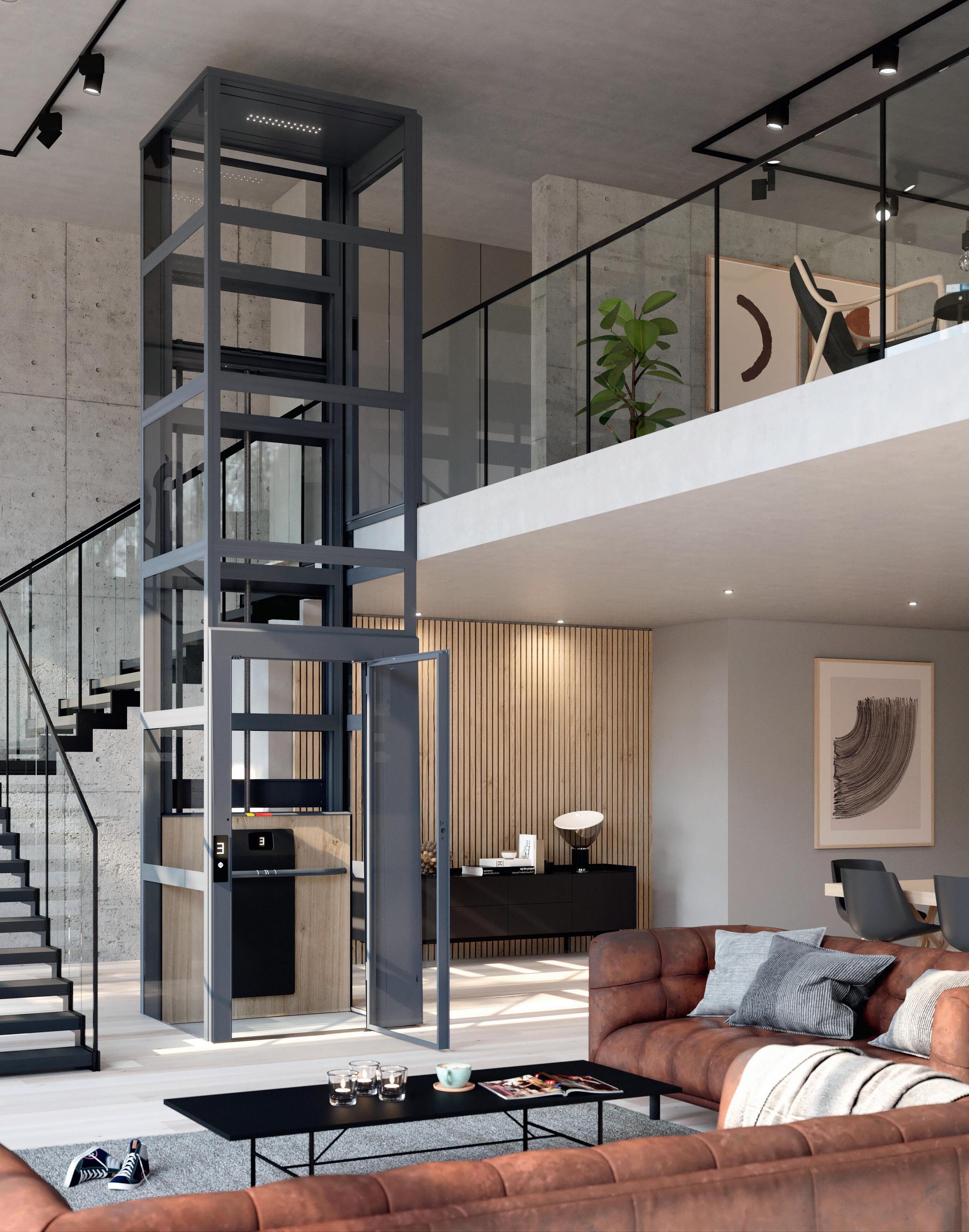
Not all lifts are made equal. A Cibes lift in your home is a statement. A centrepiece.
Whether you have an immediate need or would like to future proof your property, it’s time to... Customisable,
and space-saving, your lift will be made to suit you.




With fraud on the rise, it’s more important than ever that you can verify the identity of your tenants and check their documents are genuine
Property fraud is on the rise, and scammers are getting more and more ingenious in the ways they try to fool property owners. For instance, purchasing property is a common method used by organised criminals to launder the money made from criminal activity.
The size of the property market in the UK, along with the high value of property assets, means that criminals can “clean” large sums of money in a single transaction, so digital identity and verification software is now used widely by estate agents, conveyancers, recruiters, accountants, and corporate services.
Estate agents are legally required to carry out anti-money laundering (AML) checks and customer due diligence in accordance with the Money Laundering Regulations 2017. If they fail to do so, they could be fined, suspended from practising, or even be liable for criminal prosecution.
Tim Barnett, CEO of Credas, says:
“While there’s no doubt that AML checks are a necessity, they can also slow down transactions and frustrate genuine customers. In an increasingly digital world, we often take trust for granted, relying on a person’s honesty but criminals are using more and more sophisticated methods to target the property sector.
“At Credas, we harness cutting-edge technology to discreetly verify someone’s identity, ensuring your customers feel like superstars, not suspects.”
Some money laundering warning signs to watch out for include cash buyers who are vague regarding the source of funds, suspicious funding sources such as an unknown third party or funds from multiple sources, and inconsistencies or hesitations in the information provided, or a client being reluctant or refusing to provide information for a sale.
Another area where scams are on the
increase is identify fraud. Here, technology can provide real-time document verification, a fast, secure way of instantly checking the authenticity of documents such as passports, driver’s licenses, and other IDs. It uses smart algorithms to analyse features like watermarks, holograms, and barcodes to spot signs of forgeries or tampering.
In addition to these methods, NFC (Near Field Communication) document verification improves security and speed. NFC-enabled documents, like passports and national ID cards, contain embedded microchips that store encrypted biometric information. This combination of real-time document verification and NFC technology makes ID verification quick and hassle-free, so users don’t need to send physical documents or wait for long reviews, reducing fraud through a smooth, convenient experience, streamlining verification and protecting you against sophisticated fraud attempts. ■












Streamline your customer due diligence with the UK’s leading ID verification provider.
UK Government-certified IDSP
Highest-rated ID verification app in the UK
Real-time AML screening
Biometric facial recognition & NFC chip verification
Remote and in-person checks
Fully branded customer portals STREAMLINE YOUR
The Renters’ Rights Bill represents one of the biggest legals changes in property in 30 years. What does it mean for renters and landlords?

The Renters’ Rights Bill is an extremely important piece of legislation for anyone who rents their home. For those in England (with some elements also covering Wales and Scotland), it represents one of the biggest changes in well over thirty years, and it’s important to be aware of what it might mean to you if you are a renter.
The UK Government’s aim is to give renters much greater security and stability so they can stay in their homes for longer.
Propertymark, the professional body for the property sector, has worked closely with the UK Government to help ensure the new legislation is fair for
both tenants, who rightly should have access to a safe and secure property, and landlords to ensure they have the ability to deliver a sustainable mix of high-quality properties to let.
Renting a home has become extremely popular across the last twenty years, so it’s vital there is strong and dynamic legislation that keeps pace with the challenges faced by an ever-growing population. Achieving the right balance to keep everything running smoothly is complex, especially with such unevenness within the wider economy directly affecting the affordability of many renters and the economics of being a landlord.
The legislation is now at Committee Stage in the House of Lords and is very close to becoming law. Committee Stage involves Peers in the Lords examining the separate parts of a Bill line by line for around eight days, but sometimes proceedings can last much longer than that.
The new legislation is designed to bring greater levels of protection for those who choose to rent their home across England, with measures to prevent discrimination against renters on benefits or with children also applicable in Wales and Scotland.
The new law aims to end ‘no fault’ evictions, often referred to as ‘Section
21’ proceedings, whereby a landlord can obtain a court order to regain possession of their property without needing any specific reason. The change in law also aims to ensure it is easier for those with children and pets to reside at rented properties. In addition, there are plans to introduce a ‘Decent Homes Standard’ to safeguard a higher minimum legal standard for properties within the rental system.
The new Bill will also extend Awaab’s Law to the private rental sector. Awaab’s Law was implemented for the social rented homes following the death of Awaab Ishak, who died at the age of two when a social house he and his family were living in suffered from extreme issues with mould.
The Bill also aims to ensure there are new rules that landlords must comply with to guarantee their tenants have a better experience of renting, while at the same time ensuring that landlords can regain their properties in extreme circumstances.
Backdoor evictions should become a thing of the past if the Renters’ Rights Bill becomes law in its current format, as tenants will be better protected from excessive rent increases.
There will also be a Private Rented Sector Ombudsman and a Private Rented Sector Database to help implement fairness for all parties. Like all Ombudsman services, it will aim to independently resolve disputes. The planned Landlord Database will help keep track of landlords and their legal obligations to operate.
Tenants receiving benefits and those who have children and/or pets will no longer face discrimination.
In addition, any possible bidding wars between potential tenants will be outlawed, meaning landlords and letting agents will be legally required to publish an asking rent for their property. They will also be banned from asking for, encouraging, or accepting any bids above this price.
Local councils’ enforcement powers will be increased by expanding civil penalties and a fresh package of investigatory powers and rent repayment orders will also be introduced for landlords.
There are many steps all new pieces of legislation must take before they ever pass into law. Prior to final ‘Committee Stage’ in the House of Lords, which is where the Renters’ Right Bill was due on 22nd April 2025, proposed new laws must pass through a First Reading in the House of Commons, which is a formality that involves no debate, and then a Second Reading, which is the first opportunity for MPs to debate the main principles of the Bill.
One provision that is contained in the Renters’ Rights Bill is ending fixedterm tenancies. That may sound good in principle, but for students, it could have unintended negative consequences.
On 20 October 2024, Propertymark reiterated its concerns to the Secretary of State for Education, the Rt Hon Bridget Phillipson MP, that periodic tenancies (where there is no fixed end date) could result in graduates staying at a property, which would then affect new students being left with fewer properties to rent or with no place to stay in while embarking on their studies.
Propertymark is campaigning for fixed-term tenancies to remain an option for student landlords especially.
The Renters’ Rights Bill will also mean that people may be prevented from paying for rent in advance for a duration of more than one month. This is an aspect that could seriously impact access to housing for those who are both willing and able to pay ahead of time but might not achieve a traditional monthly rental agreement due to past credit history searches.
The professional body also suggested that the UK Government consider the effect any delay in welfare payments could have on rent arrears, and to regard the financial consequences of this legislation on the supply of homes to rent when the Bill had its Second Reading in the House of Lords on 4 February 2025.
Nathan Emerson, CEO at Propertymark, comments: “The Renters’ Rights Bill will bring about huge changes to the way people rent across the country. Both tenants and landlords need to understand
the new rules and how it will impact them. Propertymark member agents are trained and qualified to stay on top of legislation and how it works in practice. Landlords should start to plan now about the longterm use of their property and tenants need to understand that their tenancy and the rules around leaving a rented property are changing. As the legislation starts to come in later this year, tenants and landlords should look for the logo and a certified and accredited Propertymark agent who can give them the protection and peace of mind they need to understand what happens next.” ■
Propertymark is the leading professional body for estate and letting agents, commercial agents, auctioneers, valuers and inventory providers comprising 18,000 members. It is member-led with a Board which is made up of practicing agents and works closely with members to set professional standards through regulation, accredited and recognised qualifications, an industryleading training programme and mandatory Continuing Professional Development.
Members benefit from guidance, advice, and research as well as a comprehensive programme of workshops, conferences and events and Propertymark regulates members’ activity according to a code of conduct and rules, with disciplinary action for instances of non-compliance.
Propertymark launched in February 2017 combining ARLA, NAEA, NAVA, ICBA and APIP - groups dedicated to promoting high industry standards for over 50 years. Members are practising agents helping people to buy, sell and rent their homes every day. www.propertymark.co.uk
In the current market, it’s hard to decide whether to move house, or to improve your existing property. So, what are the pros and cons of each?
If you’re one of the thousands of homeowners who are trying to decide whether to move house or to improve your existing property, you will know that all sorts of factors come into play, and the decision is rarely easy.
Sometimes it’s forced on you – such as if you’re moving for a new job – but in other cases, such as making room for a new child, there can be pros and cons to both moving and renovating.
So what are the main points to consider?
For many people the most important deciding factor will be cost. A renovation project such as an extension, loft conversion, basement conversion or energy retrofit will normally be cheaper than moving house, but not necessarily once you have factored in professional costs of surveyors, architects and builders. Projects can easily go over-budget. Yet sometimes, depending on where you are moving from and to, you can actually make money
on a house sale, rather than it costing you anything.
Obviously, meticulous planning of a renovation project should give you a good idea of the cost, but things can change; you may find structural problems with the property once the work starts, you may have problems with suppliers or materials, or you may decide to enhance the renovation in mid-project. Remember Cheops’ Law: “Nothing ever gets built on schedule or within budget.”


If you are renovating your home with a view to selling it, be sure that your money is well spent; there’s many an anecdote of a house with a brand-new kitchen or central heating that was demolished because the buyer really wanted the land.
Always remember the hidden costs of renovating or moving; if you have to move out of your house for extensive rebuilding you may have to pay for temporary accommodation or storage, and if you are buying a new house, there are all sorts of costs to consider on top of the price of the new house, such as fees for mortgage arrangement, valuations and surveys, stamp duty, conveyancing, and land registry. All this, plus the actual moving costs, and any redecoration you may want to do in the new house.
2. Location, location… and, oh yeah, location
Don’t underestimate the value of the location of your current home. If it’s convenient for your work, for your kids’ school, for the shops, for nearby family, or for local facilities, can you really do better? You could move for one reason, but find that
your new location is less good for loads of other reasons. If you are inclined to move, make sure that you aren’t taking a step down in terms of convenience.
On the other hand, if you are nowhere near a school, but are thinking of having children, making a move to an area more convenient for schools would be a good investment for the future.
Some people get very attached to a house, either for family or other reasons, and just find they aren’t happy once they have moved. If you think that you might always be pining for your old home or area, put more thought into renovation. There are often ways to solve potential building problems that you may not have thought of at first.
4. Permissions
You may be full of great ideas for renovating your property, but are they practical? Internal changes normally require no planning permission, but structural changes such as knocking down walls or adding doors, not to mention building extensions

“If you are thinking of buying a property in need of renovation as an investment, in most cases you do find that a home that has been extended or improved to a high standard will command a higher asking price than its neighbours. Alternatively, if you want to live in the property, you may end up spending a similar amount in total, but you will be living in exactly the property you want rather than having to compromise.”
or converting lofts, may well require planning permission, which can be an expensive and long drawn-out process. You will need professional legal and planning help if you plan to do anything substantial, and in some cases, such as listed buildings or those in conservation areas, you may be limited in what you can do.
While renovating your home makes it really work for you and your family, it can also add value should you decide to sell at a later date. Be aware of the ‘ceiling price’ – the maximum amount a similar property has sold for in your area.
On the other hand, if you move to new home, you could find one which overcomes the problems of your old house, and offers more modern and attractive features –such as better energy efficiency and more modern fittings. ■


From style advice to winged pests and home lifts to security systems, the latest products and services in the home market
Milan Design Week and Salon del Mobile are arguably the events of the year in the global design calendar, attracting hundreds of thousands of designers, curators, buyers, editors and visitors. We asked three top designers what ideas they took away from the shows.
“Playful Maximalism is exactly the energy we need right now - it’s fearless, full of personality and totally liberating” says Gavin Farrington, head of design at luxury tile, bathroom and kitchen design centre ROCCIA. “And we’re embracing it wholeheartedly, especially in kitchens and bathrooms, where people are traditionally a bit more reserved. There’s a definite shift towards bold tile choices, expressive textures and unexpected colour pairings”
Shiny chrome, aluminium, and mirror finishes were everywhere this year, from Hiroto Yoshizoe’s glimmering ‘ubique’ lights to Nilufar Depot’s entire ‘Silver Lining’ concept. Lucy Mather of Arighi Bianchi believes that this is a trend that’s already gathering pace in UK interiors. “There are so many new and exciting products coming through into UK stores that will see reflective metallics become a real game-changer for British interiors” she says.
Megan Baker, head of design at My Fitted Bedroom adds: “To see Milan Design Week shine such a strong light on craft and heritage, local materials, and timeless design values really resonated; furniture design is all about creating pieces with purpose, precision and personality. Comfort is a huge part of it. It’s not just how something looks, but how it works for the way you live.”

The eufyCam S3 Pro is equipped with a 4K ultra-clear camera that delivers daytime-like clarity even in low-light conditions. It accurately captures both large and small details, providing e ective monitoring. Powered by solar power, it’s low-maintenance and ensures you get round-the-clock protection for your home. www.eufy.com

Stannah Homelifts are designed to make life easier. If stairs are becoming a challenge, enjoy seamless, safe, and comfortable access to every floor of your home. Experience independence and peace of mind with a lift tailored to your needs. www.stannah.com
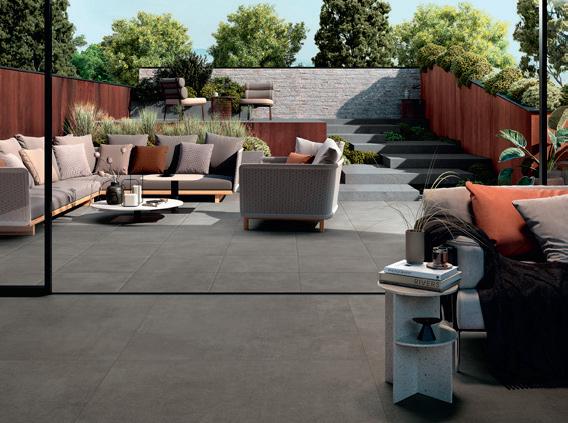
Construct is a porcelain collection with a smooth concrete-e ect look. Available in various colours, sizes, and finishes, it creates a stylish, contemporary backdrop. It’s suitable for both inside and outside, creating a seamless transition for indoor-outdoor living. solusceramics.com
Following recent news of property buyers suing their seller who has neglected to tell them that the property was infested by moths, experts at British Pest Control Association (BPCA) are advising householders to call in a professional if they suspect textile moths are infesting their home.
While they are not dangerous, the larvae of textile moths will feed on natural fibres causing damage to personal items such as clothing, bedding, soft furnishings, curtains and carpets. There are more than 2,500 species of moth in the UK and only a small number are considered to be a pest, so a sighting of one or two moths is no cause for alarm.
Niall Gallagher, Technical Manager at BPCA said: “Moths don’t spread disease and don’t bite – many don’t even have mouths. But the greedy grubs of some moths can cause significant damage to property as they feast on natural fibres such as hair, wool and cotton as well as animal-derived textiles such as fur, hides and feathers”
For more advice see the guide at bpca.org.uk/moths
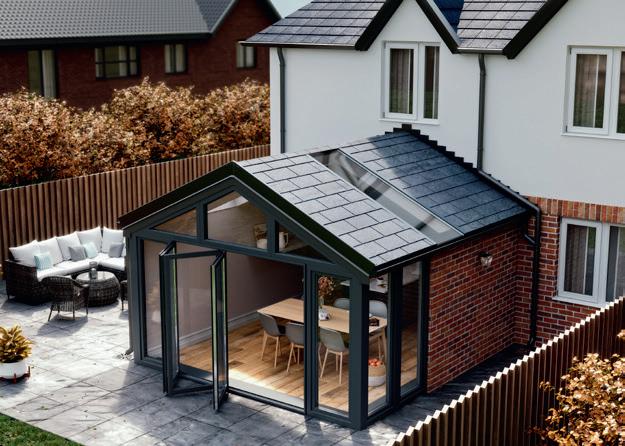
Transform your conservatory into a room you can use all year round, with a stylish Icotherm lightweight tiled roof. These modern replacements for conservatory roofs, will keep your conservatory warmer in winter and cooler in summer.
windowrepaircentre.com



Loft boarding is a practical and cost-effective solution for creating additional storage space. It provides a safe, accessible area for storing belongings while also protecting your home’s insulation, helping maintain energy efficiency by preventing insulation compression. offer.access4lofts.co.uk
For a refreshing break from your decorating work, try the range of refreshing Thai fruit drinks and beverages from brand Foco. Choose from a variety of flavours including mango, guava, lychee, passion fruit juice drink, and more! Also available are Foco’s aloe vera juice drink and coconut water. www.chadhaorientalfoods.co.uk
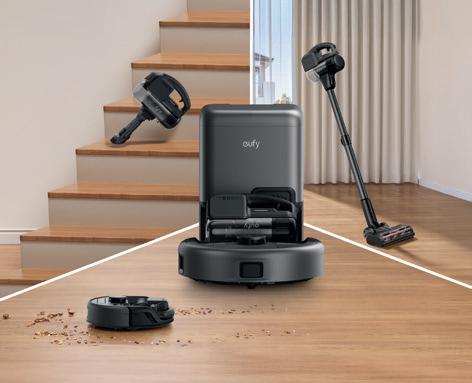
The eufy E20 is a versatile 3-in-1 cleaning solution that combines robot, handheld, and stick vacuum modes in a single device. Ideal for tackling a range of cleaning tasks - from floors and stairs to tight corners - its compact design helps save space while delivering an impressive 30,000 Pa of suction power. With automatic dust disposal and a low-maintenance cycle of up to 75 days, the eufy E20 takes the hassle out of cleaning, offering truly hands-free, whole-home cleanliness.
www.eufy.com

Take a break from the building with a filling meal of Indomie Noodles. Indomie Mi Goreng are the first and original Indonesian Mi Goreng noodles. First produced in the 1970’s with the launch of classic Chicken Flavour noodles, Indomie has become a household brand name that is loved by everyone. Try some today! indomiedirect.co.uk
William Morris is one of the biggest names in interior design today, despite having died in 1896. A new exhibition examines the eternal appeal of his work

William Morris (1834-96) has ‘gone viral’. The English textile designer, poet, artist, writer, and socialist activist, mainly associated with the British Arts and Crafts movement, was a major contributor to the revival of traditional British textile arts and methods of
production. His literary contributions helped to establish the modern fantasy genre, while he campaigned for socialism in end of the century Great Britain. Today, we find his botanical patterns reproduced endlessly on everything from shower curtains to phone cases, and in all corners of our homes.
Open since 5th April 2025, during the 75th anniversary year of William Morris Gallery in Walthamstow, Morris Mania is a major exhibition showcasing the remarkable versatility and lasting influence of William Morris’s designs in popular culture, both in Britain and abroad.
One of our greatest designers, Morris argued that beautiful objects could only be created through a responsible and close relationship with the natural world and enjoyable, creative working conditions. These principles continue to influence subsequent generations of designers, makers and consumers today, though the exhibition will explore a complicated legacy - over 125 years since his death, Morris’s work continues to grow in popularity, and his patterns are now affordable, well-loved and available to people across the globe, something he failed to achieve in his lifetime. However, this has been achieved in the context of mass production, computergenerated design, global capitalism, and environmental crisis.
Morris Mania will consider the
ongoing impact of Britain’s most iconic designer in our increasingly cluttered and commodified world.
Objects from William Morris Gallery and private and public international collections will include a ‘Rose’ patterned seat from the 1980s British Nuclear Submarine Fleet, ‘Willow’ pattern Nike trainers, and Loewe fashion inspired by Morris’s designs. The exhibition will also feature Morris-patterned objects donated by the public. Revealing how the designer’s work has permeated our everyday lives, visitors are invited to continue to lend and donate their own Morris-print objects throughout the course of the exhibition. Morris-patterned donations to date include chopsticks, a waving cat from Japan, hand-embroidered wedding jackets, Wellington boots and an array of mugs and biscuit tins.

A highlight of the exhibition will be Wallpaper (2025), a newly commissioned work by archive documentary filmmaker Natalie Cubides-Brady, exploring how William Morris’s designs have been used in screen history. A montage of scenes from film and TV will reveal the diverse and sometimes surprising range of narratives, settings and moods that Morris designs conjure up. Cameos in everything from My Fair Lady, Sunday Bloody Sunday and Django Unchained, to Gogglebox, Coronation Street and Peep Show, highlight how Morris designs form part of the fabric of 20th- and 21st-century popular culture.
The exhibition will look at the notion of taste, and how Morris’s business was underpinned by the patronage of wealthy clients, rubbing up uncomfortably against his commitment to social equality. »





















Prestigious commissions, including at St James’s Palace and Castle Howard, home of the Earl and Countess of Carlisle, solidified his designs as symbols of luxury. Leveraging aristocratic connections, Morris marketed his work to a luent tastemakers and positioned his designs as exemplars of refinement. As evidenced by recent fashion collaborations by international fashion designers such as Marc Jacobs, Morris’s work continues to symbolise belonging to a community of good taste.
As well as being a poet, designer and social activist, William Morris was also a businessman. While his socialist principles demanded that his workers be fairly paid to create high-quality goods, his success nonetheless depended on its commercial popularity. In addition to making bespoke pieces for the elite, Morris’s business strategy expanded to cater to a growing middle-class market. Items with a repeating print, such as wallpaper and fabric, could be created in large quantities, resulting in a larger profit.
The role of the museum gi shop in the proliferation of Morris related ephemera will be explored within the show: as museums and galleries face financial cuts, the need to generate income from merchandise and licensing continues to increase. Loaned items such as a silk scarf from the Metropolitan Museum of Art in New York, and Morris thimbles and paperweights from the National Trust, reflect a shi in contemporary museology, and the need for cultural marketing in order to financially survive.
The idea of “Joy in Labour” was at the heart of William Morris’s philosophy. Influenced by the art critic John Ruskin who railed at the poorly paid, repetitive labour of Victorian factory production, Morris believed that everyone had the right to enjoyment and creative freedom in their work. In an age of computer-driven mechanised production, sales on global platforms such as Amazon, Shein and Temu push makers to compete harder than ever for the cheapest price for products. However, skilled labour and pride in
making something well, can still be found. A section of the exhibition will examine some of the ways Morris’s work continues to be produced - often with care and by skilled artisans.
Morris Mania is curated by Hadrian Garrard, Director of William Morris Gallery, with exhibition design by Sam Jacob Studio. The exhibition will be accompanied by a programme of events at the Gallery. The exhibition will be on view from 5th April to 21st September 2025. Gallery opening hours are Tuesday to Sunday, 10am – 5pm; Admission free (suggested £5 donation).
Owned and run by Waltham Forest Council, William Morris Gallery is the only public Gallery devoted to William Morris: designer, craftsman and radical socialist. Housed in the Grade II* listed building that was Morris’s family home from 1848 to 1856, it displays the world’s largest collection of his work. In recent years the Gallery has developed an ambitious programme of contemporary and historical exhibitions by artists including Jeremy Deller, Yinka Shonibare CBE, Althea McNish, and May Morris.
Other special exhibitions have explored 20th-century political posters, African textiles and the Japanese folk craft movement. ■
William Morris Gallery, Forest Road, London, E17 4PP www.wmgallery.org.uk





William Morris’ work continues to be a staple of interior design. Racheal Millband, co-founder of Tinker & Tallulah, said: “We absolutely adore the work of William Morris, and our lampshade collection (top left) wouldn’t be complete without a splash of Morris magic! It’s an honour to add these beautiful, historic patterns to our collection.”
Made-to-measure William Morris wallpaper murals are available at Wallsauce.com. Available to order onto a variety of wallpapers, including paste-the-wall, and peel-and-stick that’s great for rented accommodation. Prices start from: £34/m2.
The William Morris Deckchair Collection from welovecushions.co.uk (top right) features the iconic textile design registered by Morris in 1883, a pattern was inspired by thrushes in his garden, mischievously stealing strawberries from the kitchen garden of his countryside home. Morris perfected the design in 1881 after relocating his factory to Merton Abbey.
The Westminster Abbey Shop offers a luxurious tapestry fringed throw collection (bottom left) woven in Belgium with William Morris designs, in a high-quality weave 100% cotton; price is £149.
blinds-2go.com has William Morris Strawberry Thief Vintage Blush Curtains (bottom right), using a pattern first created in 1883, from a William Morris range in collaboration with the V&A. The Strawberry Thief Vintage Blush Curtains feature an absolute classic design incorporating a delicate array of foliage, birds and strawberries in a delightful colour palette.









Wondering why FOCO 100% Pure Coconut Water is the best tasting coconut water in the world?
Because the most delicious and refreshing coconut water comes from young green coconuts grown in Southeast Asia.
Today, many brands source coconuts from all over the world, blending and mixing coconuts from various countries, compromising the quality and taste and distorting the natural flavour. But FOCO 100% Pure Coconut Water is harvested exclusively from dedicated plantations that enable us to keep the taste, quality and supply consistent.
Dedicated Coconut Plantations.
Dedicated Production Facilities.
Dedicated to Great Taste!
At FOCO, we control the product from picking, processing and packaging. Every batch undergoes a careful Ultra High Temperature (UHT) process to ensure freshness and shelf stability.
We also pack our coconut water in a dedicated production facility (currently, FOCO is the only brand produced in its own dedicated facility), and we never overstock (so every batch retains maximum freshness). All this means you’ll enjoy the same delicious flavour every time you drink FOCO 100% Pure Coconut Water.
For generations locals have enjoyed this sweet, refreshing heavenly water – and benefited from its all-natural goodness. Now everyone who loves coconut water can get the very best tasting coconut water in the world – FOCO 100% Pure Coconut Water. Superior taste. Low in calories. Nutrient rich with 5 essential electrolytes. Awesome hydration. Drink FOCO and live life to the fullest!
FOCO 100%
Pure Coconut Water is available in 330ml and 1 litre cartons
Available in Sainsburys and Morrisons stores and leading Oriental Supermarkets.

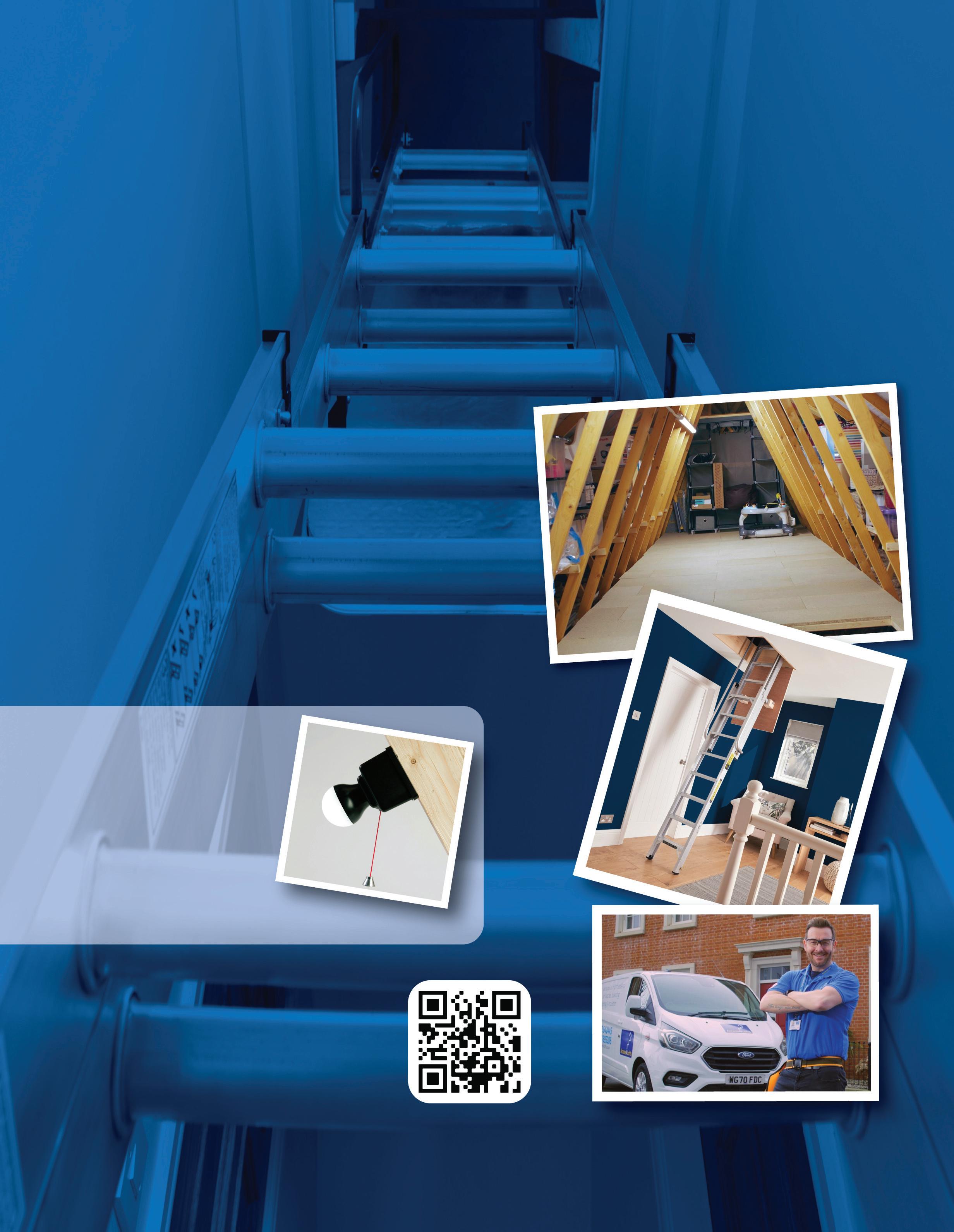

Converting a loft is one of the most effective ways to add extra living space to your home, enhancing both its functionality and value
Whether you need extra storage, a home office, a bedroom, or living area, a well-executed loft conversion can be a game-changer. It can be a more cost-effective solution compared to moving to a larger property or building an extension, and could increase the value of your property by up to 20%. In the competitive property market, homes with additional functional space often stand out and can command a higher price.
Loft conversions are less intrusive than ground-level extensions, typically requiring fewer planning permissions and causing minimal disruption during construction, but they do have some key requirements; for instance, larger loft conversions, especially those that will be used as living spaces, may require fixed stairs rather than a pull-down ladder.
Pull-down ladders are a popular choice for smaller lofts where floor space is limited,
as they are compact and can be stowed away when not in use, providing easy access without sacrificing space. If you do fit a pull-down ladder, always bear in mind the size of hatch you will need to make it easy to get in and out of the loft.
One of the most important aspects of a loft conversion is ensuring that the space is properly ventilated. Lofts are typically small, confined areas that can become stuffy or damp if not adequately ventilated. Without proper airflow, moisture can accumulate, leading to mould and mildew growth, which can damage both the new space and the existing structure of the home.
There are several ways to address ventilation. Installing roof windows is an effective method, as they allow for natural airflow while also letting in light. Additionally, adding vents or mechanical
extraction systems can help regulate air quality and humidity levels. It’s also important to consider insulation when converting a loft - adequate insulation helps to maintain a comfortable temperature while preventing condensation.
For homeowners with an underutilised garage, converting it into a liveable space is another viable option. Garage conversions can offer similar benefits to loft conversions, often requiring less disruption and construction. A garage is typically already separated from the main living areas, which can be ideal for creating private spaces such as a home office, gym, or guest suite. The main challenges in a garage conversion are ensuring proper insulation and heating, as garages are often poorly insulated compared to other parts of the house. But with the right planning, a loft or garage conversion can transform your home into a more spacious, efficient, and valuable asset. ■






Where should you invest your nest egg?





...in your nest, of course.
Energy efficiency home improvements can add value to your home and make it cheaper to run, while protecting your finances from the ups and downs of energy price rises, interest rate surprises and climate change uncertainty.
With potential benefits including energy bill savings, solar export income and a low carbon home premium on the value of your house, a home upgrade is an attractive investment whether you're staying or selling.
So whether your ideal is:
to enjoy a warm, comfortable home and save on your bills to sell your house for a higher price because it’s energy-efficient to put your money somewhere safe that benefits you now and in the future
...investing in an energy-efficient, decarbonised home is a sensible choice to keep your nest egg safe and warm until you need it.
Get an Ecofurb Plan to find out what a home retrofit could be worth to you.


An ‘ecofurb’, where you retrofit an existing property to improve energy efficiency, can be the most valuable type of renovation
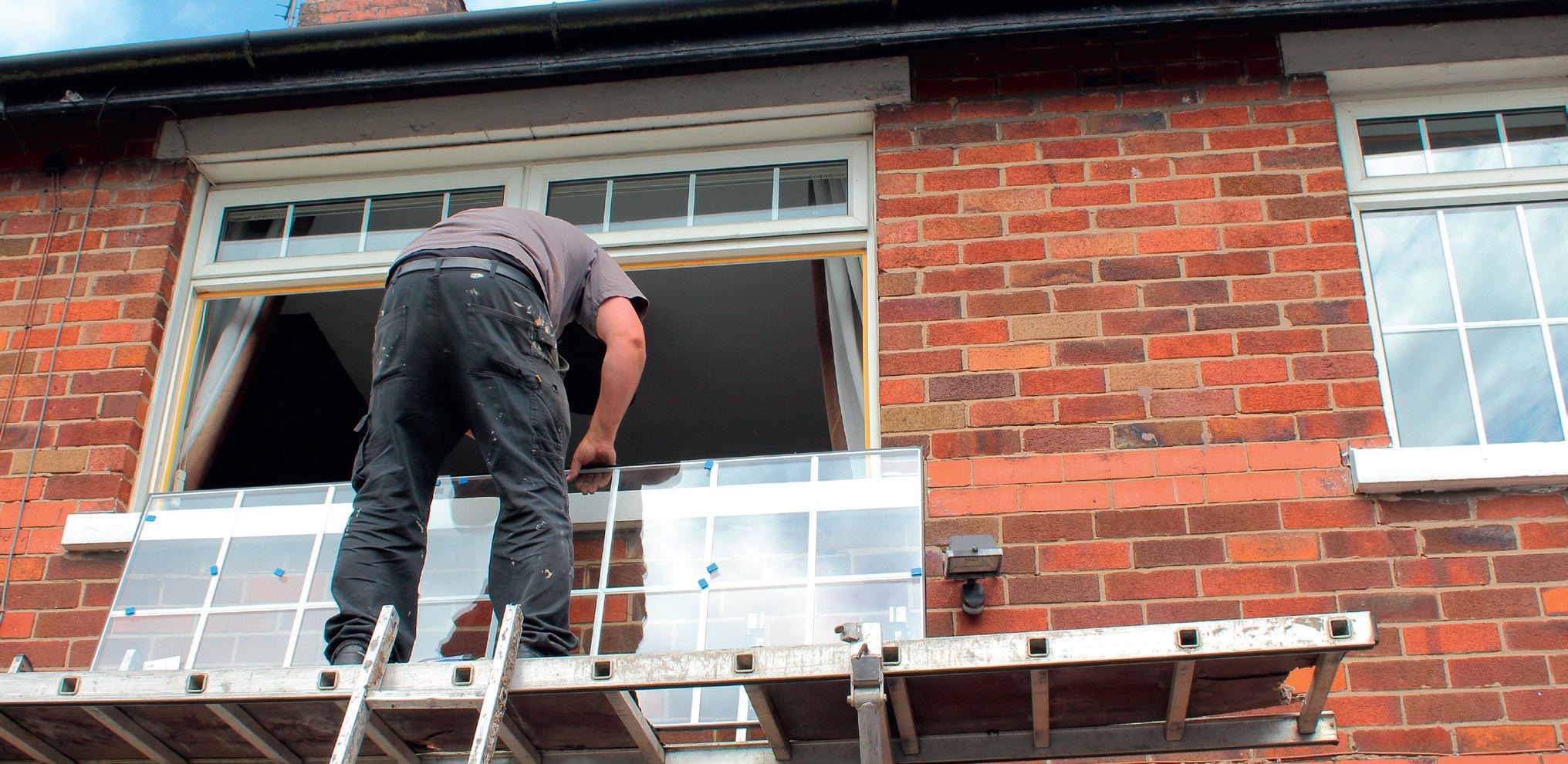
More and more homeowners are looking to retrofitting their properties to improve energy efficiency. This sort of ‘ecofurb’ can not only cut your energy bills, but can also enhance the value of your property.
Homeowners are often tempted to enhance their property by fitting a new kitchen, or building an extension – but in many cases it makes more economic sense to look at a retrofit which will save you money in the long term, such as an energy efficiency upgrade.
Insulation, double glazing, solar panels and electric heating can do a lot to save you money over the years, and improving the energy efficiency of your property will increase its sale value. Solar panels, particularly, which can offer an income from surplus energy, are a great plus when
it comes to valuing a property.
The experts from Ecofurb say: “Ecofurb is a service designed to help homeowners plan the most cost-effective way to get their homes energy efficient, supporting from advice right through to installation and quality-checks. An Ecofurb Plan provides you with a tailored whole-home energy roadmap, produced by a qualified retrofit coordinator. Have a go with their free online Ecofurb Options tool to see which measures could work for your home, budget and priorities.” Find out more at ecofurb.com
The sorts of savings offered by an ”ecofurb” retrofit are measurable; if you can move your property’s EPC (Energy Performance Certificate) from E to C, you could add around nine percent to your property’s
value. By retrofitting your property with energy efficiency upgrades, you free up a buyer’s finances to support a higher mortgage payment.
Of course, an ecofurb does not come free, particularly if you go for a full package of insulation, double glazing, solar panels, a heat pump and so on. You may spend £10,000 or more on retrofitting – but if you plan to be in the property for 10 years or more, you should make that expenditure back in energy savings, and you will certainly enhance the value of your house. At the same time, of course, you will get the feel-good factor of knowing that you are cutting your carbon footprint.
What is certain is that just the pleasure of living in a warm, dry home and not having to worry about the health hazards of cold, damp and mould makes the effort of retrofitting well worthwhile. ■
A collection of expert insights highlight how sustainability is shaping the future of self-build and renovation
As we write this, Earth Day is approaching on 22nd April, so appropriately, we’re excited to share a collection of expert insights from the Homebuilding & Renovating Show panel, highlighting how sustainability is shaping the future of selfbuild and renovation.
Marc Lane, landscape designer for the Homebuilding & Renovating Show, director and owner of Landscapia and Nuvo outdoor
living, says: “As a landscape designer, I believe sustainability doesn’t begin or end at the walls of a home—it wraps the house from boundary to boundary. From experience, when people think ecoconscious building, their minds often jump to insulation, solar panels, or heat pumps. But the land around a home is equally critical in creating a truly sustainable, lowimpact lifestyle.
“One of the biggest myths I regularly
challenge is that sustainability means compromising on beauty or comfort. In reality, a well-designed landscape can add so much to a home. Planting native species, for example, not only supports biodiversity but also requires less water, fertilizer, and maintenance. Pairing that with permeable paving (SUDs-compliant) and green roofs can radically reduce stormwater runoff, cool the home naturally, and help manage microclimates.”


“We’ve seen a big rise in homeowners embracing reclaimed timber, bricks, and flagstones in their outdoor spaces—giving old materials new life and character. A friend of mine, designer Adam Vatere, and our podcast co-host Justin Hipson use this approach in many of their gardens.
“It’s a creative way to lower embodied carbon while adding authenticity and warmth to a garden design.
“That said, it’s important to be realistic about costs. Reclaimed materials often
come with a higher price tag—not because of the materials themselves, but due to the time and labour involved in making them workable. Cleaning, prepping, resizing, or reconfiguring old materials to fit into a modern landscape scheme can be a painstaking process. In many cases, the labour element far outweighs any initial cost savings. It’s a more bespoke approach, but for those passionate about sustainability and timeless charm, the results are well worth the investment.
“Landscaping can also play a passive role
Marc Lane says that planting an array of pollinating plants will encourage bees and butterflies – “Hedges invite nesting birds, natural ponds support frogs, and wood stacks provide homes for insects. A garden should be shared with our native friends.
“The conscious home is extending to the conscious garden. More clients are asking for edible landscapes, pollinator-friendly planting schemes, and spaces that reconnect them with nature. It’s a shift from seeing gardens as purely decorative to recognizing them as vital contributors to sustainability and wellbeing.
“The days of artificial grass and plastic planting are rapidly declining in popularity. Working with a designer to reduce maintenance without destroying natural habitats is the way forward.
“I’d encourage homeowners to look out their windows and ask: Is my landscape working for the planet—or just for aesthetics? With smart, sustainable design, we can have both”.
in energy efficiency. Thoughtful planting of deciduous trees on the south and west sides of a property provides shade in summer and lets light through in winter. Green walls can buffer noise and pollution while insulating outdoor rooms. These aren’t just “nice-tohaves” - they’re practical tools in the futureproofing toolkit.”
Julia Kendell, interior design expert for the Homebuilding & Renovating Show from Kendell & Co, known from her time on BBC’s DIY SOS, says: “Biophilic design is the practice of integrating natural elements into the built environment in such a way that it supports physical and psychological wellbeing. »

“In the context of the conscious home, biophilic design becomes not just aesthetic but deeply purposeful. It answers our need for calm in an overstimulated world and reintroduces the rhythms of nature into our daily lives.
“A conscious home is more than a stylish space—it’s one that reflects awareness: of how we live, what we consume, and how our environments affect our mental, emotional, and physical health. It considers the lifecycle of materials, prioritises sustainability, and is designed to foster mindfulness and serenity. Biophilic design is a natural companion to this ethos, grounding us in the living world and creating a sense of continuity between inside and out.”
Incorporating biophilic design doesn’t mean turning your home into a jungle (though that’s an option!). It’s about creating a layered, sensory relationship with nature through thoughtful, sometimes subtle choices.
1. Natural Light and Views
Maximise the presence of daylight with large windows, skylights, or glass doors. Position key living spaces to benefit from changing light throughout the day. If possible, frame views of gardens, trees, or the sky—visual access to nature has been shown to reduce stress and improve concentration.
2. Organic Materials and Textures
Choose timber, stone, clay, linen, and wool - materials that create an entirely different experience in the home to synthetic compositions. Embrace their imperfections: the grain of oak, the patina of brass, or the coolness of honed limestone. These tactile cues bring us into the moment and echo nature’s variety.
3. Indoor Greenery and Living Systems
Plants are not just decoration but act as living elements cleaning the air and bringing a living energy to a space.
Consider vertical gardens, indoor trees, or even hydroponic herbs in the kitchen. Where possible, use locally appropriate species and group them in clusters for greater visual and ecological impact.
4. Biomorphic Forms and Patterns
Integrate shapes and motifs that mimic the curves and asymmetry found in nature— arched doorways, ripple-like tile patterns, or lighting inspired by leaves or coral. These organic forms feel intuitive and comforting to the brain.
5. Natural Colour Palettes
Draw your colour schemes from the natural world: earthy ochres, soft greens, sea blues, and muted neutrals. These tones foster a sense of peace and continuity with the landscape outside.
6. Spatial Flow and Refuge
Design spaces that mirror nature’s balance between openness and shelter. Create
Simon Rix, senior planning consultant at Planix.uk and planning expert for the Homebuilding & Renovating Shows, says: “We’re seeing a real shift in mindset among self-builders and renovators. It’s no longer just about lowering energy bills –people genuinely want to reduce their carbon footprint and create homes that feel connected to place and planet.
“One encouraging trend is a renewed interest in reclaimed and locally sourced materials. Salvaged timber, clay tiles, and reclaimed brick don’t just lower embodied carbon – they also add character and craftsmanship that newer materials can struggle to match.”
zones that o er both prospect (open views, generous sightlines) and refuge (quiet nooks, alcoves, or window seats). This spatial diversity promotes comfort and psychological wellbeing.
While new eco homes get most of the headlines, the real challenge is improving the performance of our existing housing stock. Retrofitting – done well – is the most impactful path to net-zero housing.
But it’s o en misunderstood. Homeowners sometimes think they need to go “all or nothing” – a full deep retrofit or nothing at all. In reality, incremental retrofitting can be hugely e ective if it’s done strategically.
It’s easy to get dazzled by solar panels, heat pumps and battery systems – and they absolutely have their place. But no technology will perform well in a poorly insulated or badly orientated home.
Future-proofing isn’t just about the kit you bolt on. It’s about designing for passive solar gain, for cross-ventilation, for thermal mass. The most sustainable homes reduce the need for energy first – then meet the remaining demand with renewables. If you’re self-building, orient your

main living spaces to the south or southwest and include shading devices (e.g. overhangs or deciduous planting) to prevent overheating. Get your planning consultant to mention this in your planning application. It will impress the decision maker and could help push your application over the line.
There’s a lot of buzz around hempcrete, mycelium insulation, and even carboncapturing concrete. And while innovation is vital, we shouldn’t overlook time-tested low-impact materials like lime render, timber framing, and straw bale.
Sustainability isn’t always high-tech. Sometimes the most e ective solutions are rooted in traditional building methods adapted with modern know-how.
People o en think breathable, natural materials are only for quirky, rural homes. In fact, they’re ideal for many retrofit projects in older housing stock where breathability is essential to prevent damp and decay. Your local council’s planning policies and design guidelines may favour such materials too. If so, don’t be shy about what you are using in your planning application.
There’s a persistent myth that building sustainably always costs significantly more. In truth, many energy-e icient measures pay back rapidly – especially with rising
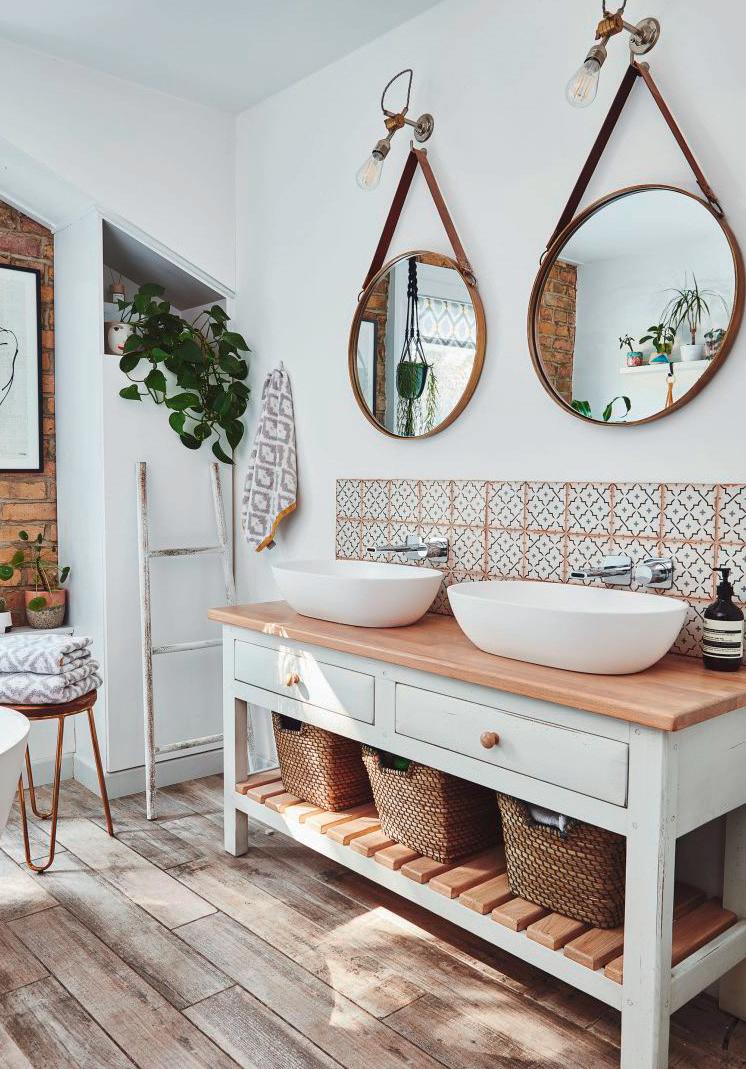
energy costs and improved incentives. Focus on lifecycle cost, not just upfront cost. An energy-e icient home may be marginally more expensive to build, but significantly cheaper to run, with better long-term resilience. Sometimes it good to talk to your local councillor before you submit an application. If you do, don’t forget to mention how your plans will help deal with the climate crisis as well as the housing shortage.
Tim Phillips, senior quantity surveyor for the Homebuilding & Renovating Show, founder of Quantiv, says: “Using reclaimed timber or bricks doesn’t just tick the sustainability box – it can be cost-neutral or even cheaper than new if sourced well. The key is allowing enough time in the programme to source and prep reclaimed materials. Homeowners o en think a ‘green’ renovation means big spend, but retrofitting with basics like lo insulation (£15–£20/m2 supplied and fitted), internal wall insulation (£60–£100/m2), or draproofing (£200–£400 for a whole house) o ers huge gains for modest cost. I always advise clients to prioritise fabric-first upgrades – it’s the most cost-e ective way to improve EPC ratings and cut energy bills fast.”
To attend a Homebuilding & Renovating Show near you, claim complimentary tickets from www.homebuildingshow.co.uk ■
Tired of messy grout and timeconsuming tile installations?
Fibo wall panel solution is the game-changing alternative that delivers the stunning look and feel of tiles without the hassle.
No Special Tools, No Skilled Trades Needed – Whether you’re a seasoned DIYer or have a handyman on call for key jobs, Fibo system makes installation effortless.
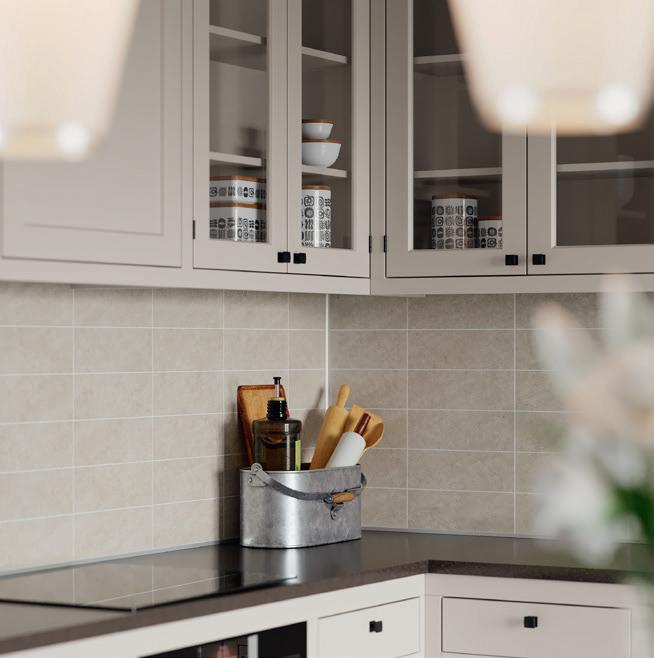

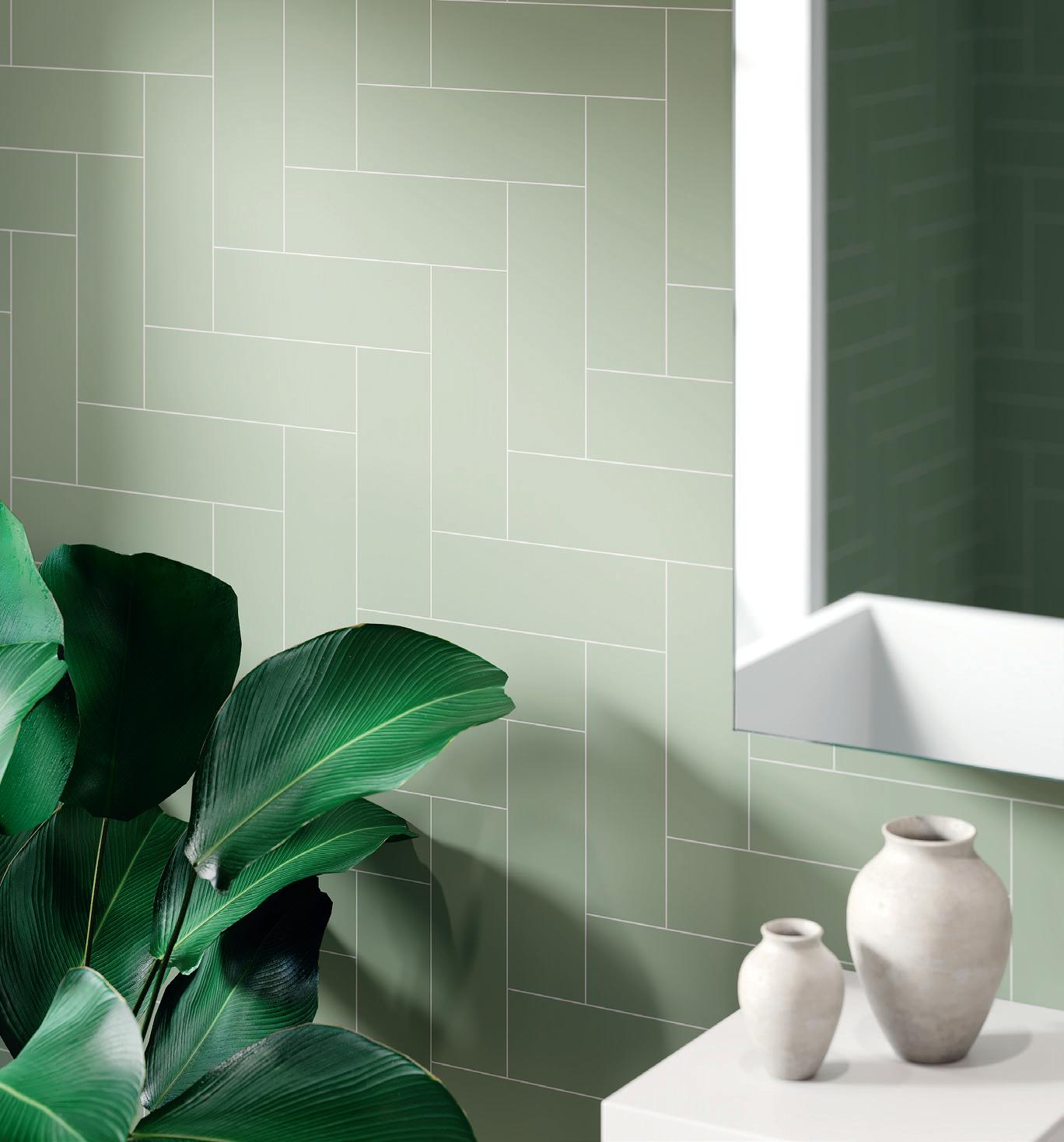
Scan here to find your nearest showroom
Cut drying time and complex tile pattern laying with panels that simply click together
Unlike tiles and grouting that can crack and leak over time, Fibo’s system keeps moisture out.

A grout-free surface resists mould and bacteria buildup making it effortless to clean.
Just like real tiles without the complex installation, grout maintenance, and expensive professional labour.
Impact-resistant and built to withstand daily wear and tear, unlike tiles that can chip and crack.

There’s an alternative to the tricky and time-consuming job of tiling bathroom walls - wall panels look great and are easy to install
It’s the usual choice to tile a bathroom wall – tiles come in all shapes and sizes, are durable and are water resistant. But they can also be difficult to cut and install neatly – only the most confident can do a good DIY job of them – and will usually present a time-consuming job.
One modern alternative is bathroom wall panels – they are quick and easy to cut and fit, waterproof, durable and eco-friendly.
Upgrade your bathroom or kitchen with Fibo’s high-quality, 100% waterproof panel system, that offers the luxurious look of tiles without the hassle of grout. Unlike tiles and grouting that can crack and discolour over time, Fibo’s durable and antibacterial surface provides a low-maintenance solution for a cleaner, healthier home. With a variety of stylish designs, installation is five times faster
than traditional tiling, with panels seamlessly clicking together. Stylish and durable, Fibo creates a beautiful, effortless space.
Made from multiple layers of material such as birch plywood, bathroom wall panels will have a waterproof lining on the back, and a high-pressure laminate on the front. This means that they can be offered with practically any sort of design or colourway, much like conventional tiles. Though they are available with a plain surface, which makes them very easy to clean, if you want a tile effect, bathroom wall panels are often offered cut with ‘grouting’ lines to make them resemble tiling.
Fitting of bathroom wall panels requires special adhesives, and joints and exposed
edges require a sealant or an aluminium profile strip.
They can often be fitted over existing tiles, and can hide damaged walls. They are colourfast, and warm to the touch, another advantage over conventional tiles – and they are also easier and cheaper to transport as they are a lot lighter than tiles, as well as having a smaller carbon footprint. This is one reason why they are becoming particularly popular in modular construction projects incorporating bathroom ‘pods’ or other prefabricated designs.
It’s also claimed that bathroom wall panels can be up to 60 percent cheaper than an equivalent tiling job, so if you were looking for a final reason to look into them, what could be a better one! ■

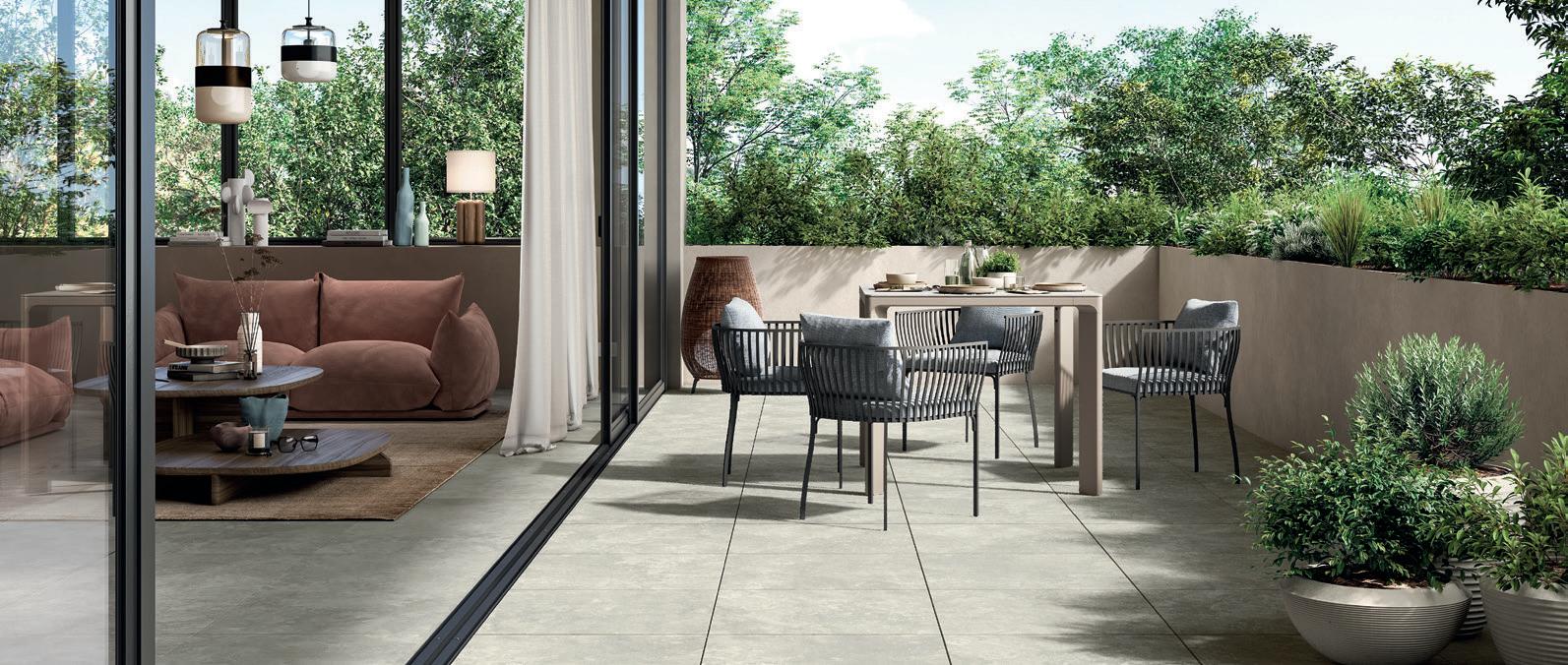
Tiles are a popular and versatile flooring and wall covering option, offering a range of aesthetic choices and functional benefits

Tiles come in various materials, styles, and finishes, each suited to different types of spaces and purposes, so whether you’re renovating your bathroom, updating your kitchen, or installing a floor in a high-traffic area, tiles provide a durable, easy-to-maintain, and aesthetically pleasing solution.
The most common types of material used in tiles are ceramic, porcelain, natural stone, glass, and cement tiles. Each has its own advantages.
1. Ceramic Tiles: These are the most widely used tiles, crafted from clay and baked at high temperatures. Ceramic tiles are perfect for a variety of applications, including floors, walls, and backsplashes.
2. Porcelain Tiles: A subtype of ceramic tiles, porcelain tiles are made from a finer clay and fired at a higher temperature, giving them greater density and water resistance. These tiles are highly durable and ideal for both interior and exterior
applications. Their ability to withstand heavy foot traffic makes them an excellent choice for commercial spaces, as well as kitchens and bathrooms.
3. Natural Stone Tiles: Natural stones like granite, marble, slate, and travertine offer a luxurious and unique aesthetic. Because each stone is distinct, these tiles bring a one-of-a-kind beauty to any space. Natural stone is perfect for creating sophisticated floors, countertops, and feature walls. However, these tiles require sealing and regular maintenance, especially in highmoisture areas like bathrooms.
4. Glass Tiles: Known for their reflective qualities and vibrant colours, glass tiles are often used in decorative applications, such as backsplashes, accent walls, and mosaics. Glass tiles are easy to clean, moisture-resistant, and provide a sleek, modern look. They can be used in both wet and dry areas, making them a popular choice in kitchens and bathrooms.
Cement Tiles: Cement tiles, also known as encaustic tiles, are handmade and often feature intricate patterns and colours. These tiles are highly durable and can be used on floors, walls, and even outdoor spaces. Cement tiles are highly customizable, allowing homeowners to create unique designs, but they do require sealing to prevent staining and to maintain their appearance over time.
In addition to the types of material used in tiles, there are huge choices in terms of sizes, colours, patterns and finishes – for instance the shiny surface of glossy tiles makes spaces appear brighter and larger, while matte tiles have a more understated look and are more slip-resistant, making them ideal for floors in wet areas. Whatever type you choose, tiles are the practical choice for durability, ease of maintenance and sustainability, offering a lifespan which makes them an excellent long-term investment. ■
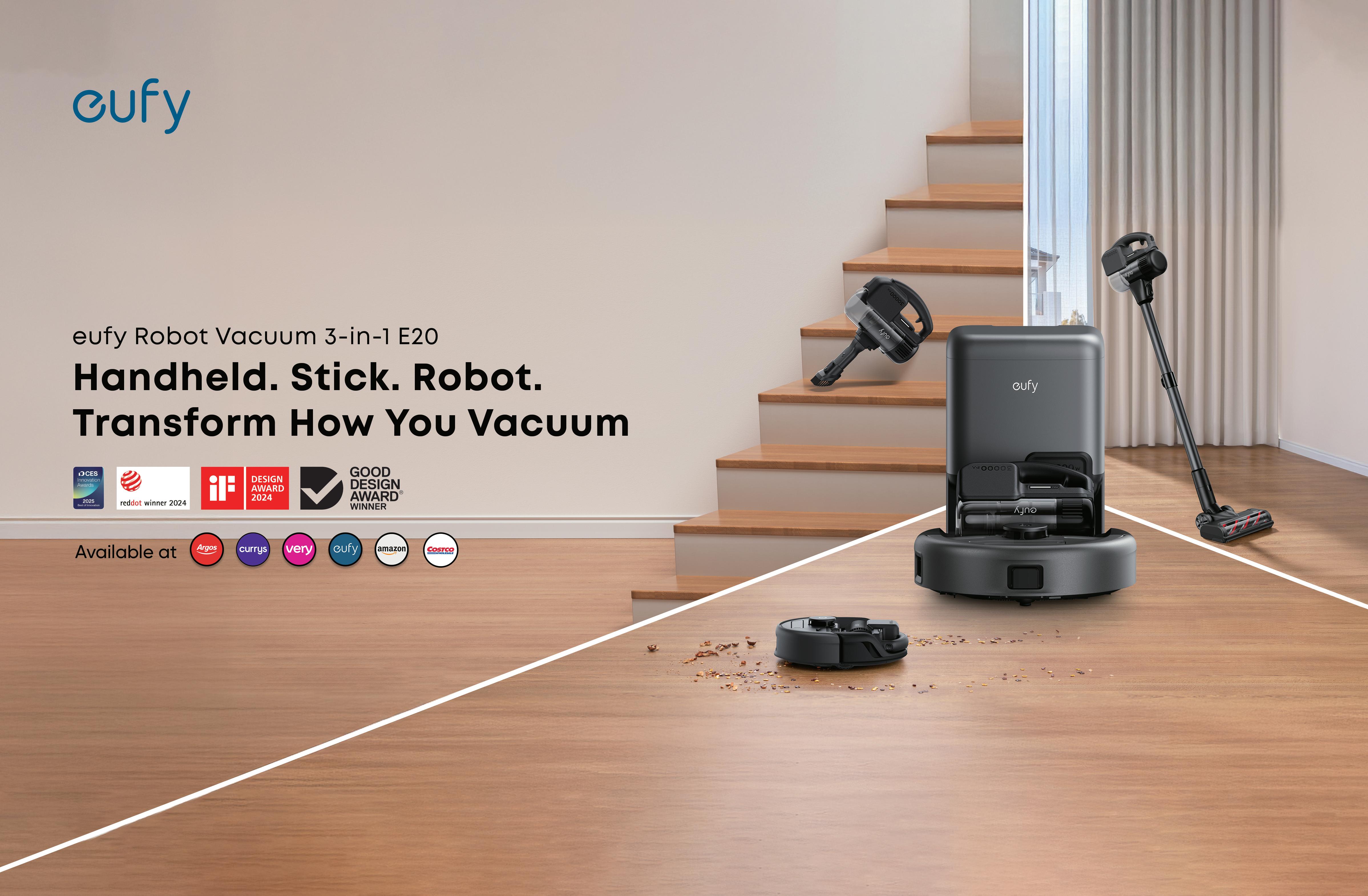

Robot vacuum cleaners, once a futuristic concept, have now become a household commodity
While the concept of a humanoid robot which can carry out all your household cleaning chores still seems a long way off, certain types of robots –such as vacuum cleaners and lawnmowers – are now well established.
Robot vacuum cleaners operate using a combination of sensors, motors, and intelligent mapping systems. The basic structure usually consists of a round, flat body with a rotating brush or roller, a suction system, and a collecting bin. Most models are equipped with an array of sensors that help the cleaner navigate its environment, such as ultrasonic, infrared, and laser sensors, which help the robot detect obstacles, map out the layout of a room, and even detect the edges of walls to avoid falling down stairs.
Some advanced models also use LIDAR (Light Detection and Ranging) technology, which creates detailed maps of the room so the robot can navigate more efficiently.
Robot vacuum cleaners are usually powered by rechargeable batteries, and many have the capability to return to their charging dock automatically when their battery runs low.
Most robot vacuum cleaners offer convenient scheduling and app-based controls, so users can set the device to clean while they’re away or asleep. Many models also come with self-emptying capabilities, which means they can empty their dustbin into a larger container when docked, reducing the need for frequent emptying.
But they do have their limitations; for instance they may struggle with cluttered areas, cables, larger debris, pet hair on high-pile carpets, or more thorough cleaning tasks that require a traditional vacuum.
Robot vacuum cleaners are typically less powerful than upright or canister
vacuums, which means they might not pick up as much dirt or handle thicker carpets effectively, so they generally work best for maintaining surface cleanliness rather than deep cleaning.
As AI continues to improve, robot vacuums will become even smarter, able to recognize more objects and adjust their cleaning patterns in real-time. We can expect more advanced mapping technology, allowing robots to clean with greater precision, and learning the layout of your home. Moreover, we may see the development of more sustainable models, with features like energy-efficient motors, recyclable materials, and eco-friendly dust disposal systems.
Soon, integration with smart home ecosystems could enable robot vacuums to collaborate with other household devices, such as air purifiers and robotic mops, creating fully automated cleaning routines and transforming the way we keep our homes clean. ■






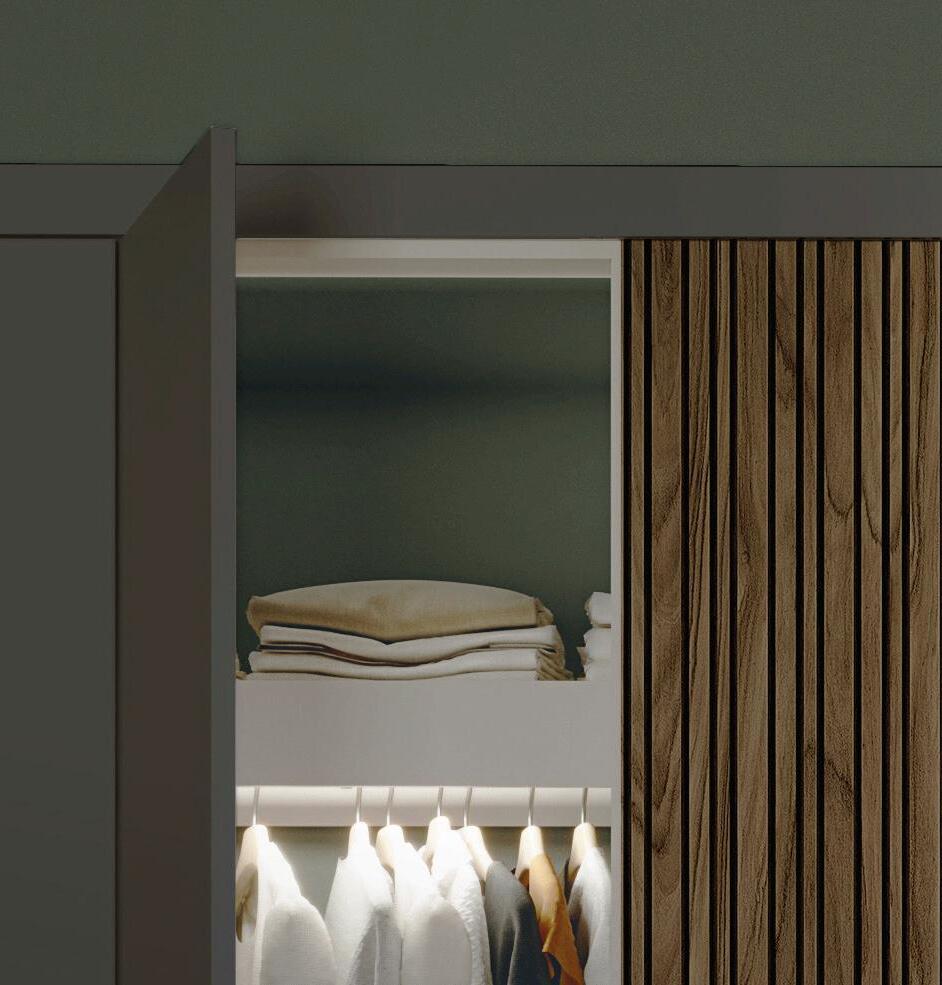
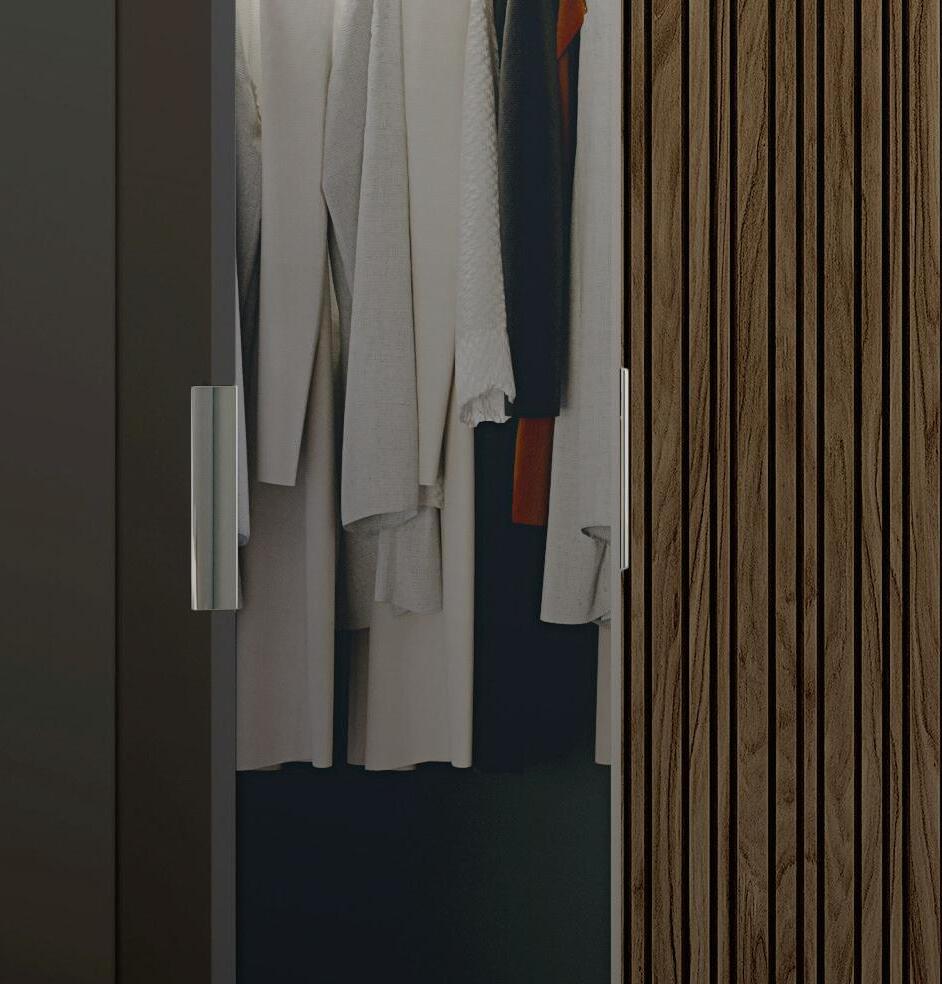
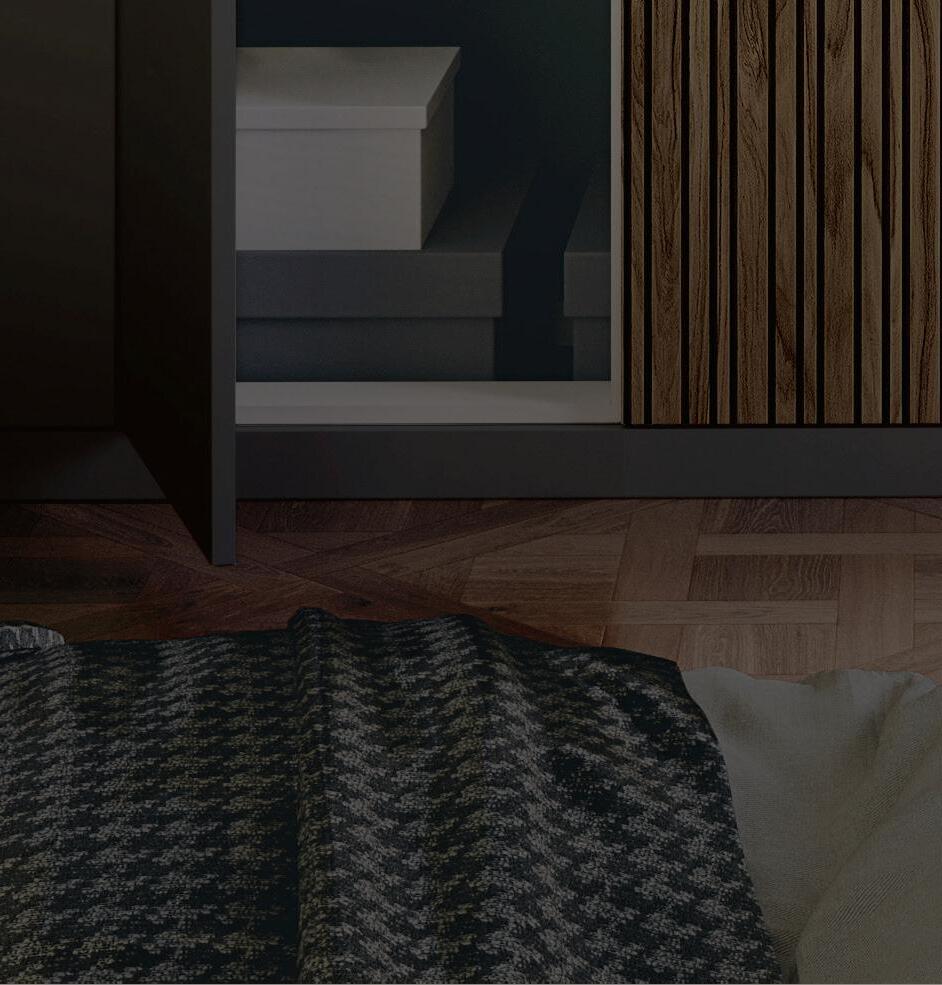



Fitted wardrobes can add utility and value to your home – so how do you approach a project?
In modern homes, maximising space while maintaining style and functionality is a top priority. One of the best ways to achieve this is by installing fitted wardrobes. These bespoke storage solutions not only enhance the organisation of your living space but also significantly contribute to the overall aesthetic and value of your home. Whether you’re renovating or building from scratch, fitted wardrobes can provide numerous benefits that go beyond simply offering more storage.
A key advantage of fitted wardrobes
is their ability to make the most out of available space. Unlike freestanding furniture, which can leave awkward gaps or waste valuable space, fitted wardrobes are designed to seamlessly integrate into your room’s dimensions. They can be tailored to fit into corners, under eaves, or even around chimneys, ensuring every inch of space is utilized.
For smaller homes or rooms with irregular shapes, fitted wardrobes are particularly beneficial. They can create a sense of openness by reducing clutter
and improving the flow of the room. For larger homes, fitted wardrobes offer the opportunity to install more storage without sacrificing aesthetics or room functionality.
One essential feature of the fitted wardrobe is the sliding door, which opens without taking up space in the room. Hinged designs can be planned for tighter, awkward spaces where sliding or a full carcass solutions aren’t always feasible. Clever storage solutions can even be achieved in alcoves or rooms with steps in the walls. »

Fitted wardrobes can be fully customised to suit your storage needs, whether you need extra hanging space for clothes, shelves for shoes, or drawers for accessories. The design flexibility allows homeowners to choose from a wide range of finishes, materials, and hardware options, ensuring the wardrobes complement the existing decor of the room. From modern, minimalist designs to more traditional, ornate styles, fitted
wardrobes can be crafted to reflect your personal taste and elevate the overall design of your home.
Additionally, bespoke wardrobes allow you to incorporate specialised features like mirrored panels, or built-in lighting. This customisation not only improves the functionality of the storage space but can also enhance the room’s visual appeal.
A well-organized wardrobe can significantly reduce clutter in a home, creating a more pleasant and serene living

environment. Fitted wardrobes allow for smart organisation systems such as pullout drawers, tie racks, shoe racks, and adjustable shelves. This makes it easier to store clothing, shoes, and accessories in an organised manner, reducing the time spent searching for items and making the space more efficient.
By incorporating these personalised storage solutions, a fitted wardrobe can also help with the overall tidiness of the home. It can create a designated space for everything, from everyday clothing to seasonal items, helping to keep your home neat and orderly.
One of the most significant long-term benefits of fitted wardrobes is their potential to increase the value of your home. Estate agents often cite the importance of ample storage space when evaluating a property. Homes with welldesigned, custom storage solutions are generally more appealing to potential buyers, especially in markets where space is limited.
Fitted wardrobes provide a premium, built-in feature that adds both style and function to a home. They present an opportunity for homeowners to showcase smart design, attention to detail, and practicality. As a result, a well-constructed, high-quality fitted wardrobe can help elevate the perceived value of a property, potentially leading to a higher sale price or quicker sale in competitive markets.
Fitted wardrobes offer numerous benefits, making them a wise investment for homeowners looking to improve both the utility and value of their property. By maximising space, offering customisation options, and contributing to better organisation, they are more than just a storage solution. They can transform any room into a more functional and visually appealing space, all while increasing your home’s resale potential.
Whether you’re seeking to create a serene bedroom or add valuable storage to your living areas, fitted wardrobes provide an elegant and practical solution. ■

Martin Roberts cuts a dash on TV in Homes Under the Hammer , but what does he keep in his wardrobe? He spilled his sartorial secrets in an interview on The Express Online…
DO YOU HAVE A SEPARATE WARDROBE FOR YOUR TV WORK?
I tend to wear a jacket or coat with a Boden shirt and jeans for filming in and out of properties. The only separate wardrobe I have is for the links, which I film in a posh hotel. I’ll wear something smarter for that and it’s the only time I’ll wear a suit.
WHERE DO YOU TEND TO SHOP?
The Clarks shopping village is close by, so I’ll go there. I’ve also been known to go to the Boden rummage sale in Shepton Mallet.
DOES YOUR CLOTHING EVER GET TRASHED WHILE WORKING?
Every day. Filming Homes Under The Hammer, I’m walking around building sites, covered in dust or stepping in dog poo.
WHAT IS THE WORST CLOTHING MALFUNCTION YOU’VE HAD?
We were filming in Chard and a runner tripped with a cup of coffee and it went all over me. I was soaked and had to find a hand dryer in a local pub. We carried on filming and you could see all the stains on my clothes.
WHAT IS THE OLDEST ITEM IN YOUR WARDROBE?
A white linen suit I bought for £100,
down from £1,000 from a boutique in Manchester. I wore it on Wish You Were Here when I was presenting from the Tomatino Tomato Throwing Festival in Valencia, Spain. I got spattered, but the suit dry-cleaned and I’ve still got it.
ARE YOU A HOARDER OR DO YOU CLEAR OUT YOUR WARDROBE EACH SEASON?
A hoarder. I can’t throw anything away. It drives my wife nuts.
DO YOU HAVE A FASHION PET HATE? ON MEN?
Anything frilly or flouncy. Great on Adam Ant back in the day, but too pantomime now.
HOW MANY PAIRS OF SHOES DO YOU OWN?
Thirty, but I only wear about three. My favourites are my Timberland boots. They keep my feet warm when it’s freezing – so important when filming.
WHAT IS YOUR CURRENT FAVOURITE OUTFIT?
A blue patterned Boden shirt and jeans.
HOW MUCH DO YOU SPEND ON CLOTHES EACH MONTH?
A couple of hundred quid, maybe?
WHAT IS THE MOST EXPENSIVE ITEM IN YOUR WARDROBE?
An Yves Saint Laurent dinner jacket. I bought it in a sale but it was still several hundred pounds.
… AND YOUR BEST BARGAIN?
A pair of River Island three-quarter length shorts, which my wife bought for me from a charity shop for 50p.
WHAT DID YOU WEAR FOR YOUR WEDDING?
We both wanted a lovely, comfortable wedding in our local church, so I told all the men to wear jeans and a nice shirt. Kirsty, my wife, made waistcoats for everyone and I wore mine with jeans, a Paul Smith jacket and Ted Baker shoes. Our son Scott, who was three at the time, was my best man, along with my best mates, who were assistant best men. Kirsty arrived with her dad in a JCB and afterwards we had a barn dance.
HAVE YOU EVER MADE A FASHION FAUX PAS?
The fringed leather cowboy jacket I wore on one programme. I really liked it, but my editors didn’t and before it was aired they did a spoof programme with joke arrows pointing at the jacket.


Would you buy a pre-owned kitchen? There are lots of good reasons, not the least being the money you might save
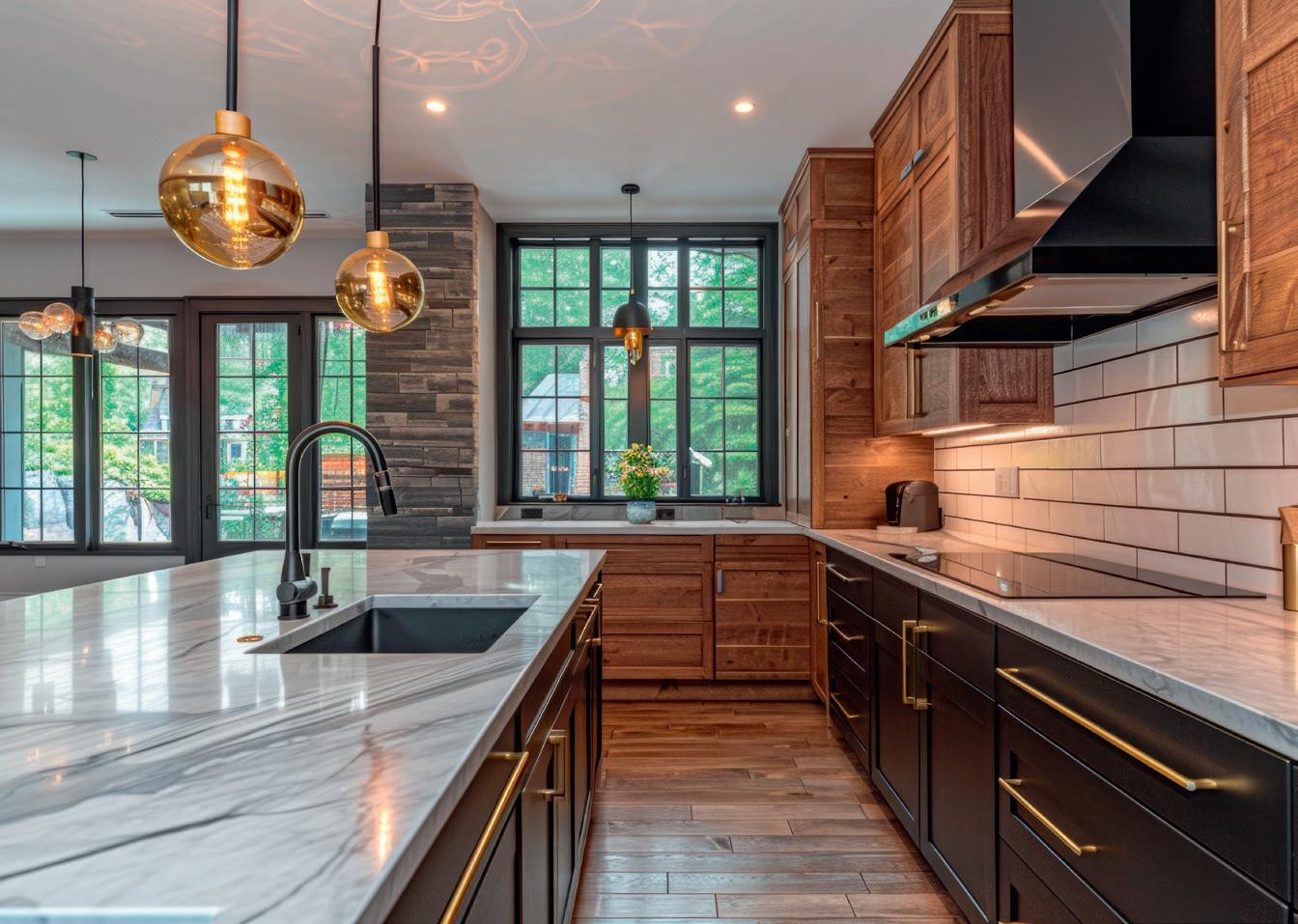
It might not have occurred to you in your refurbishment planning, but there are lots of good reasons to consider a used or ex-display kitchen. This allows you to have a better quality kitchen at a lower price. If you are renovating, you may have already stretched your finances, and a good quality used kitchen can look just as good as new, without the huge price tag.
Many perfectly viable kitchens are sent to landfill unnecessarily, but consumers now realise the environmental and financial benefits of selling an unwanted kitchen. Specialists in used kitchens can help interior professionals to offer their clients the sustainable solution of selling their kitchen.
Ex-display and used kitchens are offered at significantly discounted prices, and by choosing one you contribute to
environmental sustainability, reducing waste and promoting a circular economy.
Display kitchens are carefully selected to showcase the best features and materials of a range, and built with top-notch materials designed to look exceptional, so you have the chance to own a kitchen crafted with premium materials, ensuring long-lasting durability and style.
There may still be opportunities to customise ex-display models to your requirements, whether it’s adding or removing cabinets or adjusting the colour scheme.
Daniel Abrahams of Used Kitchen Hub says: “Interior professionals including designers and architects love using our service for their clients’ refurbishments, helping them sustainably sell and remove their existing kitchen before

“When it comes to renovating a kitchen, there are many things to think about. This includes the positioning of the room, the fittings and fixtures as well as the lighting in the kitchen. The bigger the better…the more space you can create for your kitchen, the absolute better.
“If you can create a kitchen which is part of the living part of the house, which people can mill around and have fun in while you’re doing the cooking and it just feels like it’s part of that whole family environment, then that is what people want.
“There are some truly amazing bargains available in ex-display units, or secondhand units that just have virtually no use, for the fraction of the cost that it would be to buy those things new. I know people who have literally got bespoke designer kitchens which would have cost £20,000 or £30,000 for a fraction of the price, so look around and see what kind of a bargain you can get.”
any building work begins and their new kitchen is installed.”
Unlike new kitchens that require assembly and customizations, ex-display kitchens are ready to be delivered and installed promptly. This means you can enjoy a faster turnaround time and start enjoying your new kitchen sooner. ■
Home security technology has come a long way, providing homeowners with a range of advanced tools to protect their property and loved ones. From simple sensors to sophisticated cameras, modern systems integrate multiple features that work together to create a comprehensive security solution.

Door and window sensors are the foundation of many home security systems. These devices are typically magnetic and consist of two parts: one attached to the door or window and the other to the frame. When the door or window is opened, the connection between the two parts is broken, triggering an alarm. These sensors are effective for detecting unauthorized entry and are often integrated with other security measures like cameras or a home alarm system.
Night vision cameras have become a crucial component of home security systems, allowing homeowners to monitor their property even in low-light conditions. These cameras use infrared (IR) technology to capture clear images at night or in dark environments. The infrared LEDs on the camera emit light that is invisible to the human eye but detectable by the
camera’s sensor. This enables the camera to capture detailed video footage even in complete darkness.
Wireless cameras have revolutionised home security by eliminating the need for complicated wiring. These cameras connect to the home’s Wi-Fi network, allowing for easy installation and flexibility in placement. Wireless cameras can be placed anywhere within range of the network, providing homeowners with the ability to monitor their property from various vantage points. Many wireless cameras come with cloud storage options, enabling users to store video footage remotely and access it from a smartphone or computer. This ensures that footage is secure even if the camera is damaged or stolen.
Video doorbells are another innovative security feature that allows homeowners to see and communicate with visitors at their door, regardless of their physical location. These doorbells are equipped
with cameras, microphones, and speakers, enabling two-way communication between the homeowner and the visitor.
Video doorbells can be accessed via smartphones or tablets, making it easy to monitor who is at the door and even interact with delivery personnel or guests remotely.
Facial recognition technology has made its way into home security systems, offering a highly personalised level of security. This technology uses biometric data to identify individuals based on their facial features. When integrated with security cameras or video doorbells, facial recognition can be used to distinguish between authorised individuals (such as family members and even pets) and strangers.
Integration of these advanced home security technologies can provide homeowners with a powerful, multi-layered approach to protecting their property. ■

Never mind keeping warm in winter, with increasingly hot summers, many now also face the problem of keeping their homes cool

As UK summers grow hotter and more unpredictable due to climate change, keeping our homes cool is no longer just a comfort issue, it’s becoming essential for health and wellbeing. With 2022 marking the first time temperatures surpassed 40°C in parts of the country, and a sharp rise in households reporting overheating, staying cool is a challenge British homes weren’t built to meet.
Traditionally designed to retain heat through long, damp winters, UK homes are often poorly equipped to deal with extended heatwaves.
Recent research by the UK Health Security Agency has shown that around 80 percent of UK homes now experience some form of overheating during the summer
months, up from just 18 percent in 2011.
So, what can homeowners and renters do to keep their homes cool, efficiently and sustainably?
Passive Cooling Techniques: Think Like a Southern European
In countries used to sweltering heat, architecture often relies on passive cooling - the art of designing and using a home to naturally regulate temperature. While many UK homes weren’t originally designed this way, some of the techniques can be easily adopted.
Start by managing sunlight. Southfacing windows can turn a room into a greenhouse by mid-afternoon, so investing in reflective blinds, shutters, or external awnings can make a dramatic difference.
White or pale-coloured curtains can reflect sunlight, while blackout blinds are ideal for trapping cool night air and blocking earlymorning heat.
At night, ventilation is key. Crossventilation - opening windows on opposite sides of the home - can pull cool air through the house. For maximum effect, pair this with a fan to help push hot air out and draw cool air in. Opening windows during the day, especially when it’s hotter outside than in, can actually make things worse.
Cool Roofs and Insulation: The LongTerm Fix
Insulation is often associated with keeping homes warm, but it’s just as vital for keeping the heat out. A well-insulated roof and walls will reduce heat gain in
summer as effectively as heat loss in winter. Consider insulating your loft with breathable, reflective materials, which prevent solar heat from being absorbed.
Green roofs (rooftop gardens or plant-covered surfaces) are becoming increasingly popular in urban settings.
Windows are one of the biggest culprits in overheating. Double or triple-glazed windows with low-emissivity (low-e) coatings can reflect infrared radiation and reduce solar gain without compromising on natural light.
For those not ready to commit to full replacements, adding reflective window films or solar shades is a relatively lowcost alternative. These products can be DIY-installed and significantly cut heat transmission, particularly in older properties with large single-glazed panes.
As smart homes become the norm, temperature regulation is getting a techsavvy upgrade. Smart thermostats can be programmed to open blinds or activate fans during the coolest parts of the day. Some systems even integrate with weather forecasts to anticipate temperature changes and adjust airflow accordingly.
Wi-Fi-enabled ceiling fans and window
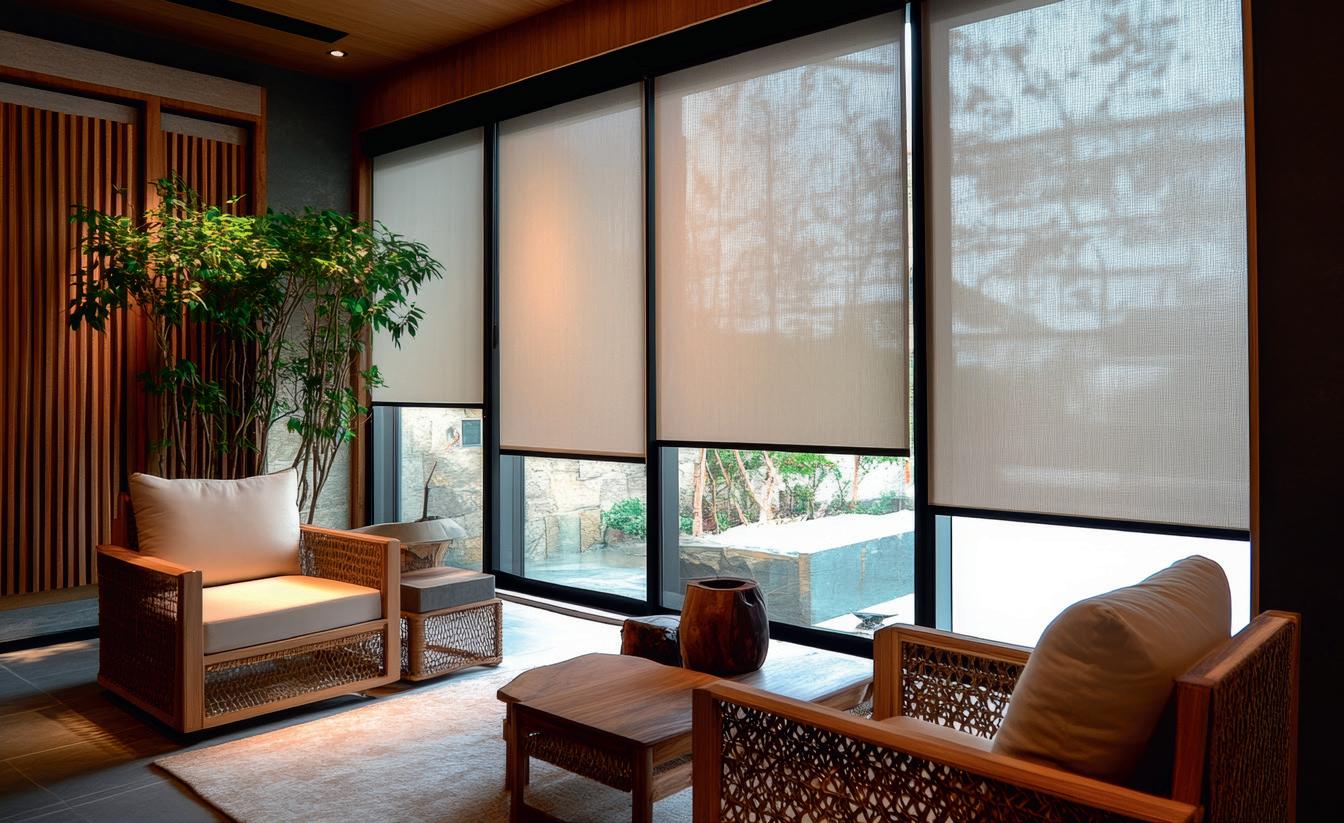
sensors can also work in sync with smart home hubs, automatically switching off when you leave a room or when outside temperatures drop.
Once a rarity in UK homes, air conditioning is on the rise - used now in roughly 21 percent of properties, a sevenfold increase over the last decade. While effective, AC units come with a high environmental and financial cost, increasing electricity demand and carbon emissions unless powered by renewable sources.
If you do install air conditioning, look for energy-efficient models (rated A+++) and combine with solar panels if possible. Portable AC units can be a compromise for

renters or those in listed buildings, but they should be used sparingly and in well-sealed spaces for maximum effect.
Surprisingly, small changes to your décor can also help. Replace heavy rugs with natural fibre mats like jute or sisal, which don’t trap heat. Swap out thick upholstery for breathable fabrics like linen and cotton, and stick to light-coloured furniture and finishes that reflect heat.
Even the positioning of furniture matters - blocking vents or windows with large pieces can restrict airflow, so creating open, breathable layouts can aid circulation.
Houseplants such as peace lilies and snake plants can also cool the air slightly through a process called transpiration.
As the climate crisis progresses, heatwaves are no longer a once-in-a-decade anomaly - they’re an annual occurrence. For new builds or renovations, consider design principles like deeper window reveals, external shading structures, high ceilings, and ventilated facades. These architectural choices, borrowed from warmer climates, are finally making their way into UK design.
The reality is clear: UK homes must evolve to meet the challenges of a warming climate. While the answer may lie in a blend of old-world wisdom and modern innovation, every small change helps. ■










With shower rooms becoming the trend, are we seeing the end of the traditional bathroom?
Anew trend emerging across British homes is transforming conventional bathroom design, replacing the traditional bath in favour of a sleek, modern shower.
Data from bathroom design specialists Ripples (www.ripplesbathrooms.com) suggests a resounding shift, with 90 percent of recent projects featuring a shower, and over three-quarters of new bathrooms designed as dedicated shower spaces, driven by the need to maximise precious square metreage and lower both water and energy use compared to filling a large bath.
Ripples London recorded the completion of 69 fully renovated bathrooms over the past year, a testament to homeowners’ growing appetite for modern, efficient design. Among these projects, 37 rooms were transformed into shower-only sanctuaries, while 15 offered a dual approach, pairing a separate bath with an adjacent shower, and a further 10 showcased a shower-over-bath setup. In total, when combining the dedicated shower rooms with the separate shower setups, 76% of all bathrooms sold were designed exclusively for showering – an indicator that the shower is now the cornerstone of modern British bathroom design.
Jo Sangster, Senior Designer at Ripples London, explains; “British homeowners are rewriting the rules of bathroom design. With urban homes getting smaller and daily life moving faster, practical solutions are more important than ever – and bathrooms are no exception. More of our clients are choosing showers over baths for their space-saving design, lower running costs and improved accessibility. In today’s homes, every square

metre counts. A well-designed shower not only opens up the room but also uses less energy and water than filling a large bathtub, while suiting the needs of busy, multigenerational households.”
The trend for showers extends to aesthetic versatility as well. Today’s designs offer more than just functionality; no longer limited to classic chrome, modern showers are available in more finishes than ever –from elegant brushed brass and nickel to sophisticated matt black, bronze and even satin gold.
This evolution in design reflects broader
lifestyle trends. In today’s fast-paced environment, maximising space and efficiency has become paramount. Removing the traditional bath creates a more expansive and open layout and allows homeowners to integrate premium, tailor-made features that genuinely speak to modern living.
“Bathrooms are no longer relegated to mere functionality,” adds Jo. “They have become personal retreats where design meets daily practicality. Our customers want a space where every element is thoughtfully selected to enhance their dayto-day lives.” ■















on the day or simply just take in the view. With our fully customisable homelifts you can continue to enjoy everything your home has to offer. Because it takes all of your home to be all of you.
Top four homelift benefits:
✓ No major structural changes required
✓ Quick and easy installation – fitted in just one day
✓ 2 free services to ensure your homelift is kept in good condition
✓ 2-year warranty including parts and labour for repairs
Is there such as thing as the perfect home lift? Certainly, there are solutions to many installation challenges, as these case studies show
If you have di iculty with stairs but don’t want to move to a bungalow, a stairli can be a solution, but a home li o ers many more features – such as, for instance, the ability to accommodate a wheelchair.
But what if your home presents structural challenges to the installation of a home li ? Fortunately, the ingenious engineers of home li companies have seen it all before, and can solve many seemingly obstructive propositions.
A couple in their early 80s living in a 1930s Art Deco style home in Frinton-on-Sea were finding it di icult to get upstairs to where a balcony gave them a stunning sea view. The Grade II listed building presented some installation challenges, but the couple found that they could install a home li big enough for two in the alcove next to the fireplace in the living room, giving direct access to the








bedroom above. Even the couple’s two cats now enjoy riding up and down in the li .
Talking of pets, in Surrey, Mrs S has a progressive neurological condition which makes it hard for her to walk, using crutches at home and a wheelchair when she goes out. An occupational therapist recommended fitting a home li , but Mrs S was worried that her dog would get trapped under it. She was reassured that the li would be fitted with sensors so it wouldn’t move if Dougal was in the way. Mrs S is now very happy with her through-floor home li , and can use all the rooms in her house.
In a stylish home in Belgravia, the client wanted a home li to serve four floors, from the basement to the second floor, but for light to be allowed to flow through the property on each level. The architect

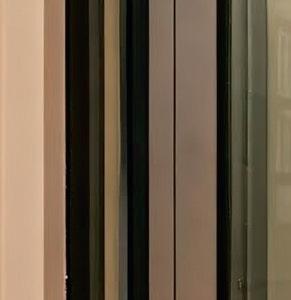

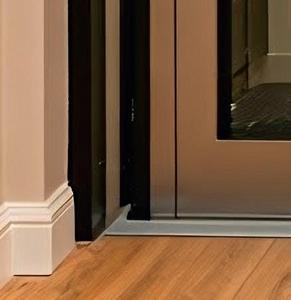
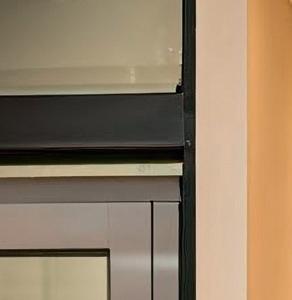
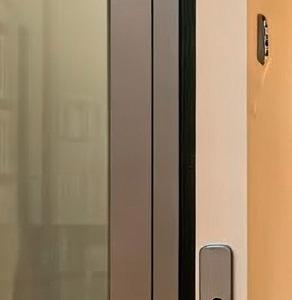


arranged for a skylight to be installed above the li , so light would flood through down the stairwell to the basement via the li , which had bespoke glazed panels installed to three sides.
Less challenging but not an immediately obvious fix was a case where the hydraulic system of a home li required a flat surface to attach to, but the top floor of the house had a vaulted ceiling in a lo . A simple box construction provided the flat surface, without compromising either the look of the lo room of the functioning of the li .
Other ingenious installation solutions including positioning a home li discreetly in the turn of a staircase, hiding it in an airing cupboard or wardrobe, installing it in a garage, or arranging the entrance and exit doors on opposite sides – in fact there’s almost always an ingenious solution when it comes to installing the perfect home li . ■
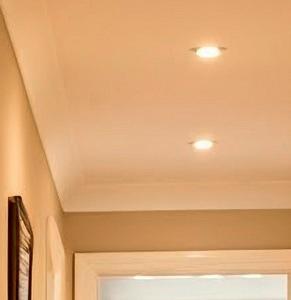
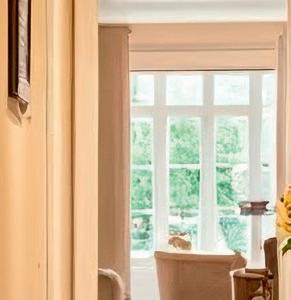




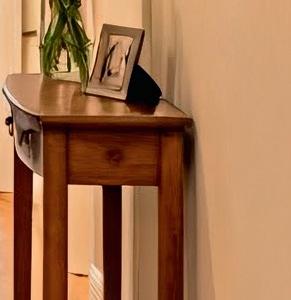










Fire risk assessment inspections should be just the start of a continuous process of safety review
ire precautions legislation changed in 2006 with the introduction of the Regulatory Reform (Fire Safety) Order (RRFSO), which simplified fire safety requirements by replacing 118 pieces of legislation, including the repeal of the Fire Precautions Act 1971, and the revocation of the Fire Precautions (Workplace) Regulations 1997.
The RRFSO is part of the Government’s commitment to reduce the incidence of death and injury caused by fire, and places a responsibility on a responsible person, outlining all the measures that must be taken to ensure that safety of all the people he/she is either directly or indirectly responsible for. It requires the responsible person to ensure the completion of a fire risk assessment and to take suitable steps to remove or reduce fire hazards.
In workplaces, fire risk assessments have been required for some time under the Fire Precautions (Workplace) regulations 1997, and many premises were required to obtain a fire certificate from the fire service
under the Fire Precautions Act 1971. But the RRFSO requires the responsible person to carry out a fire risk assessment of their premises and to take suitable steps to remove or reduce hazards as far as possible. It also requires the responsible person to ensure they have appointed competent persons who have specified duties for fire safety within the workplace.
There is a danger that a fire safety risk assessment will be an exercise completed in isolation and then forgotten about. In fact a fire safety risk assessment inspection should be just the start of a process, supported by remedial actions to correct issues that were identified in the initial inspection, and regular reinspection by a qualified, experienced and insured inspector.
Fire safety risk assessments can be applied to a wide range of properties from social and private housing to commercial buildings, public, heritage and listed
buildings, healthcare premises, stadiums and large places of assembly, and can be carried out at several stages; preoccupancy, post-occupancy, and post-fire.
When the Fire Safety Order was introduced in 2006, it placed a legal requirement for all businesses to have a Fire Safety Risk Assessment, and for this to be “Suitable and Su icient” and also carried out by “Competent Persons”. In simple terms, that’s the law and it’s what you need to do to fulfil your statutory requirements. As the fire safety industry moves forward, professional organisations and public bodies from the National Security and Safety Inspectorate (NSI) to the British Association of Fire Engineers (BAFE) have introduced a National Scheme for accrediting companies and individuals providing Fire Safety Risk Assessment services.
The local Fire and Rescue services are responsible for enforcing the RRFSO, but are also on hand to provide help, support and advice where required. ■

Looking for a home upgrade that combines security, style, and practicality? Aluminium roller shutters—also known as continental shutters—are growing in popularity across the UK, and for good reason. Here’s why they’re a smart investment:
1. ENHANCED SECURITY
Aluminium shutters create a strong physical barrier for doors and windows, deterring intruders while blending in with your home’s design—unlike bulky security grilles.
2. WEATHER PROTECTION
Built to withstand the British climate, they block wind, rain, and dust. Ideal for coastal or exposed properties, they also reduce outside noise, creating a more peaceful home.
3. IMPROVED INSULATION
Optional insulation helps retain warmth in winter and block heat in summer, boosting energy efficiency and cutting down on energy bills—while also enhancing soundproofing.


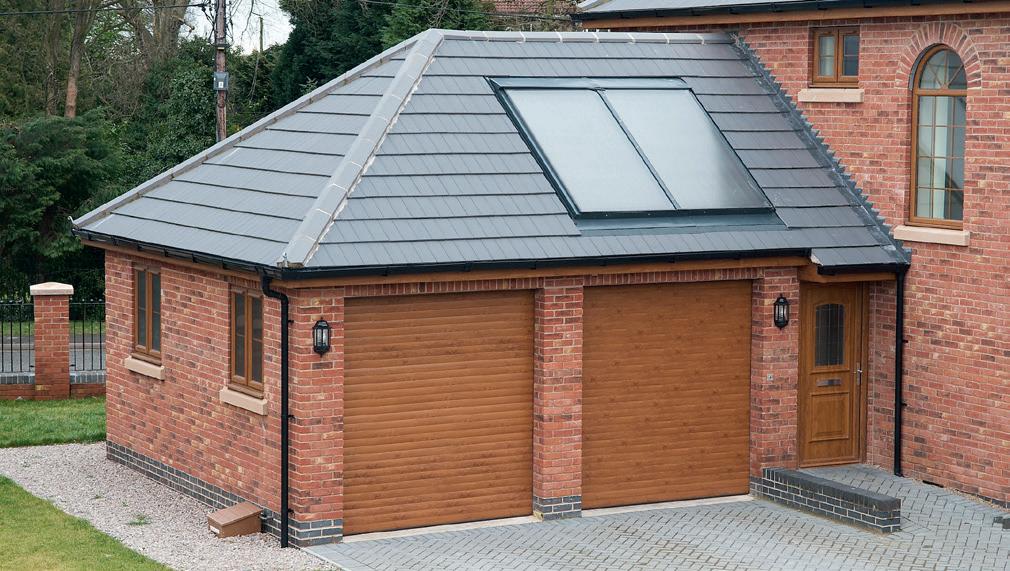
4. LOW MAINTENANCE & DURABLE
Resistant to rust and corrosion, aluminium shutters need minimal upkeep and are built to last, even in harsh weather conditions.
5. BOOSTS PROPERTY VALUE
Roller shutters can make your home more appealing to buyers and may even lower your home insurance premiums thanks to their added security.
6. CUSTOMISABLE DESIGN
Available in a wide range of colours and finishes, they can be tailored to fit any window or door, complementing both modern and traditional homes.
7. EASY OPERATION
Choose from manual or motorised options—many models even integrate with smart home systems for automated control and added convenience.























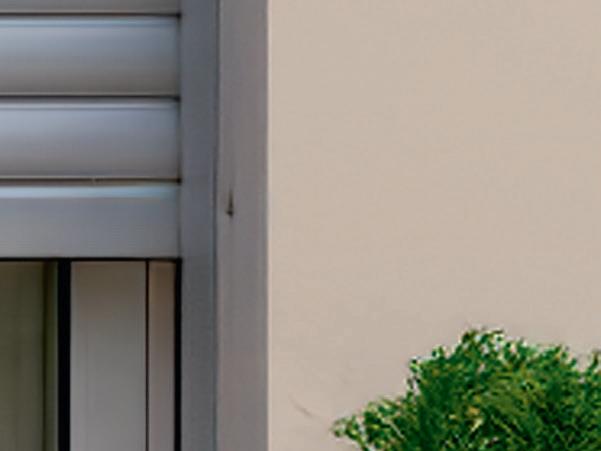




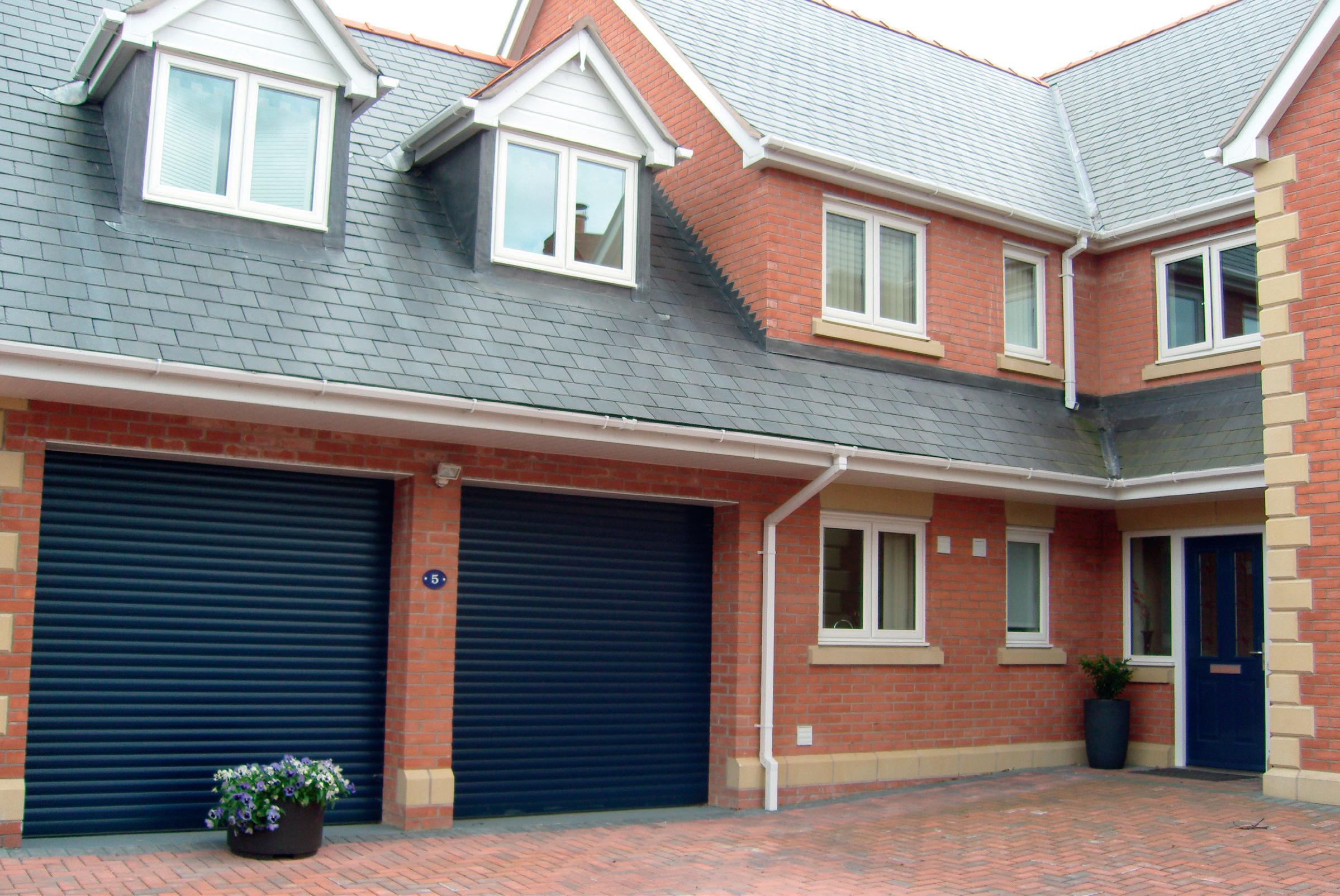
Roller shutters are a versatile and practical solution for homes, businesses, and industrial properties
Roller shutters used as window or door coverings have evolved significantly over the years, offering not only enhanced security and privacy but also contributing to energy efficiency, sound insulation, and aesthetic appeal. Whether you are considering roller shutters for your home or commercial establishment, understanding their multifaceted benefits can help you make an informed decision.
One of the primary reasons people invest in roller shutters is to enhance the security of their properties. Scott Wale, Director of UK Roller Shutters, says: “A home is not just a shelter, but a statement of security, efficiency, and resilience. Aluminium roller shutters don’t just protect
your house - they safeguard your peace of mind, insulate your future, and elevate the very essence of what it means to feel at home.”
Roller shutters provide a strong, physical barrier that makes it difficult for burglars or intruders to access windows or doors. The durable materials used in roller shutters, such as aluminium or steel, can resist tampering, and their secure locking systems add an additional layer of protection. This makes them a superior choice for those looking to safeguard their homes or businesses from break-ins. The added security is particularly beneficial for ground-level windows, commercial establishments with valuable inventory, or properties in high-crime areas.
Privacy is another key benefit of roller shutters. These window coverings provide a solid barrier against the outside world, preventing prying eyes from looking inside your property. Whether you live in a busy urban area, near a public space, or close to neighbours, roller shutters offer a simple yet effective way to maintain privacy. If however you need vision or airflow, perforated or punched roller shutters offer those options.
Energy efficiency is becoming an increasingly important consideration for homeowners and businesses alike. Roller shutters can significantly reduce heat loss during the colder months as well as keeping interiors cooler during the summer,
all leading to lower energy bills.
Another advantage of roller shutters, especially in noisy urban areas or properties near airports, highways, or railways, is their ability to provide sound insulation. Roller shutters can reduce the amount of external noise that enters your home or business, providing a more comfortable environment.
Roller shutters are also effective in protecting your property from the elements. Whether it’s heavy rain, strong winds, or intense sunlight, roller shutters act as a barrier to prevent weather damage, protecting windows from debris and harsh weather conditions.
Roller shutters can also reduce the effects of direct sunlight on your furniture, carpets, and interior decor. Prolonged exposure to the sun’s UV rays can fade colours and materials over time, but roller shutters can block out harmful rays, preserving the condition of your interior spaces.
Beyond their practical benefits, roller shutters also enhance the aesthetic appeal of your property. Modern roller shutters
are available in a wide range of colours, finishes, and styles, making it easy to match them to the architectural design of your home or business. Whether you have a traditional, contemporary, or minimalist style, roller shutters can complement your exterior decor and add a sleek, modern touch to your windows and doors.
Additionally, roller shutters can increase the curb appeal and value of your property. Potential buyers or renters will appreciate the added security, energy efficiency, and aesthetics that come with having roller shutters installed. This makes them a smart investment for homeowners looking to enhance the overall value of their property.
Modern roller shutters are designed to be user-friendly and convenient. Many roller shutters come with manual or motorized options, allowing you to open and close them effortlessly. Manual roller shutters can be operated with a simple chain or pulley system, while motorised versions can be controlled remotely via a switch, app, or even voice commands with smart home integration.
Automation is a growing trend in roller shutters, with features such as timers or
sensors that allow the shutters to open or close based on the time of day or weather conditions. This makes them even more convenient, as you don’t have to manually adjust them. Additionally, motorised roller shutters are quieter and require less effort to operate, making them ideal for individuals with mobility issues or those who simply want more convenience in their daily lives.
Roller shutters are relatively low maintenance compared to other types of window coverings. They are built to withstand the elements and are designed to last for many years with minimal upkeep. Regular cleaning, which typically involves wiping down the surfaces, is often enough to keep them in good condition.
In addition, modern roller shutters are equipped with durable, corrosionresistant materials, meaning they are less likely to degrade over time, even when exposed to outdoor conditions. This makes roller shutters a long-term, cost-effective solution for homeowners and business owners alike. ■

The Italian phrase for ‘the sweetness of doing nothing’ sums up an interior design trend which places a premium on leisure
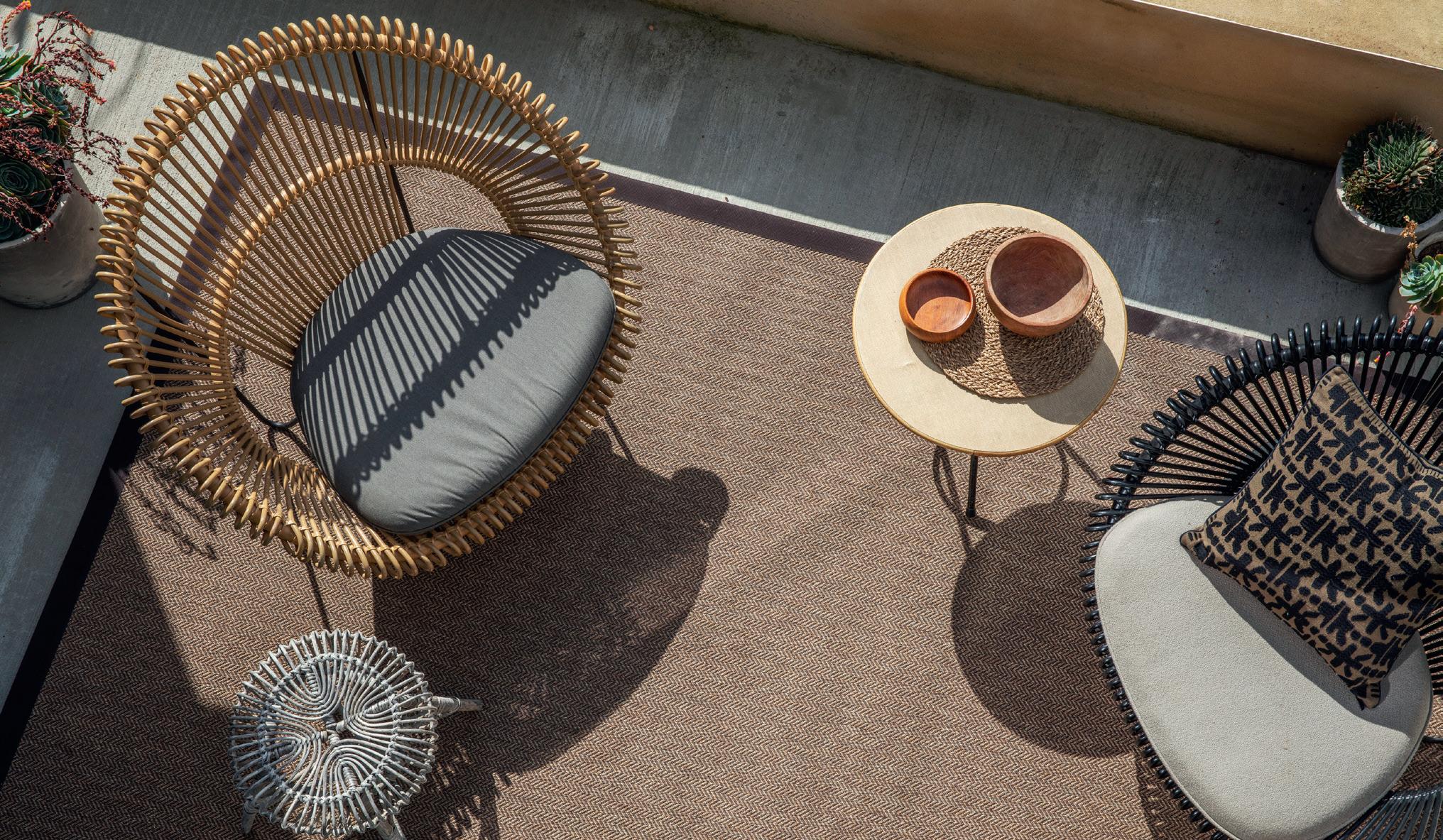
In a world that praises productivity, hustle culture, and relentless ambition, the Italian phrase la dolce far nientetranslated as “the sweetness of doing nothing” - emerges as a gentle push back. It’s about more than just leisure, or rest - it’s an art, a mindset, and a cultural cornerstone that invites us to savour the present without guilt or distraction.
But what does it really mean to “do nothing”? And how is this concept reflected in interior and exterior design?
La dolce far niente has deep roots in Italian culture. While its literal translation may smack of idelness or indulgence, in Italy, it’s
seen as a legitimate and even necessary part of life. It’s about slowing down, enjoying small pleasures, and allowing oneself to simply be.
The phrase gained global popularity through literature, cinema, and travel. One of the most iconic modern references comes from the 2010 film Eat Pray Love, where the protagonist learns to appreciate life’s simpler joys during her time in Italy. In a scene where she’s chided for feeling guilty about taking a break, her Italian friend tells her: “You Americans. You work too hard. You get burned out. Then you come home and spend the whole weekend in your pajamas in front of the TV. But you don’t relax. You don’t know how to enjoy.”
This sense of relaxation is reflected in the
Italian influence on interior design, furniture, and outdoor living.
Italy has long been a powerhouse in the world of art, architecture, and design. From the Renaissance to the modern day, Italian influence has consistently shaped global aesthetics. When it comes to interior design, furniture, and outdoor fittings, Italian style is synonymous with sophistication, craftsmanship, and a deep appreciation for beauty in everyday living.
Italian design is rooted in a rich tradition of craftsmanship that dates back centuries. The Renaissance period, with its emphasis on proportion, harmony, and artistic detail, set the foundation for Italy’s enduring design principles. This legacy continues to inform
the sleek lines and refined finishes that characterize Italian interiors today.
Modern Italian furniture brands marry classic techniques with contemporary innovation. Their pieces are often minimalist in form but luxurious in material - think buttery leathers, finely grained woods, and hand-finished metals. The result is furniture that doesn’t just furnish a space, but elevates it.
Italian interiors often blend tradition with modernity, achieving a balance between old-world charm and contemporary flair. Key features include:
h Open, airy spaces that reflect the Mediterranean lifestyle
h Neutral colour palettes punctuated with rich accents—terracotta, gold, olive green
h Natural materials like stone, marble, and wood
h Statement lighting, often sculptural and artistic
h Functional elegance, where form never sacrifices usability
Whether in a city apartment or countryside villa, Italian interiors are designed to be lived in - beautiful, but never overly ornate or impractical.
Italians also understand the value of la vita all’aperto - life outdoors. Italian influence on exterior fittings and outdoor furniture emphasizes comfort, style, and a strong connection to nature.
Terracotta pots, wrought iron furniture, travertine patios, and vine-covered pergolas are staples of the Italian garden. These elements not only withstand the Mediterranean climate but also create an inviting and timeless ambiance.
Italian brands often take traditional outdoor aesthetics and adapt them for modern lifestyles, offering weather-resistant yet stylish collections that echo the warm, relaxed feel of the Italian giardino.
Italian design has left a clear mark on homes and gardens across the world. From the clean lines of Milanese modernism to the rustic charm of Tuscan farmhouses, these design styles continue to inspire architects, decorators, and homeowners alike.
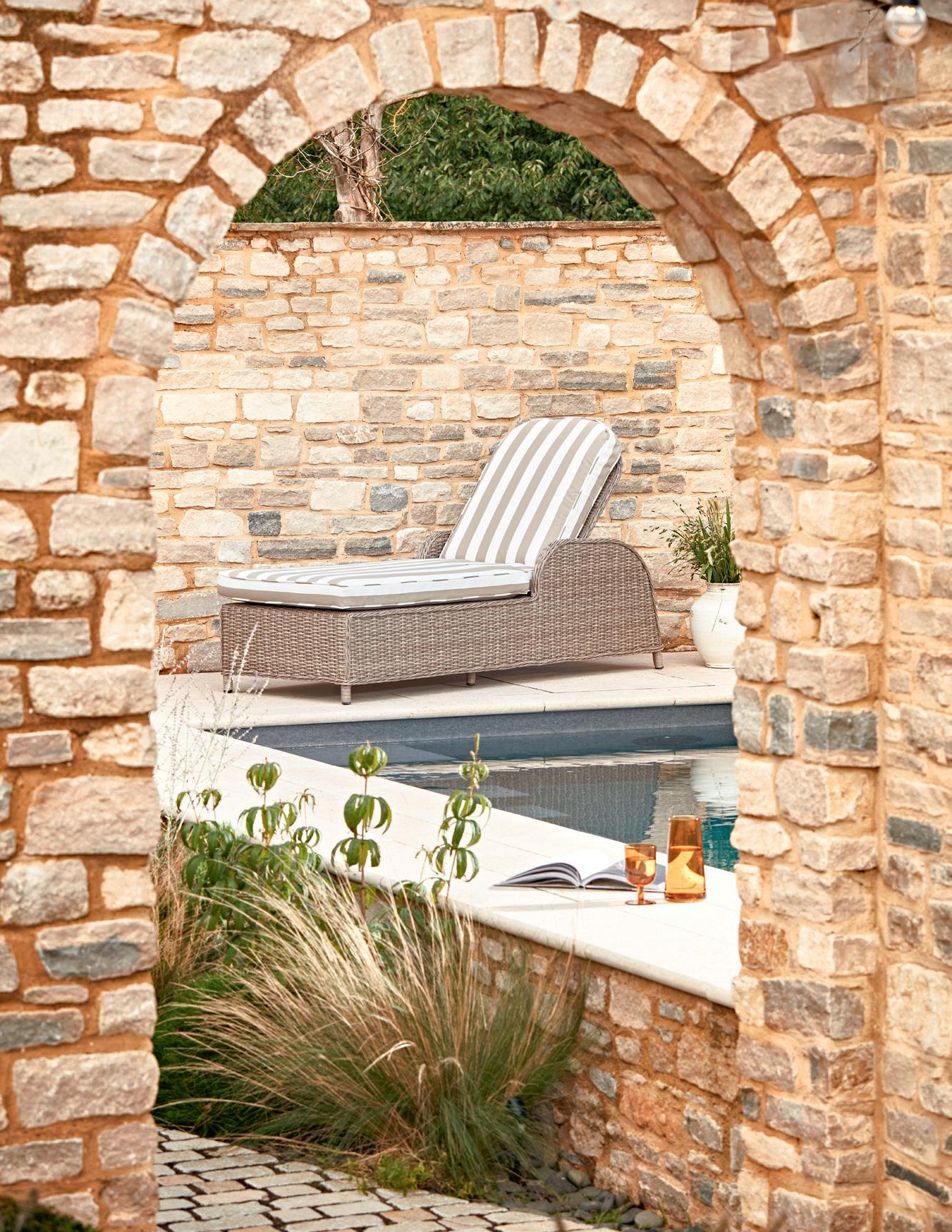
What makes Italian design so enduring is its ability to blend beauty and function, tradition and innovation. It invites people not only to decorate their spaces but to live in them fully, surrounded by materials and objects that reflect craftsmanship, culture, and care.
In essence, the Italian approach to interiors and outdoor living is more than just aesthetics - it’s a lifestyle, one that celebrates elegance, quality, and a deep-rooted love for the art of living well.
In many Western societies, worth is often tied to output. You’re only as valuable as your productivity. Even leisure is frequently structured: vacations packed with itineraries, hobbies with competitive goals, and downtime used for “personal development.”
In contrast, la dolce far niente demands a different kind of attention. It’s the absence of plans. The freedom to sit at a café, sip espresso, and watch people pass by. To lie on a sun-drenched bench with no phone, no agenda, no inner voice screaming “you should be doing something.”
To master this art, one must cultivate comfort with stillness. This means confronting the anxiety that can come with unstructured time.
In this stillness, however, there’s room for reflection, imagination, and even creativity, particularly in interior design. Many great ideas and moments of insight are born not in the bustle of busyness but in the quiet inbetween spaces where the mind is allowed to wander. »
Of course, there is more to embracing la dolce far niente than your choice of furniture and fittings;
Schedule Unstructured Time
Yes, it’s a bit ironic, but sometimes the only way to protect your “nothing” time is to block it off like a meeting. Use that hour to sit in the park, lie on the couch, or just stare out the window. Don’t read, scroll, or plan - just be.
Savour the Little Things
Next time you drink your morning coffee or tea, try doing it without multitasking. No emails, no social media. Just sip, taste, smell, and notice.
Mindfulness doesn’t always mean meditation. It can be as simple as sitting quietly and noticing your surroundingsthe rustle of leaves, the hum of the fridge, the rhythm of your breath.
Unplug Regularly
Give yourself tech-free time each day. Leave your phone behind when you go for a walk. Resist the urge to fill every silence with a podcast or playlist.
Redefine Productivity
Shift your mindset. Rest is not wasted time. In fact, it’s essential. Recharging makes you more focused, creative, and emotionally resilient.
Ultimately, la dolce far niente is not about laziness or escapism. It’s a philosophy that values presence over performance. It invites us to experience life in all its textures, not just the high points or achievements, but the quiet moments too. This idea resonates far beyond Italy and influences the culture of design in other cultures. In Denmark, there’s hygge - a sense of cozy contentment. In Japan, ikigai encourages a balance between purpose and pleasure. These cultural concepts, like la dolce far niente, reflect a universal yearning for deeper connection and slower living. ■



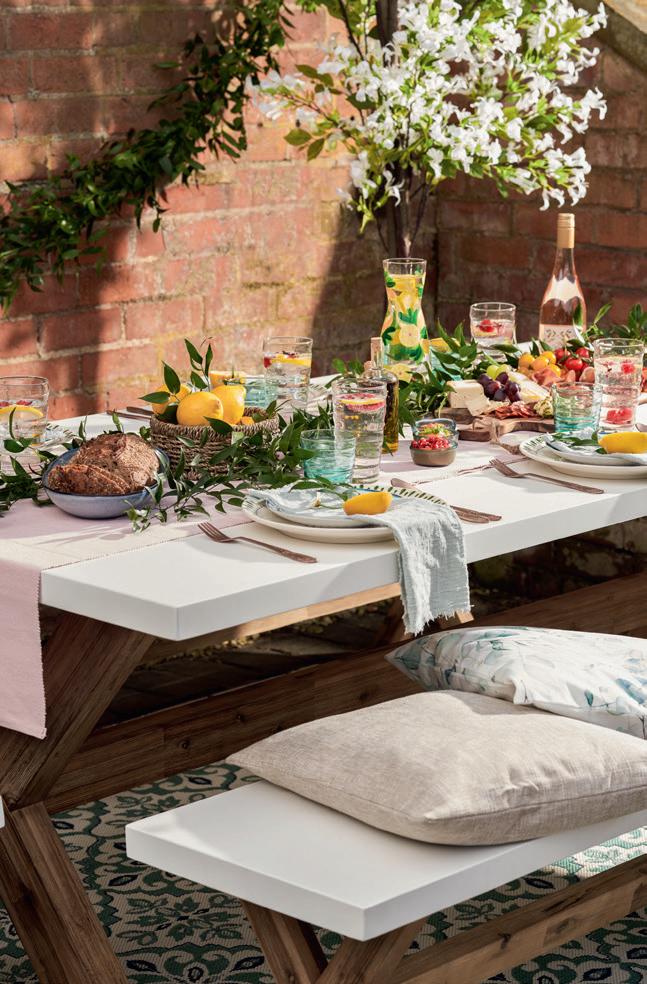
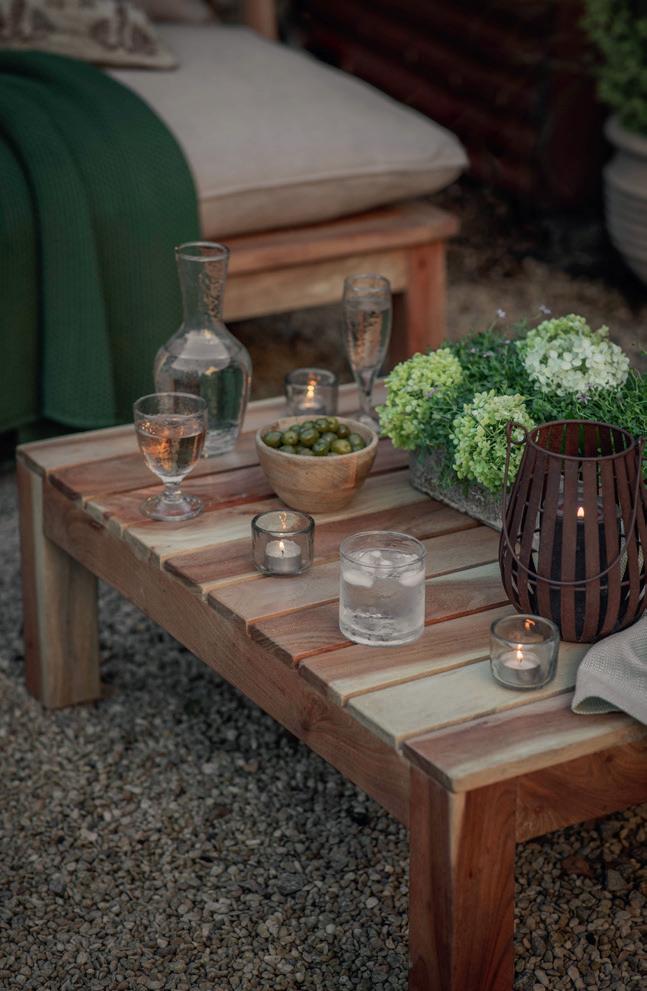










From dog gardens to makeovers and dens to dining, all the latest ideas and trends in the garden market
MONTY DON’S DOG GARDEN
Celebrating the UK’s reputation as a nation of dog lovers and garden enthusiasts, the RHS and BBC Radio 2 are joining forces with Monty Don to create a garden for man’s best friend.
The RHS and BBC Radio 2 Dog Garden will be the first garden at RHS Chelsea Flower Show to be designed by BBC Gardeners’ World’s Monty Don, whose dogs often feature on the programme.
Clare Matterson, RHS Director General, says: “It’s exciting to be working with Radio 2 and Monty Don to create a garden that celebrates the connection between two of the UK’s greatest loves – dogs and gardens. Nothing lifts us like a beautiful garden, and then, for a little bit of extra joy, we’ve added some wagging tails.”
With the nation’s dog owners wanting beautiful spaces for them and their furry friends, The RHS and BBC Radio 2 Dog Garden will inspire the millions of dog lovers at home to create green havens for them and their pets. Monty wants the garden to be both an exemplar of all the things that dogs love, regardless of horticultural fashion, and a


beautiful space that any dog owner would love too.
The RHS and BBC Radio 2 Dog Garden will feature daisies, dandelions and clover that are being painstakingly transplanted from RHS Garden Wisley into the turf destined for RHS Chelsea 2025.
These stalwarts of the garden, though not always planted intentionally, provide pollen for wildlife, help mitigate drought, and go far in improving the hardiness of the lawn - which is just what we need for a garden enjoyed by our four-legged friends.
Although Monty Don has presented BBC coverage of RHS Chelsea for many years, this will be the first Garden he will be bringing to the show himself. In 2022, Monty was awarded the RHS Victoria Medal of Honour (VMH), the highest honour in horticulture. Since 2011 the programme BBC Gardeners’ World has been presented from Monty’s own garden, Longmeadow, where his beloved dogs can be seen playing, sleeping or sometimes getting in the way, as Monty carries out his gardening jobs.
After RHS Chelsea Flower Show, the RHS and BBC Radio 2 Dog Garden – except the plants harmful to dogs –will live on across the River Thames at Battersea for all the rescue dogs and the people who work and volunteer there to enjoy.
www.rhs.org.uk

Consumer magazine Which? has published its top tips for a garden makeover on a budget. The idea is to make the maximum impact with a few smart and a ordable changes. Here are the headlines:
Hang some solar garden lights
Bring some ambience into your garden with outdoor lights - it’s one of the easiest ways to make your garden feel magical after dark. Many use solar energy so cost nothing to run, or you can find lights with an optional USB cable for an added boost of power.
Tidy the edges
You might be surprised at what a di erence a tidy lawn can make. Investing in some edging shears can ensure your grass always looks neat, plus they’re quieter than a grass trimmer.
Spruce up your fencing
A tired-looking fence can make any garden feel unpolished. To add some character - and durability - to your fence, give it a coat or two of paint.
Add a barbecue
Barbecues needn’t be expensive. A miniature version can be a great option and is easy to clean and maintain.
Raise your garden beds
Raised beds can help you grow veg in a limited space, making everything in your garden feel a little more organised and helping your household budget. You can make raised garden beds yourself with wooden planks, or buy a pre-made kit.
www.which.co.uk

The Den Kit Company are passionate advocates of outdoor play and aim to inspire families to get into the great outdoors wherever possible. The brand’s award winning Den Kits are available in a variety of themes and designed to encourage children outside - whether a tiny backyard, the woods, beach or balcony. All of the kits are lovingly made in the UK and all free of single-use-plastic, batteries or complicated instructions. thedenkitco.com
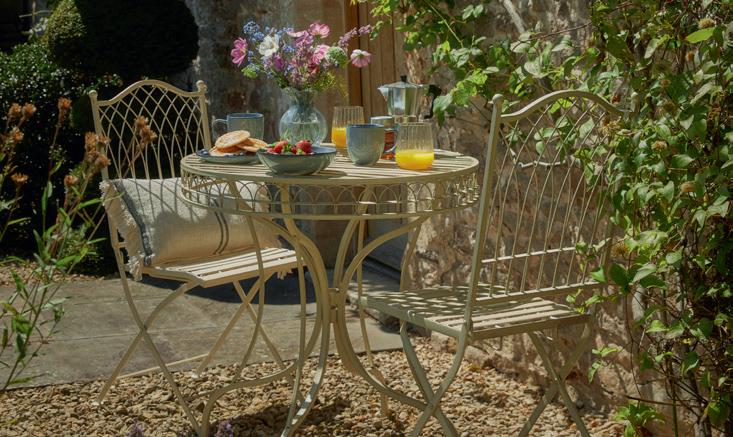
To achieve a French château look in the garden, opt for elegant metal furniture that exudes timeless charm. Cox & Cox o ers a range of café-style bistro sets, benches, and ornate, tiered plant stands that bring a touch of Parisian sophistication to your outdoor space. Pair your metal furniture with soft linen cushions, trailing wisteria, and stone planters for an authentic château feel.
www.coxandcox.co.uk
In an era where space is at a premium, more homeowners than ever are looking for innovative ways to expand their living areas without the hassle of moving. One of the most effective solutions? A beautifully designed garden room. Companies like Cabin Master are transforming outdoor spaces into versatile, stylish extensions of the home, providing year-round comfort and functionality.

Garden rooms are no longer just an aesthetic addition; they are practical, multi-functional spaces that enhance everyday living. Whether it’s a dedicated home office, a peaceful retreat, or an entertainment space, a bespoke garden room offers endless possibilities. Utilising high-quality insulation and hard-wearing materials, these structures are designed for use in all seasons, seamlessly integrating with any lifestyle.
Beyond their immediate benefits, garden rooms also boost property value. With the growing demand for home offices, outdoor bars, annexes and gyms, having a dedicated garden space makes a property stand out in the market. Unlike traditional home extensions, garden rooms rarely require planning permission, and are far more convenient & quick to install, making them a straightforward and cost-effective investment.
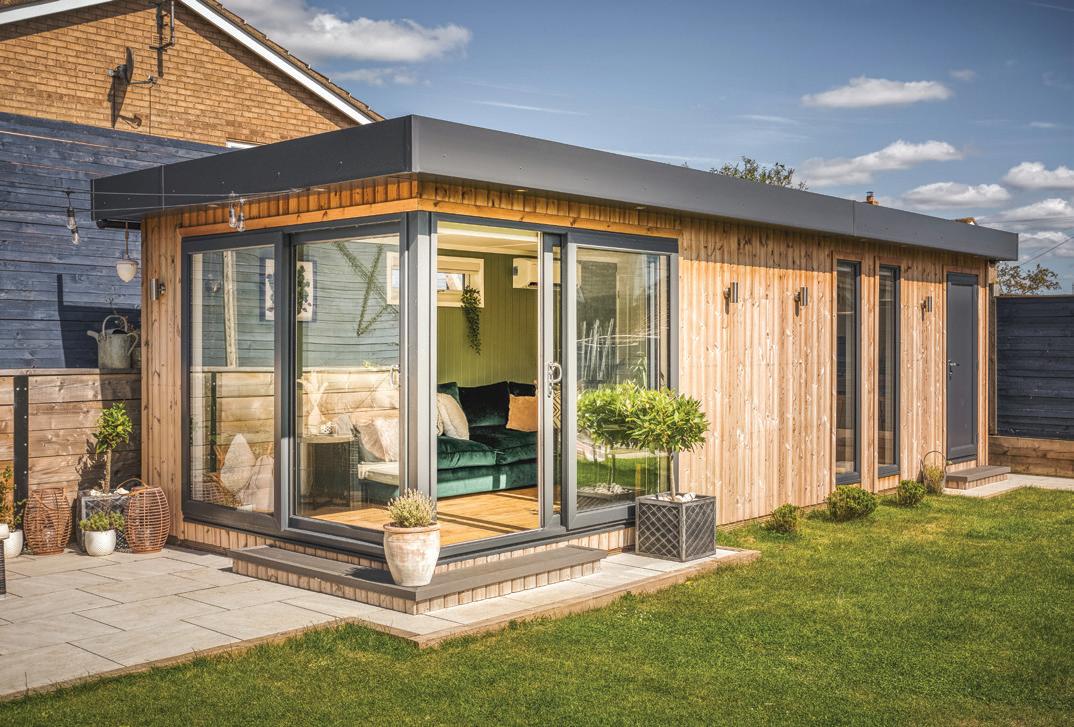
The beauty of a garden room lies in its versatility and design. Cabin Master specialises in creating bespoke structures that complement outdoor spaces, using premium materials to ensure durability and energy efficiency. Whether you prefer a contemporary finish or a rustic aesthetic, these rooms can be tailored to suit individual tastes and needs.
For those considering a garden room, now is the perfect time to explore the options. Visit www.cabinmaster.co.uk to discover how a bespoke outdoor space can transform your home and lifestyle.
Visit one of our show sites: 1000s of
Cabin Master Village
251 Toton Lane, Stapleford, Nottingham NG9 7JA 0115 932 8888
Studley Garden Centre Henley Road, Studley B80 7DR 01926 757975
info@cabinmaster.co.uk
Whether you are looking for a bar, a gym, an office or a studio, a quality timber garden room will fit the bill
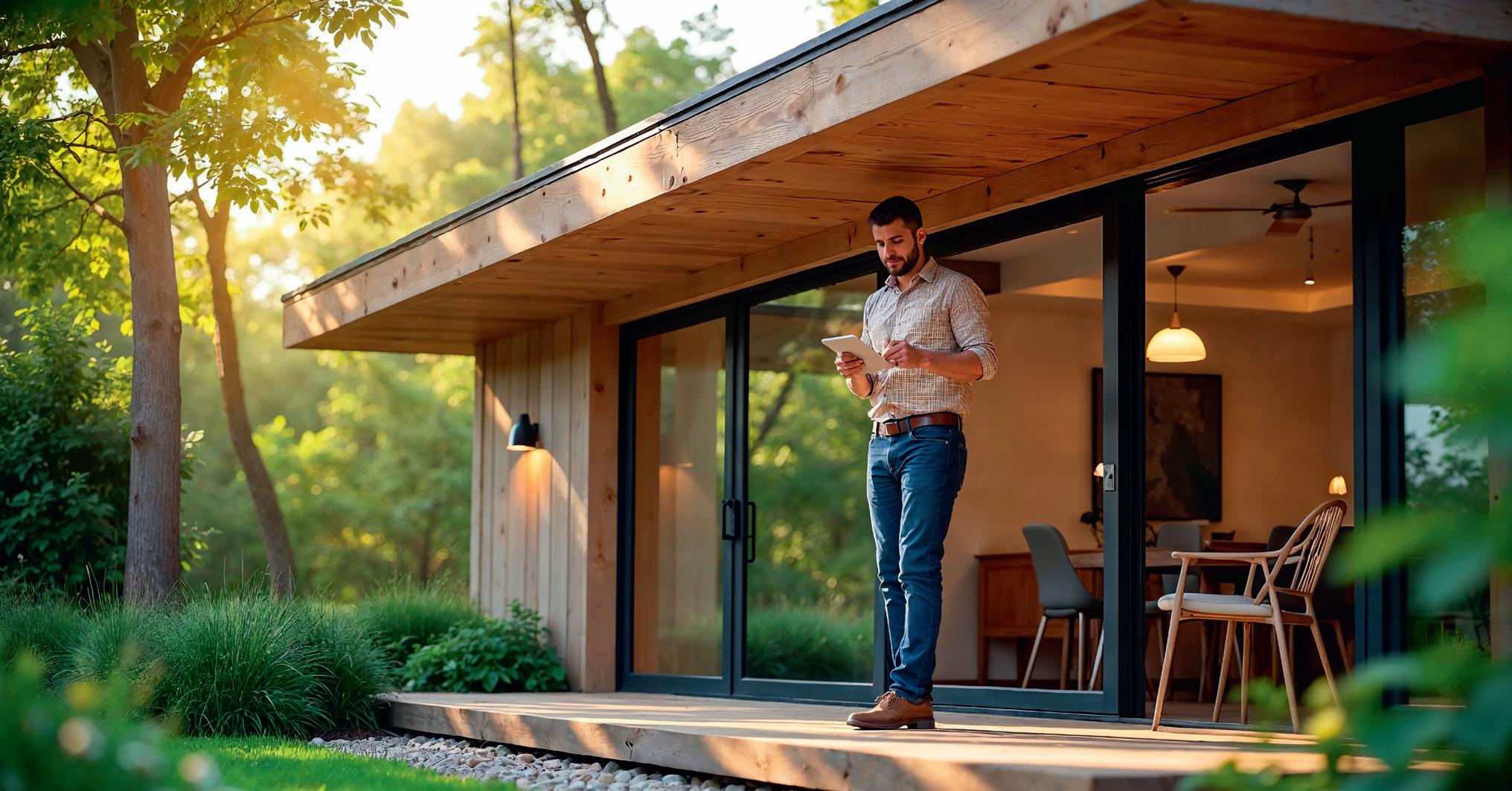
Bespoke, fully insulated timber garden buildings can be tailored to various needs, including workspaces, leisure areas, and additional living spaces. With the right facilities and fittings, garden rooms can be used as offices, gyms, bars, barbecue photography studios, and a lot more, all designed to enhance outdoor living and provide versatile spaces.
Energy-efficient garden rooms can have cladding options such as FSCcertified Western Red Cedar and PEFC/ FSC Scandinavian Redwood, and can be designed to be energy-efficient, providing a comfortable environment year-round. Optional features often include internal partitions, flooring, and lighting, added to suit individual preferences.
A garden office can provide a dedicated workspace away from the main house, promoting a healthy work-life balance. Garden offices would normally be fully insulated and come equipped with
double-glazed windows, internal electrics, and flooring.
A garden bar can transform an outdoor space into a stylish entertainment area, and can be designed to suit various themes, from traditional pubs to modern lounges. With features including highquality cladding, double-glazed doors and windows, and optional lighting, these bars provide ample space for hosting guests and enjoying drinks in a cozy setting.
A garden gym can offer a private and fully equipped space for fitness enthusiasts. These gyms can be customised with different zones for cardio, strength training, and yoga, with options including internal partitions, durable flooring, and highquality cladding materials. Garden gyms are usually fully insulated, ensuring comfort during workouts throughout the year.
A barbecue cabin, designed for outdoor cooking and socialising, can feature a
central hearth and seating area, creating a warm and inviting atmosphere, and again will be fully insulated, allowing for year-round use. These cabins are ideal for gatherings, providing a unique and cozy setting for dining and relaxation.
The advantage of a bespoke timber garden building is that the room can be purpose built for any imaginable application, such as a photography studio, with features such as full insulation, and customised electrical supplies for lighting and other equipment. The custom design process offers a comprehensive service from design to installation, including site surveys, CAD drawings, base installation, delivery and aftercare. There’s normally an opportunity to examine options and receive personalised consultations at show sites, so your bespoke garden building can be tailored to meet diverse needs and preferences. ■
Spring is the time to leap into action in the garden – from tidying, to planting, there’s always something to be done
As the chill of winter recedes and the days get longer, spring presents the perfect opportunity to breathe new life into your garden. The UK’s temperate climate means that gardeners have to be mindful of the varying weather patterns, but with the right preparation and tasks, your garden can thrive throughout the warmer months. Spring is a busy period for gardeners, with essential tasks to ensure plants grow
strong, flowers bloom, and the garden remains a sanctuary for relaxation and enjoyment. Here are some key jobs to do in the garden in spring in the UK.
1. Tidy Up the Garden
The first task to tackle when spring arrives is tidying up your garden. Over the winter months, fallen leaves, debris, and frostdamaged plants can accumulate. Begin by clearing away any dead foliage, twigs, and
other unwanted material from flower beds, lawns, and pathways. Removing debris not only makes your garden look neater, but it also reduces the risk of pests and disease hiding in the decaying material.
Pruning is another important part of tidying up. Dead, diseased, or damaged stems and branches from trees and shrubs should be pruned back to allow healthy growth in the coming months. Be cautious when pruning flowering shrubs, as some


plants bloom on old wood and could lose their flowers if cut back too early. Always check the specific requirements for each plant.
2. Prepare Your Soil
Spring is the ideal time to give your soil a little TLC. Soil tends to get compacted and depleted of nutrients over time, especially if it has been left to rest during the colder months. Begin by assessing the condition of your soil. If it is heavy clay or sandy, you may want to add organic matter such as compost, manure, or leaf mould to improve its texture and nutrient content. Mixing in organic matter helps improve drainage, enhances aeration, and provides nutrients to plants.
If you have vegetable patches or flower beds, now is also a good time to enrich the soil with fertilisers or soil conditioners. If your garden’s soil has been tested, you’ll know whether it requires treatment to raise or lower the acidity. Adding compost is also an excellent way to ensure your soil is ready for planting.
3. Start Planting Early Vegetables
Spring is the time to start planting earlyseason vegetables in the garden. If you
have a greenhouse or a sunny spot, you can begin sowing seeds for crops like peas, beans, carrots, radishes, and spinach. You may also want to plant early potatoes in well-drained soil. These will provide a bountiful harvest before the summer heat takes hold.
If the weather is still unpredictable, you can start sowing seeds indoors and then transplant them outdoors when the risk of frost has passed. Always keep an eye on the weather forecast, as a late frost can damage tender young plants.
Weeds tend to flourish in the spring as temperatures rise and the soil begins to warm. The key to keeping weeds under control is to tackle them early before they have a chance to spread and establish deep roots. Regularly inspect your garden and remove weeds by hand, making sure to pull them out by the roots to prevent regrowth.
You can also use a mulch or weed barrier in flower beds and vegetable patches to help suppress weed growth. Mulch not only prevents weeds but also helps retain moisture in the soil and maintains a more consistent temperature for plant roots.
5. Maintain Your Lawn
Spring is the ideal time to give your lawn some much-needed care. Start by removing any debris, leaves, and moss that have built up during the winter months. This will improve airflow and help prevent fungal diseases.
Next, assess the condition of your lawn. If your lawn is patchy or thin, consider overseeding it with a grass seed mixture suited to the local climate. For areas with bare patches, you can create small divots and fill them with fresh turf or grass seed. A light fertiliser application will also encourage healthy growth.
Finally, mow your lawn regularly but never cut it too short. Keep the grass at a height of around 2.5–4 cm to maintain a healthy, resilient lawn that can tolerate the warmer weather. It’s also a good idea to feed your lawn with a spring fertiliser to encourage vigorous growth.
Spring is a time when many perennial plants start to emerge from dormancy. Check your perennials for any signs of pest damage or disease. If you spot any issues, take the necessary action, whether it’s treating with organic pesticides or simply »

removing affected plant material. Mulching around these plants can help protect them from early spring frosts and retain moisture. Spring is also an ideal time to divide certain perennials like hostas, daylilies, and irises. If your plants have outgrown their space or have become overcrowded, dig them up, divide them, and replant the sections to promote healthy growth. This is also a great way to expand your garden and share plants with friends or neighbours.
Spring brings new challenges in terms of pests and diseases. As temperatures rise, insects like aphids, and gastropods including slugs and snails become more active. Keep a watchful eye on your plants and take preventive measures to reduce the risk of infestations. You can introduce beneficial insects such as ladybirds to control insects like aphids naturally, or use slug pellets (organic, of course!) and
As the growing season begins, it’s crucial to prune trees and shrubs to ensure they stay healthy and strong throughout the year. Early spring is an excellent time to prune many types of trees and shrubs, particularly deciduous varieties, as they are still dormant or just starting to bud. This ensures they don’t lose energy or resources during the growing season.
For fruit trees, removing dead or damaged wood is essential to encourage strong fruit production. For ornamental trees and shrubs, pruning can help maintain shape and prevent overcrowding. Be sure to check the pruning needs for each species before getting started.
material barriers to protect tender plants. Additionally, check for fungal diseases like powdery mildew and blackspot on roses. Early intervention can prevent these problems from spreading and causing damage later in the season.
8.
Spring is an exciting time to add new plants to your garden. From vibrant spring bulbs like daffodils and tulips to hardy perennials and shrubs, there’s a wide variety of plants that can thrive in the UK climate. Consider creating new flowerbeds or updating existing ones with a mix of annuals and perennials to ensure colour and interest throughout the season.
If you’re interested in adding trees or larger shrubs to your garden, spring is a good time to plant them while the ground is still moist and temperatures are milder. Make sure to water them regularly and mulch around their base to retain moisture.
Spring is a time of rejuvenation and growth in the garden. Whether you’re a seasoned gardener or a beginner, taking the time to complete these essential tasks will set your garden up for success in the months ahead. ■























































































































































































Whether you’re looking to add value to your property or create a dedicated workspace, garden buildings o er a wealth of opportunities
Garden buildings have become a popular choice for homeowners looking to maximize the potential of their outdoor spaces. Whether you’re looking to add value to your property, create a dedicated workspace, or simply enhance your outdoor lifestyle, garden buildings o er a wealth of opportunities.
One of the most compelling reasons for investing in a garden building is the potential to increase the value of your home. Homebuyers are increasingly attracted to properties that o er flexible living spaces, especially in today’s remote work culture.
Garden buildings are o en seen as a coste ective alternative to home extensions. Rather than going through the lengthy and expensive process of building a traditional extension, you can install a garden building that is quick to construct and o en does not require planning permission (depending on its size and location).
Garden buildings are incredibly versatile and can be customised to meet your specific requirements. Whether you want a space to relax, work, or pursue a hobby, these structures can be designed and built to suit your vision. You can choose from a wide range of materials, sizes, and finishes to create a garden building that fits seamlessly with your property’s aesthetic.
Popular customisation options include the addition of windows, skylights, and doors that allow for plenty of natural light, creating an inviting and airy space. You can also choose from di erent flooring options, insulation materials, and electrical facilities to ensure your garden building is as functional and comfortable as possible.
As remote working becomes increasingly common, having a dedicated workspace at home is more important than ever. A garden building o ers the perfect solution. »
An increasingly popular style in garden buildings is the log cabin, available in a variety of styles to suit your personal tastes and the aesthetic of your property. Log cabins o er a wide range of design choices from the apex roof design featuring a sharp, pitched roof, practical for shedding rainwater and snow, to the more rounded, softer appearance of a cottage roof, or a lodge style, embracing a larger, more substantial structure with a focus on comfort and luxury. Often incorporating large windows and open spaces, this style is ideal for those who want to create a more grandiose garden building, perfect for use as a guest house, gym, or studio.
By creating a home office away from the distractions of the main house, you can establish a professional environment that fosters productivity.
When designing a garden office, insulation is key to ensuring comfort throughout the year. Insulated garden buildings maintain a stable temperature, keeping you cool in the summer and warm in the winter. A garden office also helps to create a clear boundary between work and home life, which is vital for maintaining work-life balance.
For those who enjoy exercising or pursuing creative hobbies, a garden building can be transformed into a fully functional gym or art studio. With ample space and the ability to design the layout to suit your needs, a garden gym offers the convenience of working out at home without the need for expensive memberships or crowded facilities. Whether you prefer yoga, weightlifting, or cardio, a garden gym
Another exciting opportunity offered by garden buildings is the potential for turning them into holiday rentals. If you live in a desirable location, a welldesigned garden building can be converted into a charming self-contained guesthouse or cabin. This provides an opportunity to generate extra income while giving guests a unique and comfortable place to stay.
Many homeowners have taken advantage of the growing trend of “staycations” and short-term rentals by converting garden buildings into vacation properties. With the right amenities, such as a kitchenette, bathroom, and cozy sleeping quarters, a garden building can provide all the comforts of home in a private and tranquil setting.
provides a private and personalized space to focus on your fitness goals.
Similarly, a garden building can serve as a dedicated space for artistic pursuits such as painting, photography, or music. The natural light and peaceful setting of a garden studio can inspire creativity, allowing you to immerse yourself in your work without distractions.
Garden buildings can also be transformed into a luxurious sauna or spa retreat, offering a private sanctuary for relaxation and rejuvenation. Whether you want a traditional wooden sauna or a more modern steam room, the flexibility of garden buildings allows you to create your dream wellness space.
Insulated garden buildings are perfect for this purpose, as they help maintain the temperature required for a comfortable sauna experience. By adding the right finishes, such as natural wood panels or tiled walls, you can create a soothing, spa-like atmosphere right in your own backyard. ■
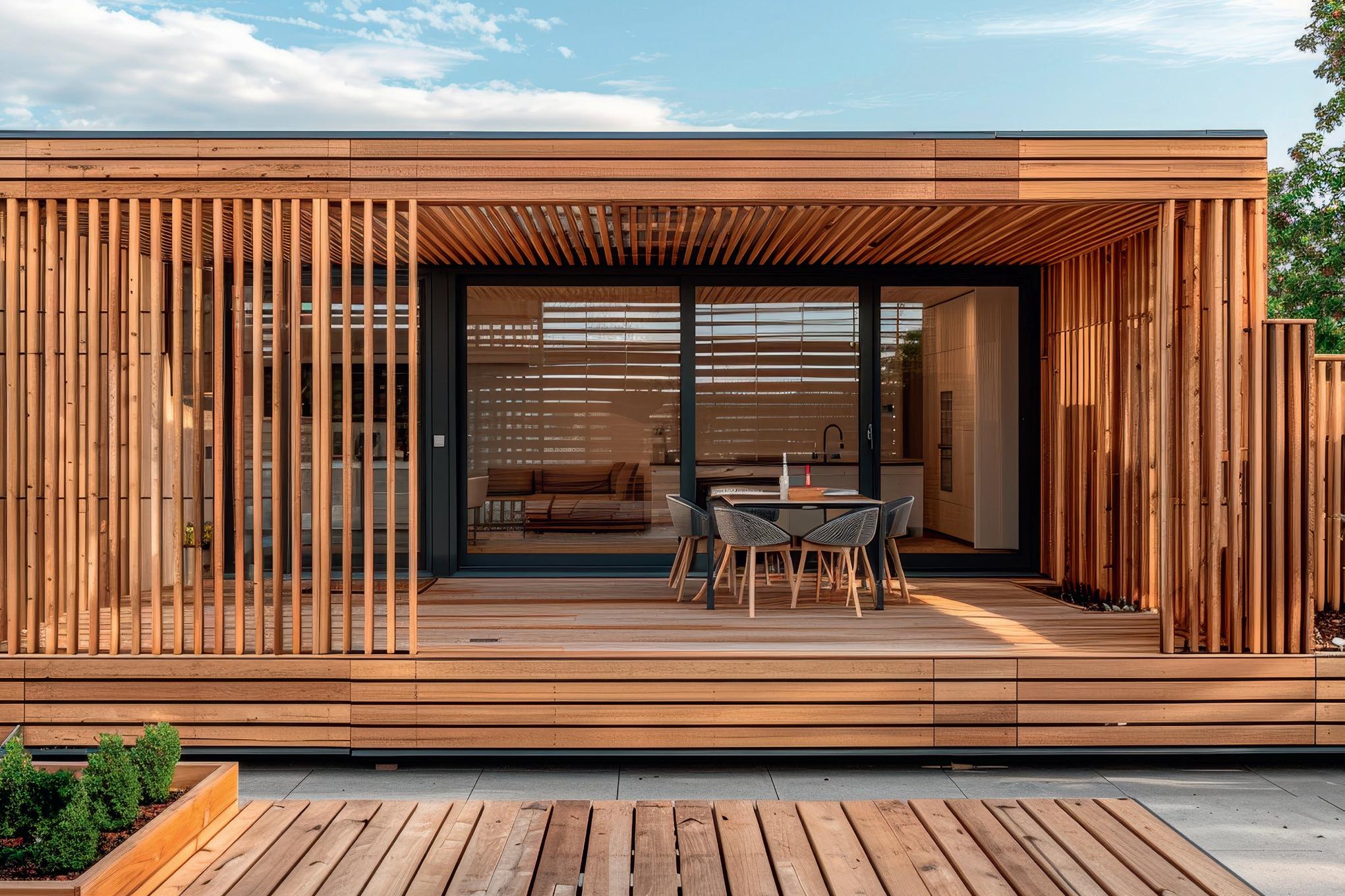



There are all sorts of options for paving your driveway, but resin could offer the best long-term value for money
Resin driveways have become an increasingly popular choice for homeowners looking to enhance their property’s curb appeal while also ensuring long-term durability and functionality. Resin-bound or resin-bonded driveways offer a modern alternative to traditional materials such as concrete, asphalt, or gravel. With a range of benefits including their remarkable durability, aesthetic flexibility, cost-effectiveness, and extensive colour options, resin driveways present a well-rounded and attractive solution for any home.
One of the most significant advantages of resin driveways is their impressive durability. Resin driveways are constructed by combining natural aggregates such as gravel, stone, or recycled materials with a polyurethane resin binder. This strong combination creates a surface that is highly resistant to wear and tear, as well as extreme weather conditions.
The main difference between resin bound and resin bonded surfacing lies in their application and resulting surface characteristics: resin bound is a permeable, smooth surface created by mixing resin and aggregate, while resin
bonded is a rougher surface achieved by applying resin and scattering aggregate on top.
Resin-bound driveways, in particular, are known for their resilience. The resincoated surface is not only resistant to cracking but also to heavy foot traffic, vehicle weight, and exposure to UV rays, meaning it won’t fade or deteriorate under the sun’s intense heat. Additionally, the smooth, hard-wearing surface prevents puddles from forming, ensuring that water drainage is efficient and reducing the risk
of flooding or standing water.
Driveways that will experience heavy use or support multiple vehicles should use a slightly larger aggregate size (2-5mm) and a deeper application thickness for maximum durability, while for sloped driveways, aggregates with angular edges rather than rounded pebbles provide better traction.
While all resin bound systems are permeable, properties with specific drainage challenges may benefit from additional drainage solutions incorporated into the driveway design, and you should consider how your driveway will transition to other landscaping elements such as lawns, planting beds, or adjoining pathways.
Beyond their functional benefits, resin driveways offer exceptional aesthetic appeal. The smooth and seamless finish creates a sophisticated and contemporary look that can enhance the overall appearance of any home, and you can even get extras such as your house number incorporated into the design of the pathway.
The smooth texture of resin driveways makes them safer to walk on compared to traditional gravel or asphalt surfaces, as there are no loose stones or rough patches that can cause tripping hazards.
While the initial cost of a resin-bound driveway may be slightly higher than a basic gravel or tarmac driveway, resin driveways are an affordable option when factoring in their long-term durability and low maintenance costs. Resin driveways require minimal maintenance to maintain their attractive appearance. Regular cleaning is usually sufficient to keep the driveway looking pristine. Unlike tarmac or concrete, which may require resealing or resurfacing every few years, resin driveways are far less prone to damage and do not need frequent maintenance or repairs.
The installation process generally takes just a few days, meaning fewer disruptions and a quicker turnaround for homeowners. One of the standout features of resin
driveways is the wide range of colours and finishes available. Homeowners can choose from a variety of colours, from natural earth tones to bolder hues, allowing for the creation of a truly unique and personalized driveway. Whether you prefer a classic, understated look or a driveway that makes a bold statement, the range of resin colours and textures provides ample options.
The colour options are not limited to standard shades, either. With resin driveways, you can mix and match different aggregates to create a bespoke driveway that complements your home’s exterior. Popular options include:
h Natural stone tones like beige, grey, or brown for a more traditional, rustic look.
h Grey and charcoal shades for a sleek, modern aesthetic.
h Bespoke colours such as green, red, or even a mix of vibrant hues for those looking to make a statement.
This level of customisation is ideal for homeowners who want their driveway to complement the surrounding landscape or blend seamlessly with the colour scheme
of their home. Additionally, because resin driveways are available in both matt and gloss finishes, you can choose a surface that either reflects light and creates a shiny appearance or maintains a more understated matte finish, based on personal preference.
Resin driveways can be an environmentally friendly option, as many resin-bound systems incorporate recycled aggregates and eco-friendly resin materials, making them a sustainable choice for homeowners looking to minimize their environmental impact. Furthermore, the porous nature of resinbound driveways allows for natural water drainage, which can help reduce runoff and prevent local flooding.
The durability, aesthetic flexibility, cost-effectiveness, and wide array of colours and finishes makes resin driveways a versatile option that can suit any property type, and with their long-lasting, low-maintenance solution, they are a smart investment for homeowners who want a functional, beautiful, and durable driveway that enhances the overall value of their property. ■
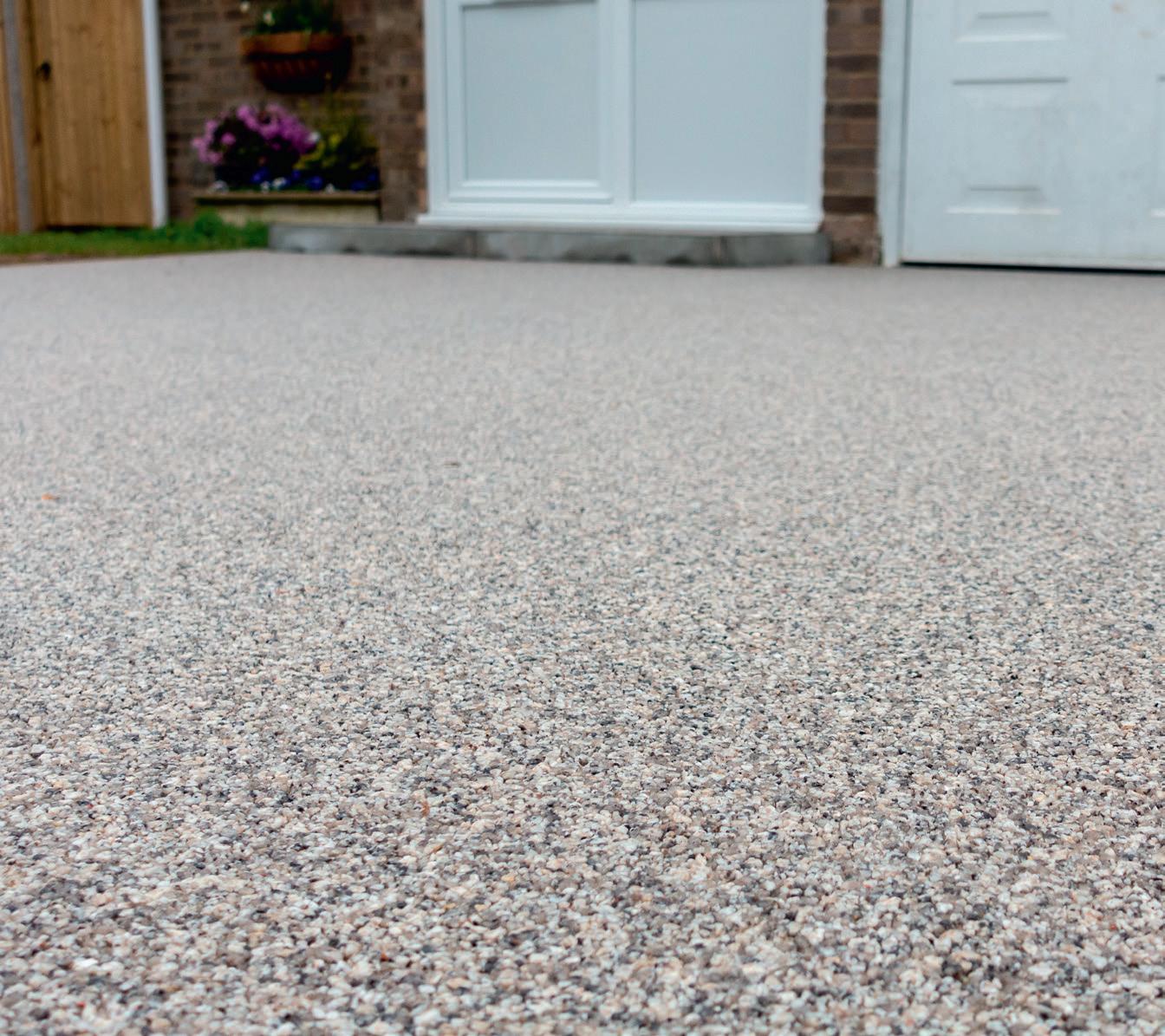
When it comes to enhancing the curb appeal and functionality of your outdoor space, few options offer the durability, elegance, and environmental benefits of a resin bound surface. Whether you’re revamping your driveway, patio, or pathways, Jurassic Home Solutions stands out as a trusted name in the industry — combining craftsmanship, innovation, and sustainability to deliver premium surfacing solutions across the UK.

Resin bound surfacing is a seamless blend of natural aggregate and high-quality resin, laid over a solid base to create a smooth, hardwearing, and visually appealing finish. Unlike traditional tarmac or block paving, resin bound surfaces are not only aesthetically versatile (available in a variety of colours and textures), but also permeable, allowing water to pass through and reducing the risk of standing water and flooding.
This permeability is what makes resin bound systems ideal for Sustainable Drainage Systems (SuDS) — a growing priority in modern landscaping and construction. In fact, surfaces that are SuDS compliant can help homeowners avoid the need for planning permission while doing their bit to reduce pressure on local drainage infrastructure.
SuDS Compliance: Smart for the Planet, Smart for Your Property
Sustainable Drainage Systems are designed to manage surface water runoff in a way that mimics natural processes. With more extreme weather events and increased urbanisation, effective water management is essential. SuDS-compliant surfaces, like those installed by Jurassic Home Solutions, ensure that rainwater seeps into the ground naturally, reducing the risk of flash flooding, water pollution, and soil erosion.
By choosing a SuDS-compliant resin bound surface, homeowners benefit from:
y Improved drainage and flood prevention
y Reduced need for planning permission
y Enhanced property value through eco-conscious design
y A safer, slip-resistant surface in wet weather

While the resin bound layer is key, the foundation beneath plays an equally critical role in the long-term performance of the surface. Jurassic Home Solutions uses porous concrete as a base layer for all of their installations — a strategic choice that boosts both durability and drainage performance.
Porous concrete, also known as pervious or permeable concrete, is designed with a high void content, allowing water to pass straight through. This means the entire surfacing system — from top to bottom — works together to manage rainwater effectively, ensuring your driveway or patio stays dry, safe, and structurally sound.
In contrast to compacted hardcore or non-porous bases, porous concrete eliminates water pooling beneath the surface and reduces freeze-thaw damage in winter. It also helps prevent weed growth and sinkage, which are common problems with older surfacing methods.
With years of experience and a strong reputation for quality, Jurassic Home Solutions has become a go-to name for homeowners looking to upgrade their outdoor spaces with style
and confidence. Here’s why they’re the best in the business:
y Expertise: Their team of specialists handles everything from design and groundworks to installation and aftercare.
y Eco-Friendly Focus: Every project is designed with sustainability and longevity in mind, using the most advanced materials and techniques.
y Tailored Solutions: Whether it’s a sweeping resin driveway, a charming patio, or intricate garden pathways, they tailor each project to the client’s vision.
y Accredited & Insured: Jurassic Home Solutions meets all industry standards and is fully insured for your peace of mind.
If you’re planning a home improvement project that includes a new driveway, patio, or garden path, opting for a resin bound surface from Jurassic Home Solutions isn’t just a smart aesthetic choice — it’s an investment in sustainability, safety, and long-term value.
To learn more about their services or to request a free consultation, visit www.jurassichomesolutions.co.uk or call 0330 0435 166 to speak to one of the team.






Modular foundations forgardenrooms, offices and cabins
✓ Adjustable for perfect levelling
✓ Easy to use and install

✓ Minimum ground disturbance or clearance needed
✓ Self-installation














Thecompletesolutionforyour deckingproject
✓ Includes pre-cut timbers with prepositioned hangers, screws, edging and plinth foundations

✓ Affordable prices for a professional finish in hours not days - save time and money!



Thecompleteselfbuildplatformfor yourbuildingproject

✓ Pre-cut timbers reduce time and effort, no waste no mess
✓ Adjustable plinths give you total control of levelling

✓ Self-installation – simple clear assembly instructions





Contactustodiscussyourprojectfor deliverytoyourdoor


Erecting any garden building depends on laying a firm foundation first. Do you know what groundwork is required?
Garden buildings come in all shapes and sizes, but one thing they have in common is that they need a firm foundation. Whether the construction is wood, metal or plastic, if the base isn’t level and solid, subsidence, ground damp and mechanical stress will soon have your outbuilding falling to pieces. Of course we are not talking here about brick buildings, but about the lighter constructions which are regarded as ‘temporary buildings’, normally do not require planning permissions and will not have a deep concrete foundation.
The experts from Swift Foundations say: “When planning a garden building, you might be tempted to think that the foundations must be a traditional wet-mix concrete slab. However, there are other methods of providing great foundations for your structure such as Swift Plinths from
Swift Foundations. These offer a number of advantages including height adjustability, simple installation, less mess created and the use of much less concrete.” Find out more at swiftfoundations.co.uk
If the construction has its own solid floor, it can often sit on a concrete plinth which will raise the whole structure off the ground, avoiding the problem of damp. Ideally the ground below would be level and solid, but in fact, some plinths are even suitable for use on uneven or undulating ground, and can bear loads of up to 2.5 tonnes. There should be a plinth at each corner of the structure, but of course for larger buildings you will need a number of additional plinths at key structural points.
For use with decking, concrete plinths are often paired with a wooden ‘raft’, which has
the advantage over wet-mix concrete that it can be dissembled and moved should you decide to reposition the building.
As an alternative to concrete slabs or a wooden base, increasingly popular is a type of square grid with interlocking connectors made from recycled plastics, and usually filled with gravel after laying. These grids can support a load of hundreds of tonnes even when empty, and are usually fitted with a permeable weed membrane cut to the size of the building’s foundation. A similar system with smaller grids serves as a porous paver for paths and drives.
The best thing about plinth foundations and plastic grids is that they can normally be installed without special tools or skills, with no wastage, and with none of the backbreaking work and delay of pouring wet concrete and waiting for it to set. ■
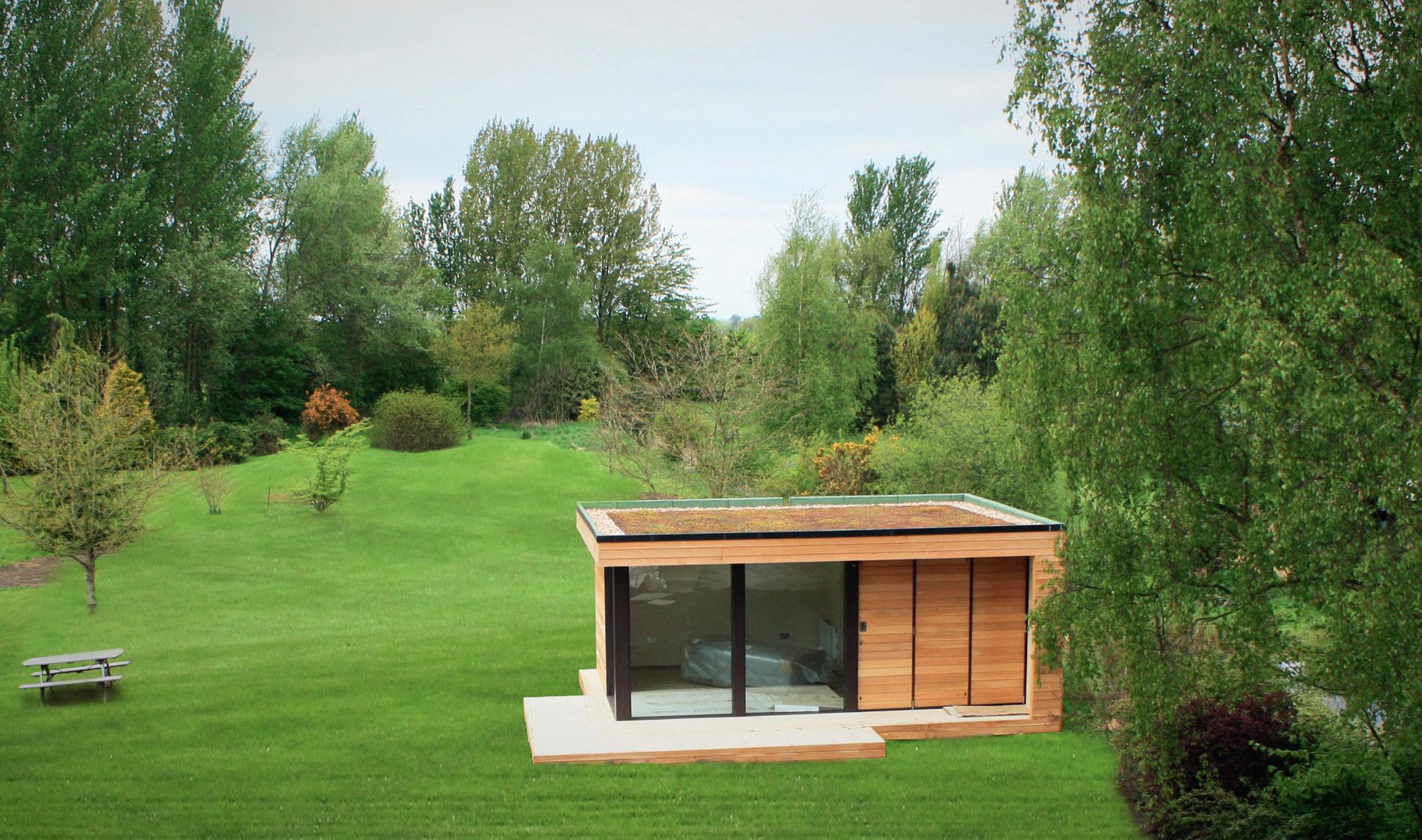


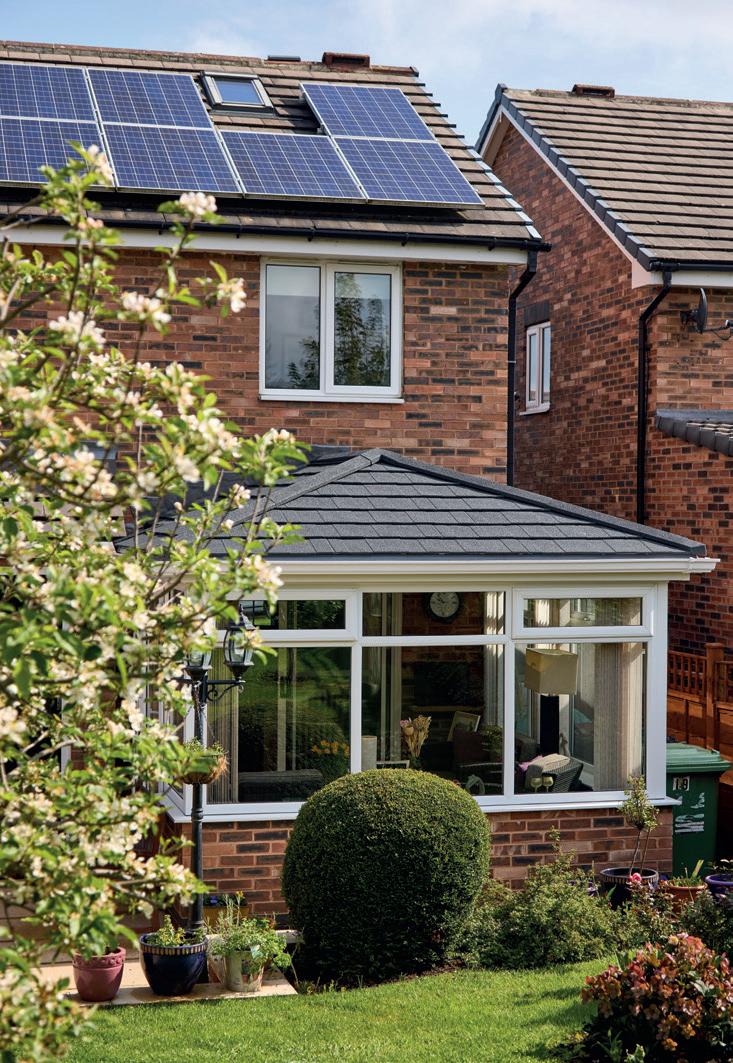
Yorkshire’s home improvement specialists, renowned for transforming old and tired conservatories into energy-efficient, stylish and versatile living spaces.

0800 625 0000
Showrooms in Rotherham and Leeds, open 7 days.
Is your conservatory leaky, draft, cold in winter and hot in summer? A tiled roof could be the answer
Aconservatory can be a great asset to a home, but traditional glass types do have their problems –commonly, they are regarded as being too cold to use in winter, and too hot in summer. There are solutions in the form of ventilation and heating options, but often the essential problem remains, that the glass (or polycarbonate) roof doesn’t help to make the conservatory liveable.
An increasingly popular option, rather than building a full-blown extension, is to upgrade the existing conservatory by adding a tiled roof. A solid tiled roof transforms your conservatory by replacing your thermally inefficient glass or polycarbonate roof with an insulated, thermally efficient alternative. With minimal cost and effort, your old and tired conservatory will become a comfortable, versatile room that you can use all year round, much like every other room in your home.
In one process, the tiled roof deals with problems from leaks, glare from sunlight and noise from rain and wind, to disturbance from wildlife. A tiled roof maintains an ambient temperature all year round, so any effort you put into heating or colling the conservatory is not wasted by a thermally inefficient glass or polycarbonate roof.
Of course, one of the attractions of a glass conservatory is that it lets in a lot of light, and if you miss that with a tile roof, there are usually options to fit a rooflight or skylights, which also offer ventilation without compromising thermal integrity.
A tiled roof will normally offer different options for the interior finishing such as plastering or cladding, and in either case will give you the opportunity to fit extra electricals for lighting, preserving the
internal brightness of the conservatory.
The cost of tiling a conservatory roof varies of course, since each job is bespoke, but a typical 4x4m Edwardian-style conservatory might cost around £18,000 to tile, with the job taking around three days. Most conservatories are suitable for the conversion, since a tile roof weighs little more than a glass roof, but a survey will be carried out first to confirm.
Thousands of homeowners across the UK are discovering the benefits of replacing their old glass or polycarbonate roof with a modern solid tiled roof, and transforming their underused space into a room they can enjoy all year round. Whether you’re looking to create a new dining area, a cosy family room, or a peaceful home office, SolarFrame’s solid tiled roofs transform old and tired conservatories into spaces you’ll love spending time in. Find out more at www.solarframe.co.uk ■


Gone are the days when a barbecue was just about flipping burgers and sausages. Today, we are embracing a much wider variety of dishes, experimenting with different techniques, and exploring global flavours. Low and slow cooking, inspired by American ‘BBQ’, has gained massive popularity, with pulled pork, brisket, and burnt ends becoming firm favourites. There’s also been a surge in interest in wood-fired cooking, with more people investing in pizza ovens and smokers to create authentic, restaurantquality dishes at home. The influence
of celebrity chefs, such as James Martin cooking on ITV’s Saturday Morning, has helped.
Another noticeable trend is the growing use of versatile, high-tech grills like pellet smokers, which offer consistency and convenience. These allow for a broader range of cooking styles, from baking and roasting to smoking and grilling, all in one piece of equipment. More people are also exploring plant-based barbecue options, catering to changing dietary preferences, with grilled vegetables, smoked jackfruit, and meat alternatives making regular appearances. You only have to watch
BBC’s Great British Menu to see the influence there.
Fusion cooking is another area where Brits are becoming more adventurous. Whether it’s South African braai, Argentine asado, or Japanese yakitori, people are incorporating international flavours into their outdoor cooking experiences
Some emerging trends and popular products include:
The days of a standalone grill are fading as more homeowners are enquiring and investing in full outdoor kitchen setups.
Urban Garden Space, based near Lichfield, runs outdoor cooking masterclasses throughout the season. Whether you’re a beginner or looking to sharpen your techniques, they’ll guide you through the fundamentals of cooking with fire. Learn how to master di erent fuels, including fire pellets, charcoal, and gas, in engaging and handson sessions. Find out more at urbangardenspace.co.uk, tel. 0121 817 3300 or email info@urbangardenspace.co.uk.
This was apparent at this year’s National Homebuilding & Renovating show in Birmingham where the number of enquiries was double that of the previous year. These spaces now include not only multiple cooking appliances but also prep areas, outdoor refrigeration, and serving stations. An outdoor fridge is becoming a must-have addition, allowing food and beverages to be stored conveniently, reducing trips inside and keeping ingredients fresh for longer.
Wood-fired cooking is still a massive trend, with pizza ovens remaining a popular choice. Home cooks are taking their outdoor entertaining to the next level by mastering Neapolitan-style pizzas, roasting meats, and even baking desserts, all with that signature wood-fired flavour. However, there are a number of gas pizza ovens coming onto the market which o er quick heat-up times, precise temperature control, and minimal cleanup. With less smoke and ash than wood-fired options, they provide a hassle-free, consistent cooking experience, perfect for e ortless outdoor entertaining and authentic pizza results.
The demand for portable, easy-to-use grills that encourage diverse cooking styles is on the rise. Consumers are looking for products that o er flexibility, allowing them to switch between grilling, smoking, and

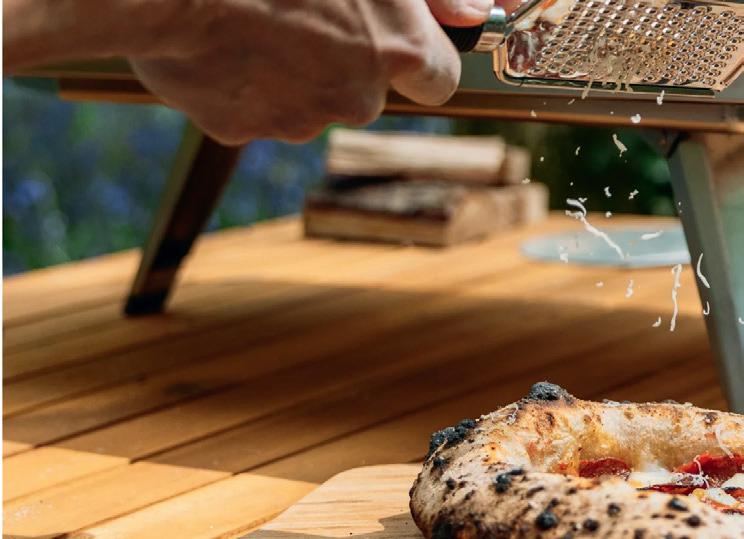

roasting without needing multiple devices. Look for brands such as Weber Traveler, Ooni Karu 12 and Traeger Ranger.
Technology is making its way into outdoor cooking, with smart thermometers, Wi-Fi-connected grills, and automated temperature controls becoming more popular. These innovations allow for greater control, consistency, and convenience, making outdoor cooking more accessible to all skill levels. Find smart technology in Traeger, Weber Meater and Kamado Joe products.
Belinda’s top tips for hosting an unforgettable outdoor gathering include:
Create a cozy, inviting space with string lights, lanterns, and comfortable seating to encourage guests to relax and linger. Consider adding a firepit or patio heater to extend the evening.
Include a mix of crowd-pleasers like


slow-cooked pulled pork or brisket, along with something unexpected - maybe a wood-fired pizza station or a dessert cooked on the grill. Don’t forget plantbased and pescetarian options. For specialist meat options (beef short rib, Jacob’s Ladder, St Louis rack of ribs etc) I purchase online from The Village Butcherthevillagebutchers.co.uk
Get guests involved by o ering build-yourown taco or pizza. This is especially fun for kids. By spreading this out across the garden, you can avoid the bottlenecks.
Ensure you’ve got the right tools like a reliable meat thermometer and highquality rubs and sauces. Don’t forget side dishes and nibbles.
Pair your dishes with refreshing cocktails, cra beers, or even smoky bourbon to complement the flavours. Make fresh lemonade with smoked lemons from the grill. Remember plenty of ice! ■
Greenhouses are a great investment, but glass designs can be expensive and fragile. That’s why the polycarbonate alternative is becoming popular
Investing in a greenhouse is one of the most rewarding decisions a gardener, hobbyist, or small-scale farmer can make. A greenhouse extends the growing season, protects plants from harsh weather, and creates a controlled environment that maximizes plant health and productivity. Whether you’re growing vegetables, flowers, or exotic plants, a greenhouse helps you beat seasonal limitations and enjoy yearround gardening.
But not all greenhouses are created equal. One of the most important decisions you’ll face when building or buying a greenhouse is the choice of covering material. While glass is the traditional choice, modern gardeners are increasingly turning to polycarbonate panels - and for good reason.
Polycarbonate panels are significantly more affordable than glass, making them a cost-effective solution for both beginners and experienced growers. Not only is the
initial investment lower, but the energy efficiency of polycarbonate adds longterm savings. These panels offer excellent insulation, which helps maintain a stable temperature inside the greenhouse. This reduces heating costs during colder months and keeps plants comfortable, especially in climates with wide temperature swings.
One of the standout features of polycarbonate is its durability. Unlike glass, which is prone to cracking or shattering under impact, polycarbonate is virtually unbreakable. It can withstand hail, heavy snow, and high winds without damage, making it ideal for areas prone to severe weather. Plus, polycarbonate panels are UV-protected, so they resist yellowing and degradation over time, meaning they maintain their clarity and performance for years.
Polycarbonate also provides better
light diffusion than glass. Instead of harsh, direct sunlight that can scorch plants, polycarbonate evenly disperses light throughout the greenhouse, promoting more uniform plant growth.
Another advantage is that polycarbonate panels are lightweight and easy to handle, making installation quicker and more manageable than heavy glass sheets – in some cases a polycarbonate greenhouse will not even need a hard base, and can be fixed securely with ground anchors. Whether you’re building a small backyard greenhouse or a larger commercial structure, this ease of use can save both time and labour costs.
In short, investing in a greenhouse is a smart way to gain control over your growing environment - and choosing polycarbonate panels enhances that investment with added affordability, resilience, and performance. It’s a choice that will keep your garden thriving and your wallet happy. ■






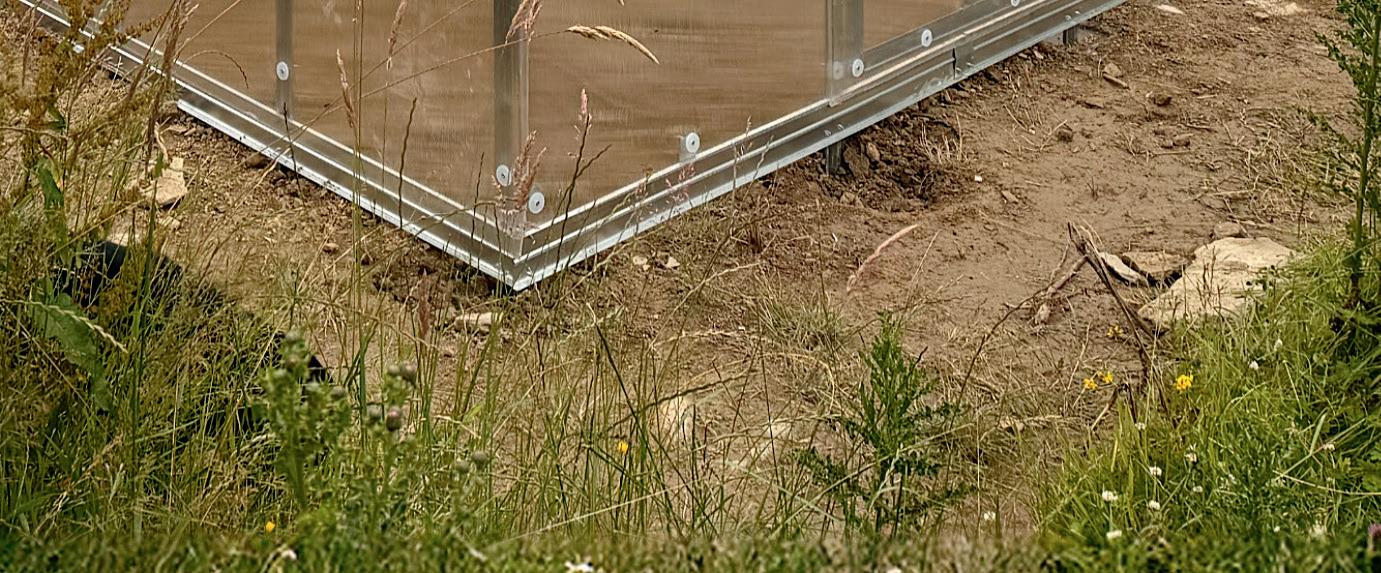



















The annual Shed of the Year Awards show just how much can be done with a humble garden building. We look at some of this year’s contenders
For 19 years, website readersheds.co.uk has been celebrating the humble garden building in the Shed of the Year competition. It’s now become a major event, with sponsors including Cuprinol and Wickes, and national press coverage. Last year’s winner was Wayne Dawber, a school art technician from Crewe, whose shed Wrinkly, Rusty and Retro soared past 160 other entrants to claim top spot, after being voted king of the ‘Unexpected/Unique’ category by the general public, and selected
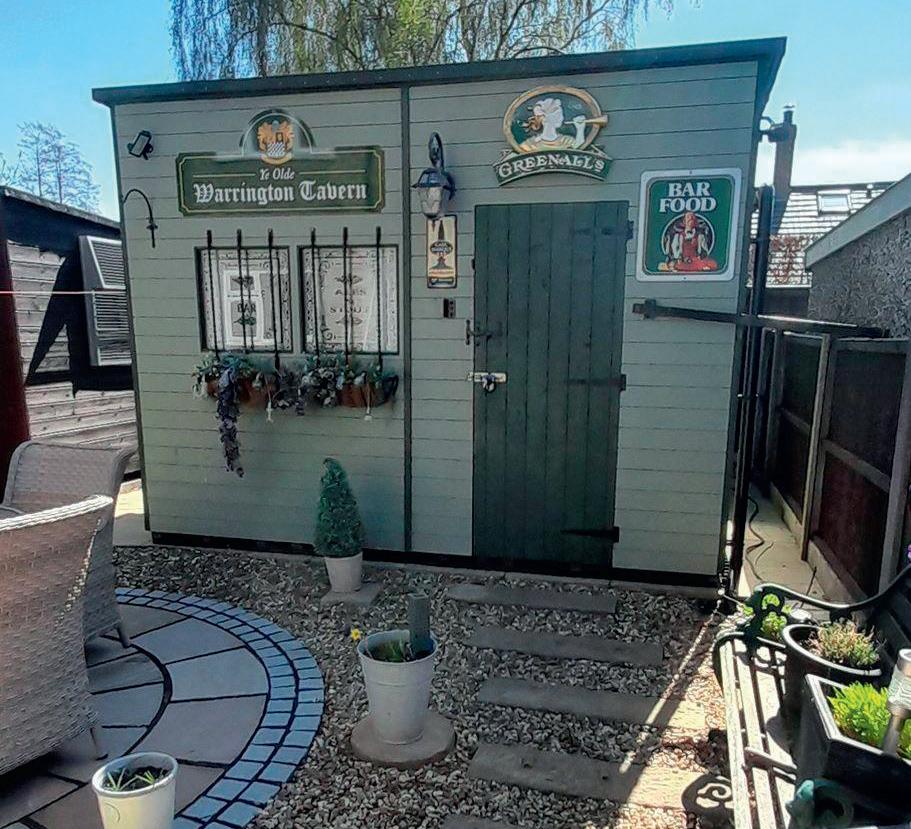

Olde Warrington Tavern, Vinnie Higham, Warrington
“It’s based on the style of an old traditional pub. It can comfortably seat seven guests and it has a mix of new and re-used materials.”
as the winner by a judging panel.
That winner was built by combining unusual and disregarded materials, such as corrugated metal from a torn-down stable roof, and windows from a recently demolished chapel. Most striking, however, were the hand-painted vintage signs in a style described as “industrial, ghost town chic” adorning the shed’s interior and exterior.
Entry into Cuprinol Shed of the Year 2025 is open to participants who submit a minimum of six images (no max) of their
Rosie, Stephanie Smith, Greater Manchester
“It’s a perfect little get away at the back of the house for me to retreat to and craft. Even though it’s just a few feet away from the house it has a totally different, relaxed calm vibe.”
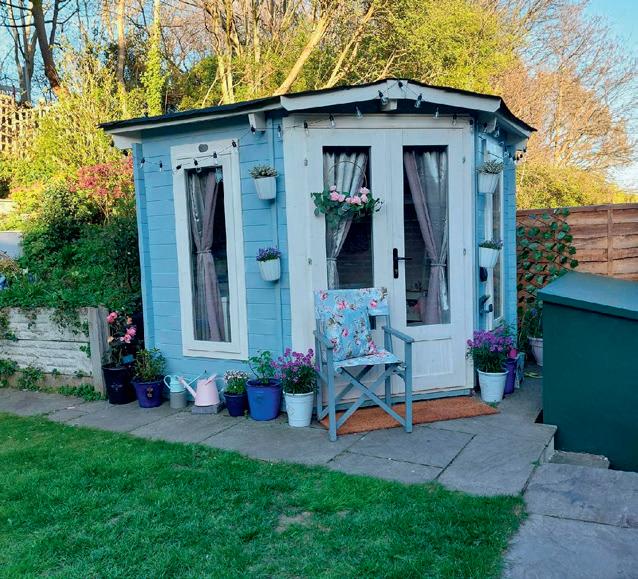

sheds, along with detailed text about their sheds by the closing date of Saturday May 31st 2025. Prizes include £1,000 in cash and £250 worth of Cuprinol products, and an exclusive nature’s getaway experience (worth up to £500).
A panel of judges will select an initial shortlist of sheds. Next, a public vote will be held on the website to find the category winners. A final judging panel will then select the overall winner of Cuprinol Shed of the Year 2025.
This year’s entries so far include:
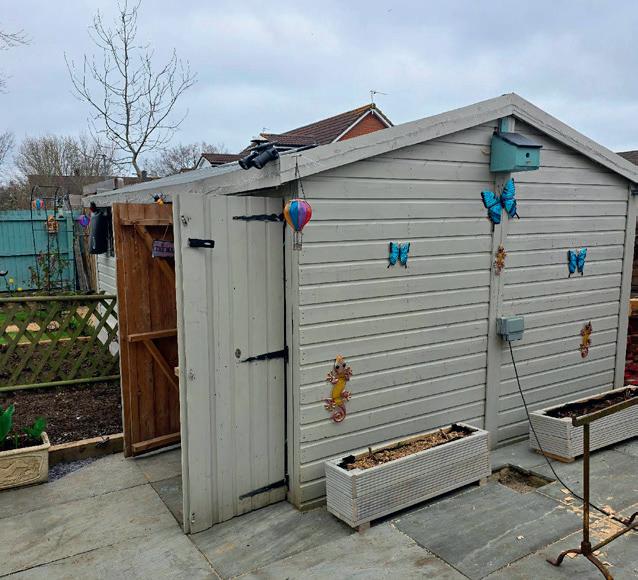

Tony’s Shed, Anthony Rickards, Swindon
“It’s my hobby shed where I do all my odd jobs from, and I spend most of my time in it building lots of different things – so I can keep working through the winter, it has a fire in it!”
The Station, Sharon Cropley, Suffolk
“The previous owner of our property, a train driver, built a very large shed for a model train layout. As new purchasers of the property we realised the use of the space for entertainment and got to work. We have named the pub shed The Station in honour of the train driver. Everyone we know loves our shed! We have had birthdays, hen do’s, Christmases, and football days in it.”


Luker’s Own Junkyard, Tristan Luker, Gravesend
“Our shed isn’t just a bar, it’s a neonlit homage to all things 80’s and 90’s! With every visit you see something new that you didn’t see before that evokes childhood memories that you had long forgotten existed. It’s our little Junkyard of memories.”
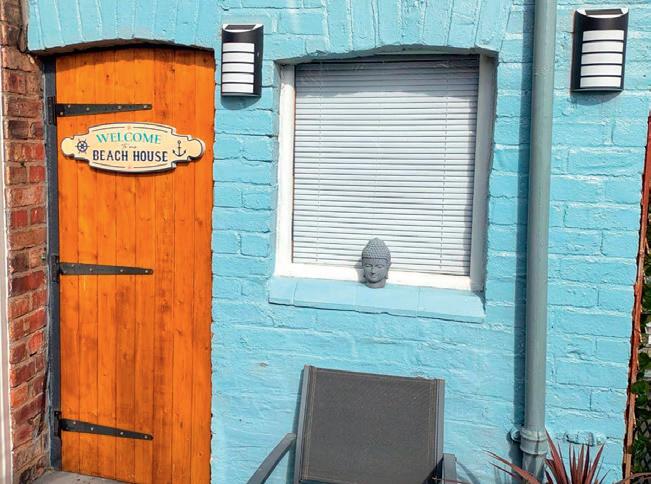
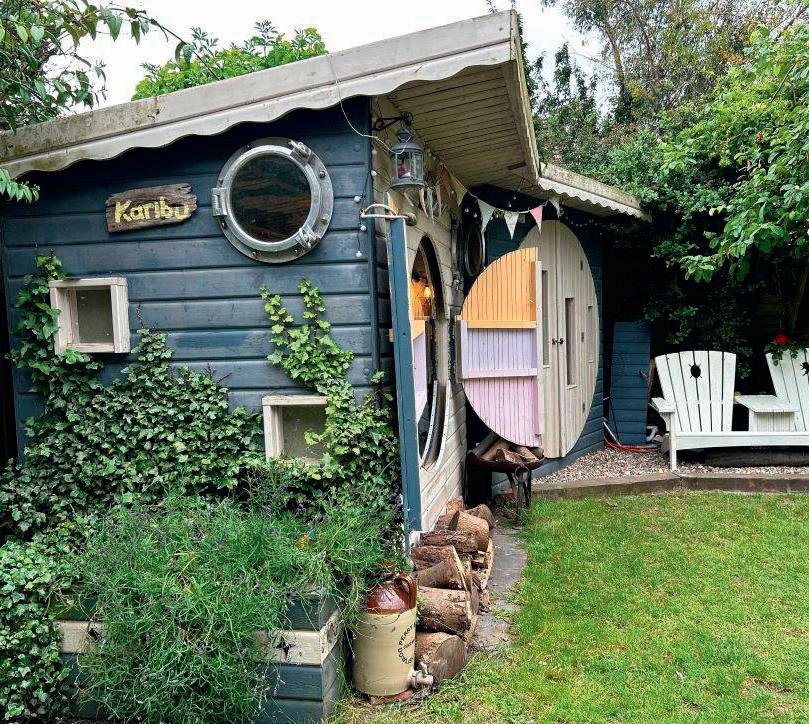
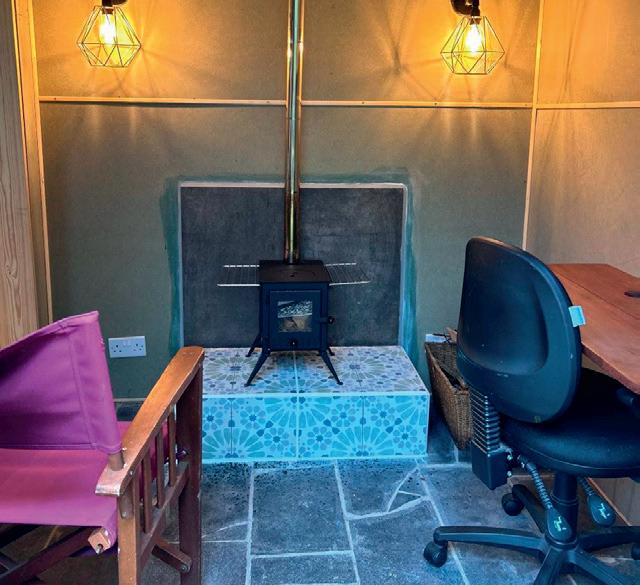
Play Pod, Neema Young, Cambridgeshire
“The Play Pod has had a makeover from 2014 when it was built, it has been repurposed so children can now chill in it, an adult can sleep in the sofa bed, there’s office space for someone to work, and you can enjoy the fire on chilly nights.”

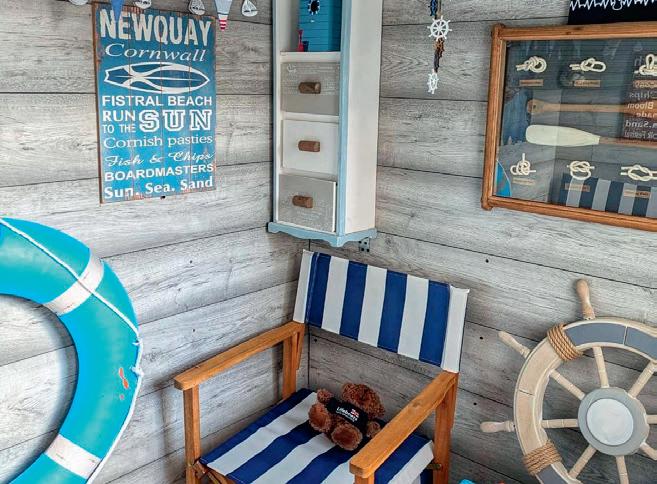
The Photography Studio, Kerryanne Crane, Suffolk
“My shed is special because it’s helped me start up my photography business. I was previously just a carer to my autistic son, and now I have my own business. Having it in my garden means I get to work from home. I opened in January and have had lots of photoshoots in it already! It’s also my little getaway when I need a bit of peace!”

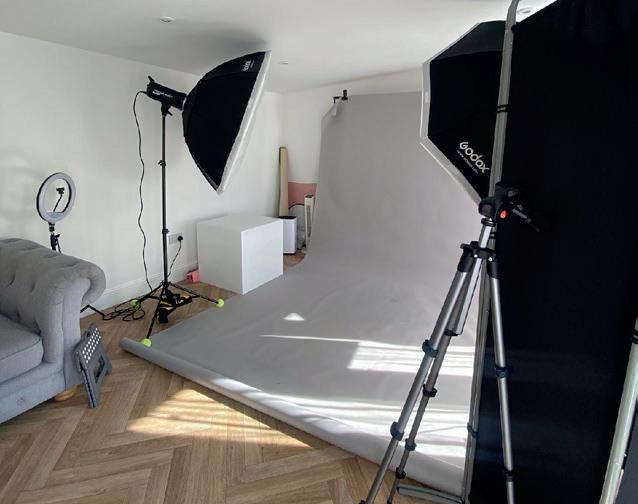

Seaside Sanctuary, John Cullen, Merseyside
“Everybody that has visited the Seaside Sanctuary so far has been blown away to find a piece of the seaside just a stone’s-throw away from one of the city’s busiest roads. Especially as the building was originally an old outside toilet, built in 1911 in a traditional back yard of a terraced property.” ■
Choosing the right decking material, understanding installation techniques, and learning how to maintain it are crucial steps to enjoyment
Decking is a popular choice for garden design, offering a versatile, stylish, and functional way to enhance outdoor spaces. The first decision to make when installing a garden deck is the type of material. The most common options are wood, composite decking made from a blend of wood fibres and plastic, or ceramic decking such as EXADECK.
Wooden decking remains a classic choice for many homeowners due to its natural appearance and traditional appeal. Options include pressure-treated softwoods like pine, cedar, and redwood,
and hardwoods such as sapele and oak. Wood can be beautiful and relatively affordable, but requires more maintenance over time, including sealing, staining, and protection from the elements.
Composite decking is made from a blend of wood fibres and plastic, offering a more durable, low-maintenance alternative to traditional wood which is more resistant to rot, splintering, and fading.
Ceramic decking does not absorb water, so it is impervious to warping, rot, mould, sea-salt, and extreme temperatures including frost and high humidity. Ceramic decking does not expand, contract,
or move, and its low water absorption factor minimises bacterial growth. The vitrification process used in manufacture provides fire resistance, and rectified boards with guaranteed straight edges make it much faster and easier to install and measure, with minimal rocking and wastage.
Proper installation of decking is key to ensuring a long-lasting result. Cutting and fitting decking boards require precision and the right tools. For wood decking, a circular saw with a fine-tooth blade is ideal


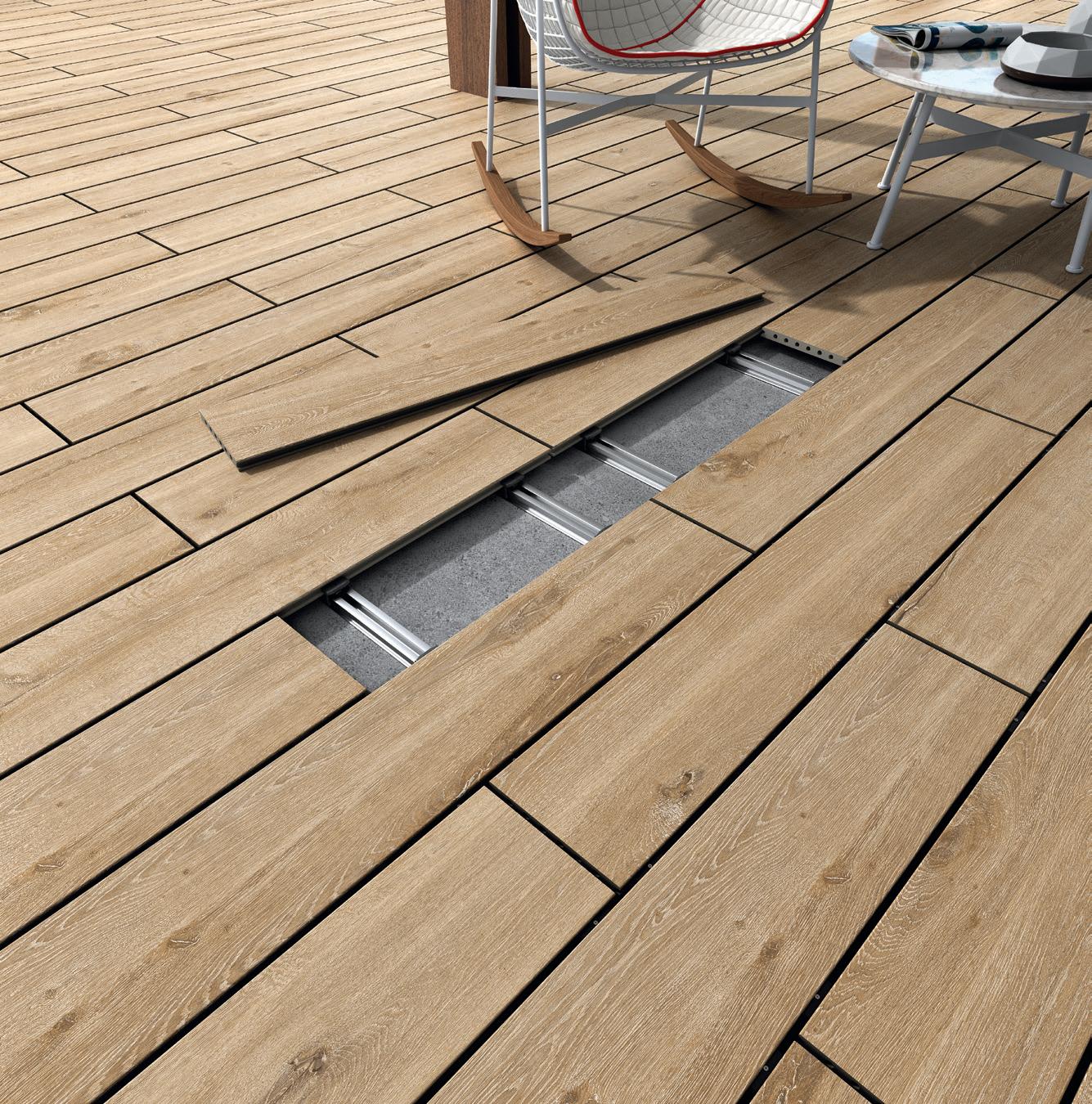
The base frame of a deck plays a critical role in its stability and longevity. For the framework, pressure-treated timber is commonly used due to its strength and resistance to rot. However, when building a frame for composite decking, it’s important to ensure that the frame is also made from materials that are resistant to moisture, such as treated timber or aluminium, to prevent warping and decay.
for cutting boards. For composite decking, a jigsaw or circular saw will also work, using a blade suited for cutting plastic materials. Ceramic EXADECK is faster to install than any other type of decking. Unlike timber and composite boards, which can swell or warp, ceramic decking’s rectified edges and ultra-low absorption rate mean less cutting, fewer issues, and faster fitting and access.
When securing decking boards, there are two primary options: clips and screws. Screws are used to secure the boards directly to the frame - stainless steel screws are the most common choice, as they resist corrosion. Decking clips are an alternative, especially with composite decking, as they allow for a clean, screw-free surface.
Safety is an important consideration for any deck, particularly when wet conditions are common. Slip-resistant decking is designed with textured surfaces or grooves - EXADECK for instance has a high R12 slip rating making it ideal for family settings.
In areas prone to wildfires or where fire safety is a concern, particularly near barbecues and fire pits, non-combustible decking, such as aluminium or ceramic, will be the best choices. EXADECK ceramic decking is designed for penthouses, meeting A1 fire regulation standards.
For wood decking, regular cleaning with a mild soap solution and a so -bristled
If you are tired of decking that fades, stains, rots or warps, EXADECK Ceramic Decking is the future of durable outdoor living. Designed to withstand stains, fading, seasalt and harsh weather, it features a safe, non-slip surface, and o ers a luxurious, eco-friendly solution with minimal upkeep.
Ideal for countryside, city and coastal homes, EXADECK creates stunning, sustainable outdoor spaces - without the maintenance headaches of wood or composite. www.abbuildingproducts.co.uk
brush is essential. Avoid harsh chemicals that can damage the wood or its finish. To prevent rot, ensure the deck is regularly treated with wood preservatives.
Composite decking requires less maintenance but benefits from occasional cleaning with a gentle detergent or dedicated composite deck cleaner to remove dirt and debris. Avoid using a pressure washer, which can damage the surface. Ceramic decking ls specifically engineered for life outdoors, requiring no sealing or painting and virtually no maintenance
The lifespan of your decking depends largely on the material used. If not properly maintained, composite decking may need to be replaced after 2-5 years, as it’s susceptible to damage from moisture and insects; but if wellmaintained, traditional wood decking can last 10 to 20 years.
Composite decking generally o ers a longer lifespan, with some brands promising up to 25 years or more of durability, especially if they are capped with a protective layer; while vitrified ceramic decking is said to have the potential to last 1,000 years, though we won’t be around long enough to check! ■

Eco-friendly & Sustainable
Award-winning sustainability from cradle-to-gate, EXADECK is the product of choice for eco-conscious consumers of today.
EXADECK is 100% recycleable and contains up to 41% recycled material.
Resistant to extreme temperature changes, from frost to high heat and humidity. The vitri cation process makes EXADECK totally frostproof. It is comfortable to walk on in bare feet in high sun, so your deck is usable all year-round.
EXADECK is stain resistant and UV resistant. It does not shrink or swell in heat or humidity, and with <0.5% water absorption, there is no risk of warping and rotting. It requires no ongoing treatments, so it’s one less thing to worry about.

You can safely use EXADECK in BBQ and re pit areas. Keep your family safe with peace of mind. Unlike composite boards, EXADECK won’t melt or become re-damaged from re sparks.
Got kids and grandkids running around on decking in bare feet? It has a high anti-slip grip, with a rating of R12, and is designed for swimming pool areas.
Unlike wood, composite, bre cement board and aluminium decking, EXADECK will be the same colour in 1000 years’ time, and requires no paint or sealers. EXADECK is ideal for properties in coastal towns, where salt spray impacts decking.
AB Building Products has been supplying innovative, cutting edge products to the market since 1988.
EXADECK Ceramic Decking is exclusively available from AB Building Products. Now available to buy online.
Request free samples on our website; scan the QR code to learn more.



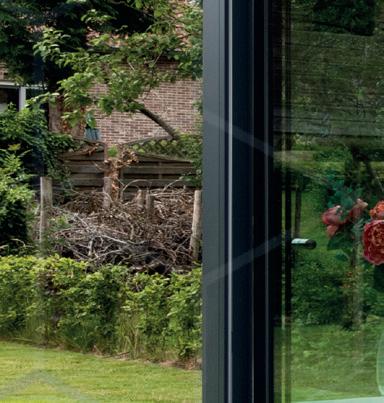

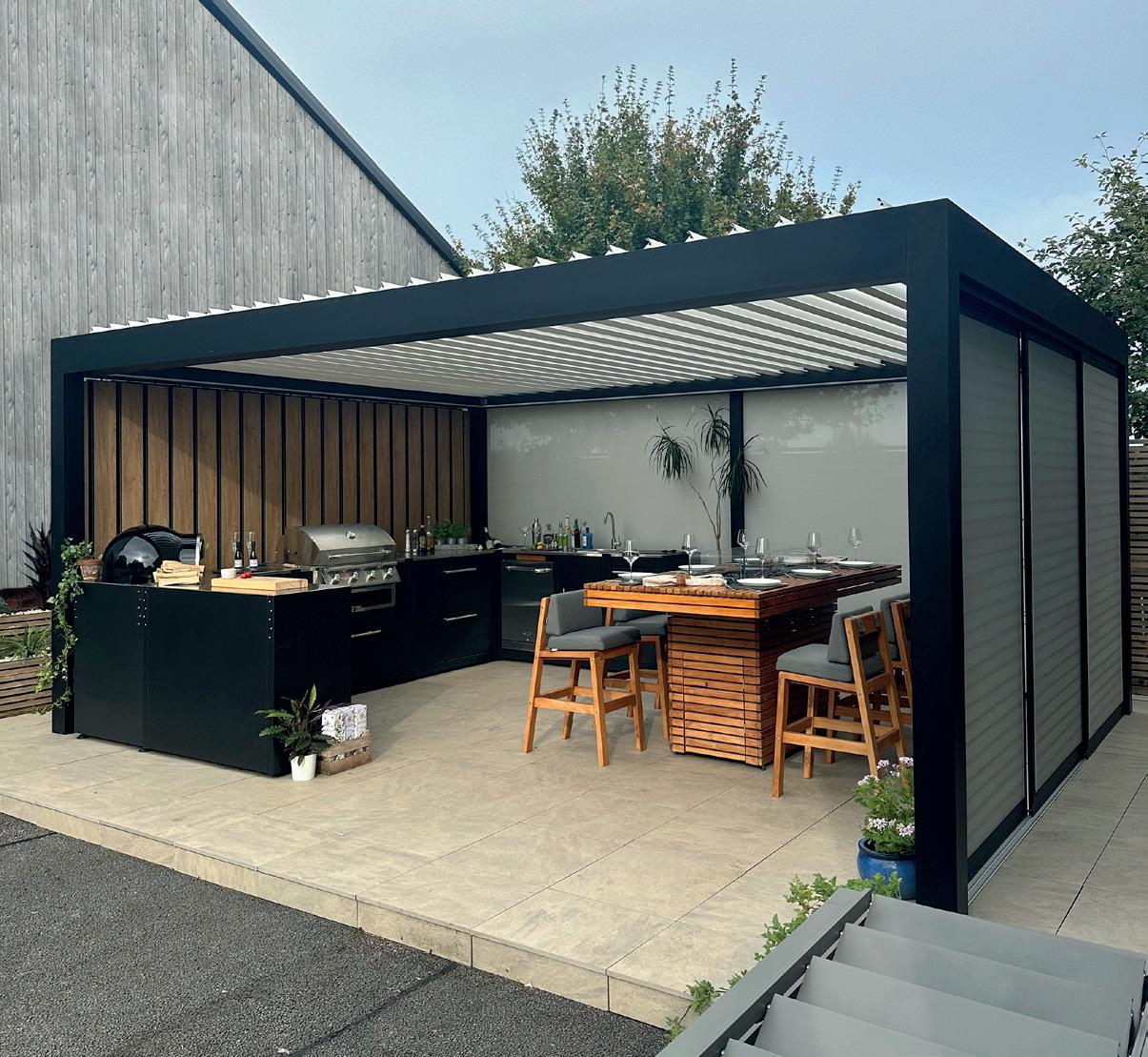
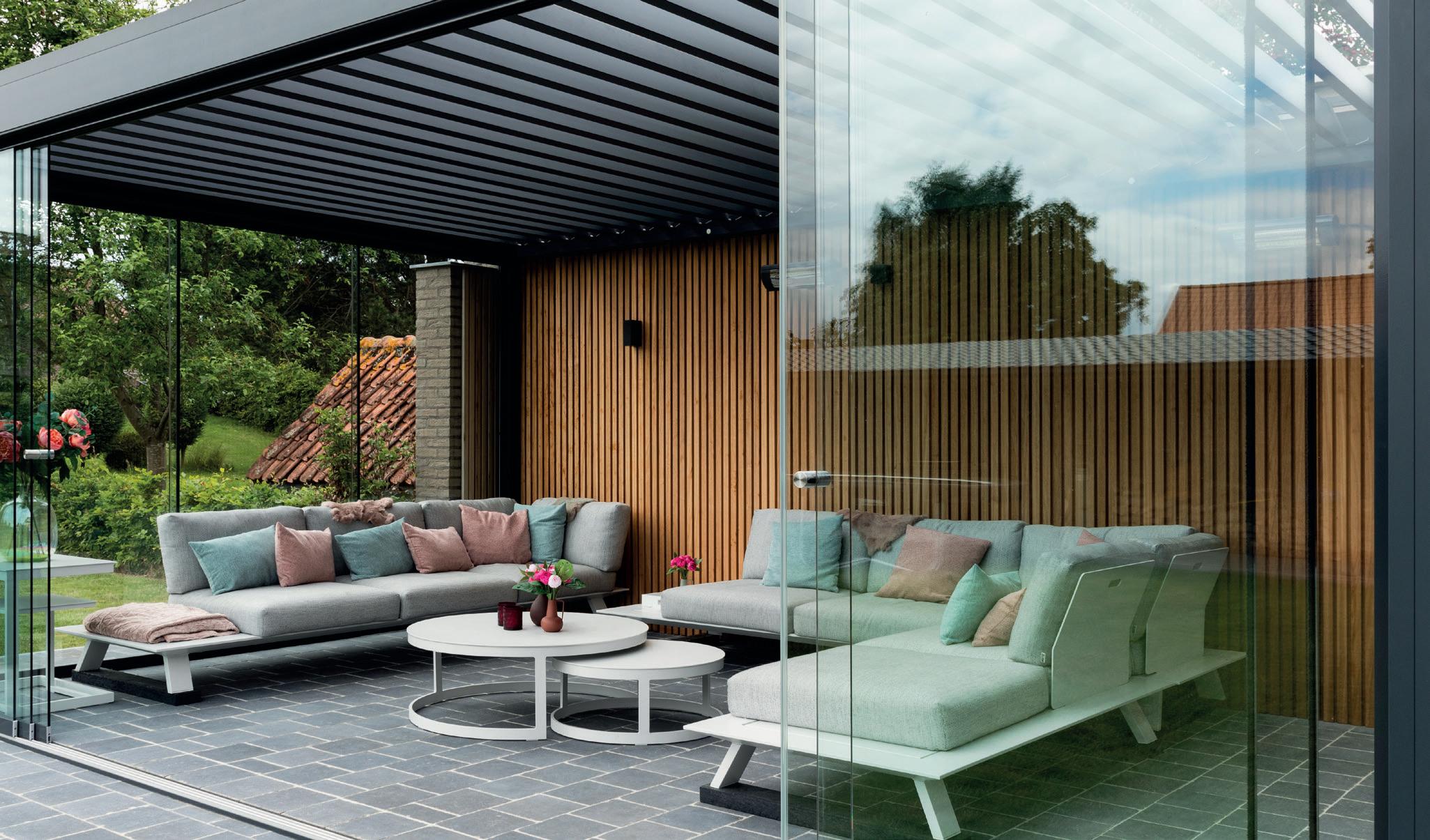
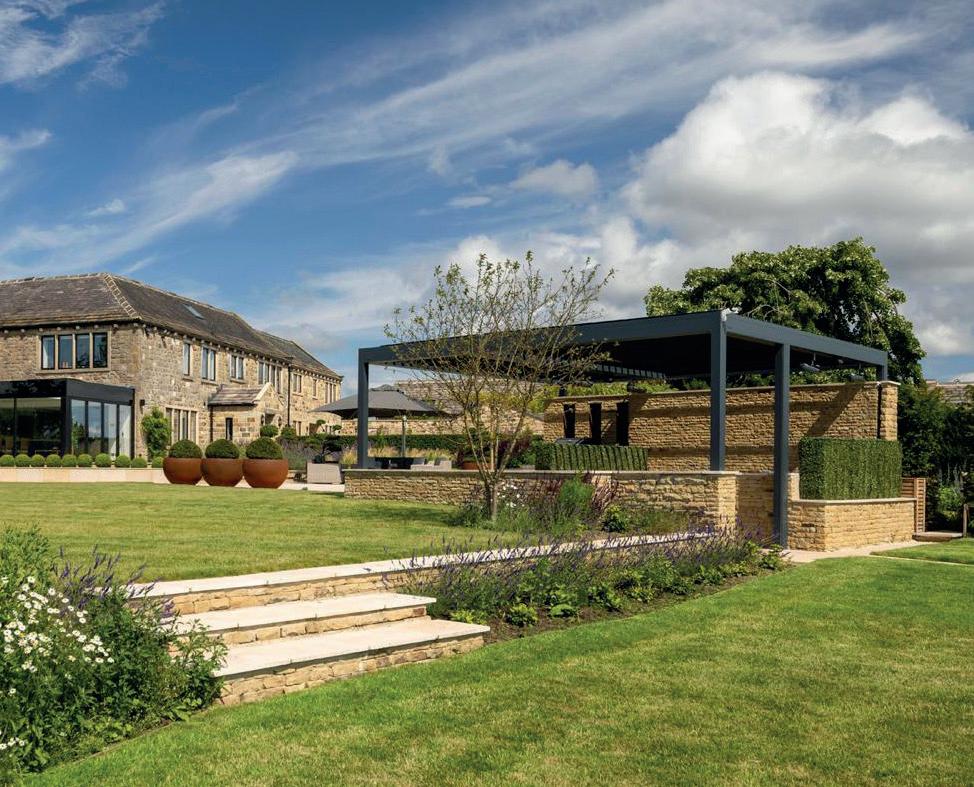










While wooden, metal or brick garden rooms have their place, a glass structure o ers the advantage of blending the comfort of indoors with the enjoyment of nature.



Glass garden structures usually have an aluminium framework, so they are as sturdy and durable as other construction methods, yet they usually require no planning permission. Certain properties, such as apartments, flats, maisonettes, listed buildings, or homes located in conservation areas, will require planning permission for a glass veranda.
Glass structures are also cost e ective, o en coming in a lot cheaper than traditional extensions, and can be erected


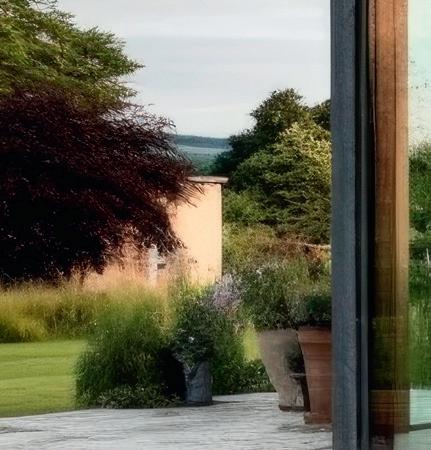


in a couple of days. One reason for this is that they o en do not require a traditional concrete foundation. They can be designed as freestanding or lean-to structures.







Glass rooms can be designed to blend seamlessly with existing architecture, so they are not limited to being used only around modernistic structures, though features such as minimalist frames, large glass panels, and integrated technologies like automated blinds and LED lighting are particularly good at creating a chic and functional space.
There are many options for access, glazing, shading, lighting, heating and ventilation in glass rooms, so they are perfectly suitable for a wide range of applications from a home o ice to a gym or




Could glass structures be an alternative to wood or metal for garden rooms? They certainly have advantages in terms of looks and utility
a studio, or guest accommodation. If you have an existing patio, constructing a glass room around it is a quick and easy option to provide an additional living space suitable for anything from relaxation and reading to dining and parties.



There are many di erent design options for glass structures, from a simple pergola, which provides partial coverage while allowing natural light to filter through, to a fully enclosed room; in between there are options including a combination roof, which blends fixed glass panels with louvred or retractable sections, o ering the benefits of both shelter and an outdoor feel. Pitched or flat roofs are also available.

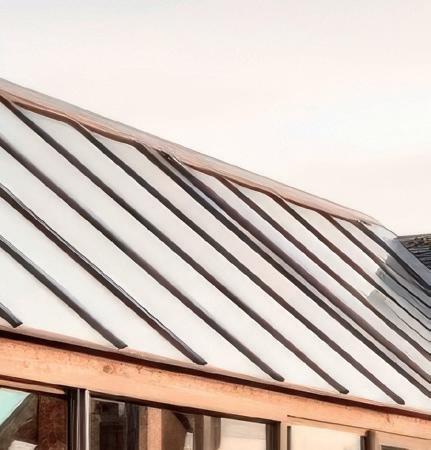

Another benefit of glass rooms is improved energy e iciency. Because glass rooms allow increased natural light into your home, you will likely find that you can reduce your reliance on artificial lighting. In addition, if you have a south-facing home, solar gain can be a great way to heat your home during the winter - this will also help keep your energy costs down. ■
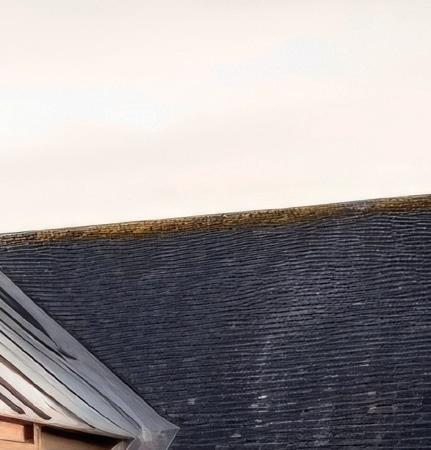
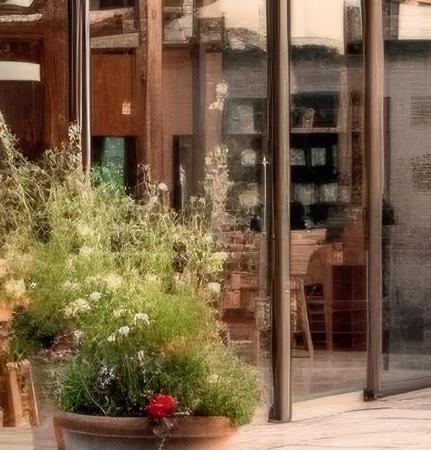







We all think about interior design, but should you put as much thought into garden design?
For many homeowners, the garden has become a natural extension of their living space, as well as providing ‘kerb appeal’ (or maybe that should be ‘verge appeal’) that adds to the value of your property.
With thoughtful design, your outdoor areas can be a lot more than just a lawn to mow and a bench to sit on; you can create a serene retreat, an entertainment zone, or just a family-friendly space for children and pets to play. The benefits to both the value of your home and your wellbeing can be immense.
Of course, in the UK, there’s always the problem that cold and rain will wash out a whole season, so it’s important to plan a garden with year-round appeal. Gardeners know the trick of combining evergreen and perennial plants to get year-round interest
– so your overall garden plan should also cater for all seasons. There are many ways this can be done, with garden structures, lighting, and different uses of space.
One popular move is to merge indoor and outdoor spaces, so for instance your kitchen might have large glass doors which open onto a patio dining area, and you might have a separate area for a firepit. Look at different types of material which can be made to blend, such as composite decking and natural stone slabs.
It’s worth thinking about the flow of a garden’s design, creating different zones for activities such as reading, play, dining or parties, using partitions, hedges and water features. You should aim for a combination of openness and privacy, defining gravel or
bark pathways between zones using edging. Your planting scheme can also help to define different zones, combining striking trees and shrubs with sweet-smelling plants such as lavender to provide a year-round sensory experience.
Remember the importance of sustainability in your garden planning; make sure that surfaces are permeable to rainfall, plant species that are friendly to pollinators, and perhaps leave a wild area to encourage biodiversity.
The professional expertise of a garden designer will help you to maximise your space, and remember the importance of regular maintenance to keep everything in shape. In this way a well-designed garden becomes a focal point for relaxation and connection, as well as being a valuable asset to your home. ■






At MRLandscapes, we don’t just design gardens – we create breathtaking outdoor spaces that elevate the beauty and functionality of your home. Whether you dream of a serene garden retreat, a vibrant space for outdoor entertaining, or a complete transformation, our expert team crafts personalised designs that bring your vision to life.










Our Services Include:
• Custom Landscaping Designs
• Outdoor Space Transformations
• Garden Maintenance & Care

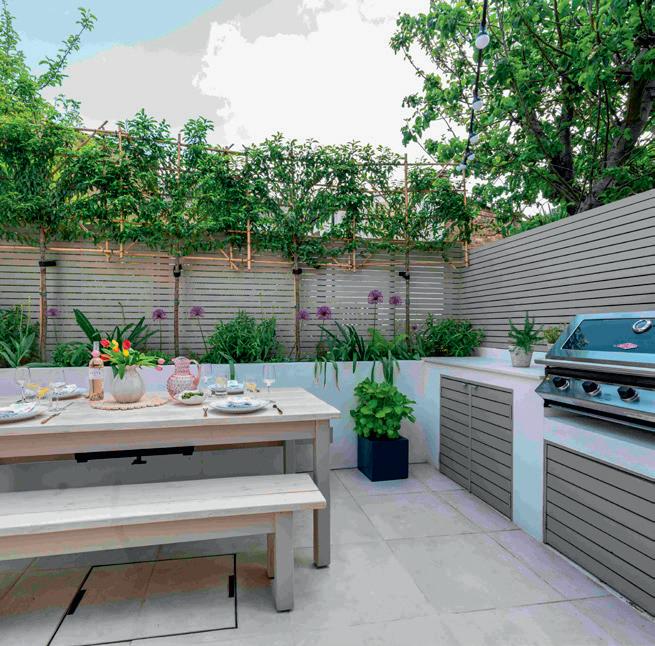
With years of experience and a passion for exceptional, sustainable design, MRLandscapes is the trusted choice for homeowners who demand quality, creativity, and a lasting impact.
Make your outdoor dreams a reality with MRLandscapes. Call us now to start planning your dream garden.

Martin suggests that a lack of new housing, a glut of properties in need of a refurb, and an unengaged workforce could all be solved in a single stroke
Alittle while ago, I asked my 17-year-old son’s friends if they would like to help me put up a fence in the garden of the property I’m currently renovating. Sure enough, four of them came along for five hours, and I taught them all the tricks of the trade for doing this job in a time effective and professional looking way. They enjoyed it so much that they are
now talking about doing it for others at the weekend. I think the penny dropped that there’s a huge demand for people who can do simple DIY and house maintenance projects, and not only could this be fulfilling for them, but it could be a nice little income generator.
I decided to put a post about it on my Twitter (X) account, and to date it’s had 381,000 views, 13,000 likes and 331
comments! It seems that many people agreed with my thoughts, that pushing practical training and apprenticeships can have such a positive impact on young adults.
It’s been a major driver for my pub renovation project in South Wales since the start - and we’ve so far given over 50 young adults aged 15-17, some with special needs, the chance to get industry
recognised construction qualifications. The impact on them, their families and friends cannot be understated. It is, quite simply, life-changing.
So, it strikes me that there’s a blindingly obvious connection to be made and opportunity to be pushed here.
As you might be aware, labour costs have spiralled upwards - especially in the building trade - and, amongst other things, this is prohibiting councils from renovating housing stock that does not meet current standards.
But why aren’t we doing more to refurbish existing properties to make up for the shortage of new builds? Refurbishing existing properties to address the housing shortage seems like a logical solution, but several factors limit its effectiveness as a large-scale alternative to new builds:
Cost of Renovation: Many older properties require significant investment to meet modern living standards and energy efficiency regulations. Upgrading insulation, electrics, plumbing, and heating systems can be as expensive as building new homes.
VAT Disincentives: Currently, renovation and refurbishment projects attract a 20% VAT rate, whereas new builds are zerorated. This creates a financial disincentive for developers to refurbish rather than demolish and rebuild.
Unsuitable Housing Stock: Much of the UK’s older housing stock, particularly in northern towns and cities, consists of small, outdated, or poorly designed homes that may not meet modern needs.
Planning Restrictions: Local planning rules and conservation area regulations can make refurbishment projects more complex and time-consuming than new developments.
Fragmented Ownership: Many rundown properties are privately owned, and securing agreements to refurbish multiple properties in an area can be difficult.
Long-Term Vacancy Problems: Some properties, particularly in areas which are in economic decline, remain empty because they lack local demand, rather

than just needing refurbishment.
New Builds Are More Profitable: Large developers tend to favour new builds over refurbishments because they offer economies of scale, predictable costs, and higher returns.
Lack of Government Incentives: While schemes like grants for retrofitting homes exist, they are often targeted at homeowners rather than large-scale developers, limiting their impact.
In a Nutshell: While refurbishment has an important role in tackling the housing crisis, it’s unlikely to replace the need for significant new development, particularly in high-demand areas.
On the other side of the virtuous equation is a potential army of currently disengaged youngsters who desperately need direction, purpose and a road map out of their current set of fairly dismallooking options.
So, how much effort would it take to coordinate a countrywide apprenticeship
programme, that taught these youngsters basic building skills, and then engaged them on a programme of bringing back to use all the currently dormant housing stock that’s out there? They would need proper supervision and training in all aspects of safety and professional skills, but from my experience they would be eager to learn and extremely motivated to undertake the tasks at hand.
The Hendrewen pub has provided a template for how it might work, and judging by the comments to my post on X, many people are in agreement that this is nothing but an extremely good idea.
So I just need to think about putting together the infrastructure to enable this to happen in a coordinated way, and I guess I need to speak to relevant people in national and local governments and also the councils, to help them understand the win:win benefits.
OK, I’ll add it to my ‘To Do’ List, and try to shuffle it to the top, as I know what an important initiative this could be. Any thoughts, please get in touch! ■

Join iHowz today and get the expert support you need to stay ahead of the changes
The Renters Rights Bill is set to bring the biggest shake-up to the private rented sector in a generation –abolishing Section 21, introducing new grounds for possession, and strengthening tenants’ rights. For landlords, the landscape is changing fast.
Now more than ever, landlords need protection, clarity, and support. That’s why thousands are turning to iHowz.
iHowz is the UK’s longest-established independent landlord membership organisation, offering unrivalled guidance and representation for landlords of all sizes.
What’s in the Renters Rights Bill?
• Section 21 “No-Fault” evictions abolished
• No more Fixed Term tenancies
• A new Decent Homes Standard for the private sector
• Expanded tenant rights, including the right to a pet
• Changes to possession grounds and notice periods
What does that mean for you?
Without expert advice and up-to-date information, landlords risk falling foul of new laws – leading to delays, fines, or costly court cases.
That’s where iHowz comes in...
As an iHowz member, you’ll get:
• FREE landlord helpline access to expert legal and tenancy advice – on evictions, possession, rent arrears, and more
• Step-by-step guidance on adapting your tenancies to comply with the new rules
• Templates and documents updated in line with new legislation
• Early alerts and briefings on when the new laws take effect
• Advocacy – iHowz is actively engaged with policymakers to protect landlord rights
• Community and support through webinars, Q&As, and local forums
• Get FREE Tax Investigation Insurance – worth £200
Don’t wait for the law to change – be ready.
Visit www.iHowz.uk to join today.
Or call our friendly team on 01732 56 56 01 for more information.
The rules are changing. Make sure you’re ready. Join iHowz.


